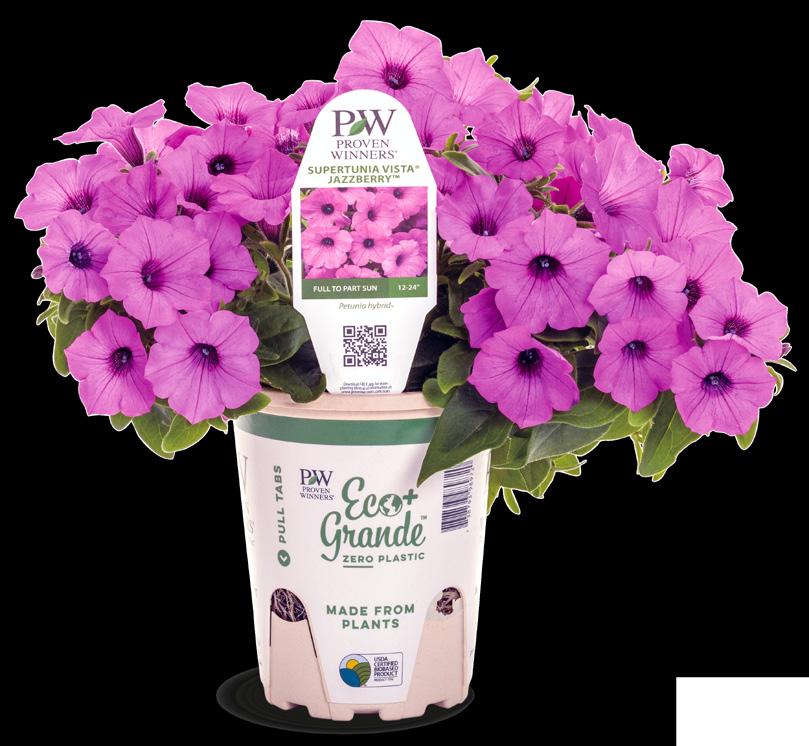








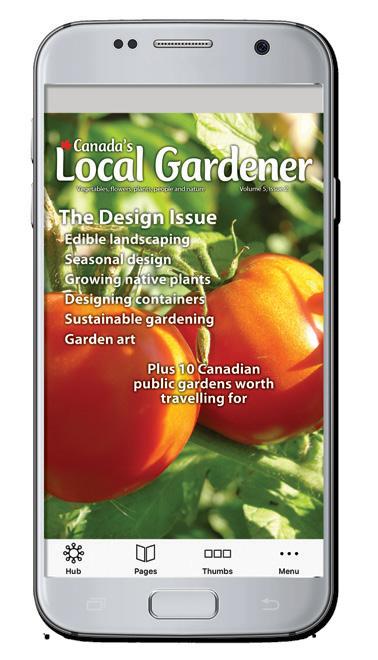

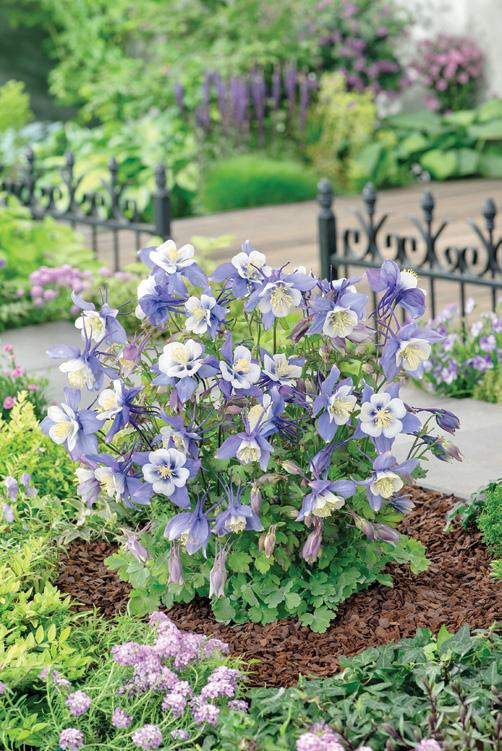






Michael Rosen retired in 2020 as President of Tree Canada, where he led its transition to private sector support and facilitated the Canadian Urban Forest Network, Canadian Urban Forest Strategy, National Tree Day and the planting of over 80 million trees. He now consults to environmental companies, landowners and NGO’s under Consultation Michael Rosen. He does presentations, and authors articles on various subjects. A Registered Professional Forester and Certified Arborist, he has a B.A.(Hons) in History from Trent University, a B.Sc.F. from the University of Toronto and has been an Adjunct Professor at the University of British Columbia since 2016. He serves on the boards of numerous environmental, forestry, arboricultural and historical organizations, lives in the Outaouais region of Quebec and received the Canadian Forestry Achievement Award from the Canadian Institute of Forestry in 2020. His pastimes include making maple syrup, wood working, cross-country skiing, canoeing, travel and of course, gardening.
Michael Rosen, R.P.F., Cert.Arb., TRAQ Mikerosen95@outlook.com


Follow us online www.localgardener.net
Facebook: @CanadasLocalGardener
X: @CanadaGardener
Instagram: @local_gardener
Pinterest: @LocalGardenerMag
YouTube: @LocalGardenerLiving
Published by Pegasus Publications Inc.
President dorothy dobbie dorothy@pegasuspublications.net
Editor & Publisher shauna dobbie shauna@pegasuspublications.net
Art Direction & Layout
Karl Thomsen karl@pegasuspublications.net
Contributors
John Barrett, dorothy dobbie, shauna dobbie, Heron Hanuman, Linda Langelo, Tara Matheson, Gail Murray, Joan Quinn, Michael rosen and Karen Thomas.
Editorial Advisory Board
Greg auton, John Barrett, Todd Boland, darryl Cheng, Ben Cullen, Mario doiron, Michel Gauthier, Mathieu Hodgson, Jan Pedersen, stephanie rose, Michael rosen, aldona s atterthwaite, and Trudy Watt.
P rint Advertising
Gord Gage • 204-940-2701 gord.gage@pegasuspublications.net
Digital Advertising Caroline Fu • 204-940-2704 caroline@pegasuspublications.net
Subscriptions
Write, email or call Canada’s Local Gardener P.O. Box 47040, RPO Marion Winnipeg, MB R2H 3G9 Phone: 204-940-2700 info@pegasuspublications.net
One year (four issues): $35.85
Two years (eight issues): $71.70
Three years (twelve issues): $107.55
Single copy: $12.95 Plus applicable taxes.
return undeliverable Canadian addresses to: Circulation department
Pegasus Publications Inc. PO Box 47040, RPO Marion Winnipeg, MB R2H 3G9
Canadian Publications mail product Sales agreement #40027604
ISSN 2563-6391
Canada’s LoCaL Gardener is published four times annually by Pegasus Publications Inc. It is regularly available to purchase at newsstands and retail locations throughout Canada or by subscription. Visa, MasterCard and american express accepted. Publisher buys all editorial rights and reserves the right to republish any material purchased. reproduction in whole or in part is prohibited without permission in writing from the publisher.
Copyright Pegasus Publications Inc.
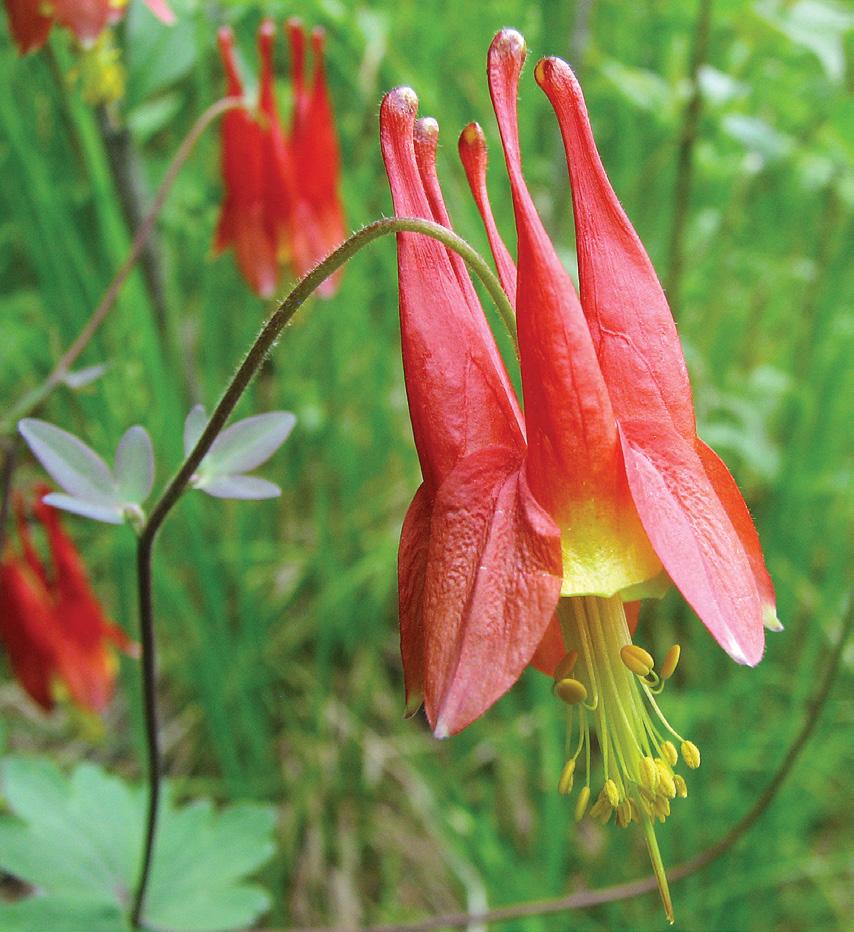
Ah, the columbine! With its quirky, nodding blooms on wiry stems, this garden favourite is like a whimsical character straight out of a fairy tale. Whether you're a seasoned green thumb or a budding garden enthusiast, here’s your guide to sprinkling a little columbine magic across your garden patch.
Imagine a quaint nook in your garden, where the morning sun gently warms the earth and the afternoon shade provides a cool retreat. That’s where your columbine will sing! It’s a plant that doesn’t fuss much over its position but does relish a spot that shields it from the harsh midday sun, especially in the toastier parts of the country.
The secret to great columbines starts with the base – your soil! These flowers thrive in earth that's rich and crumbly. Mix in a hearty helping of compost to make that soil fertile. A tad acidic or just plain neutral pH does the trick, letting your columbines settle in comfortably.
You can start your columbine journey with seeds, either tucked into the
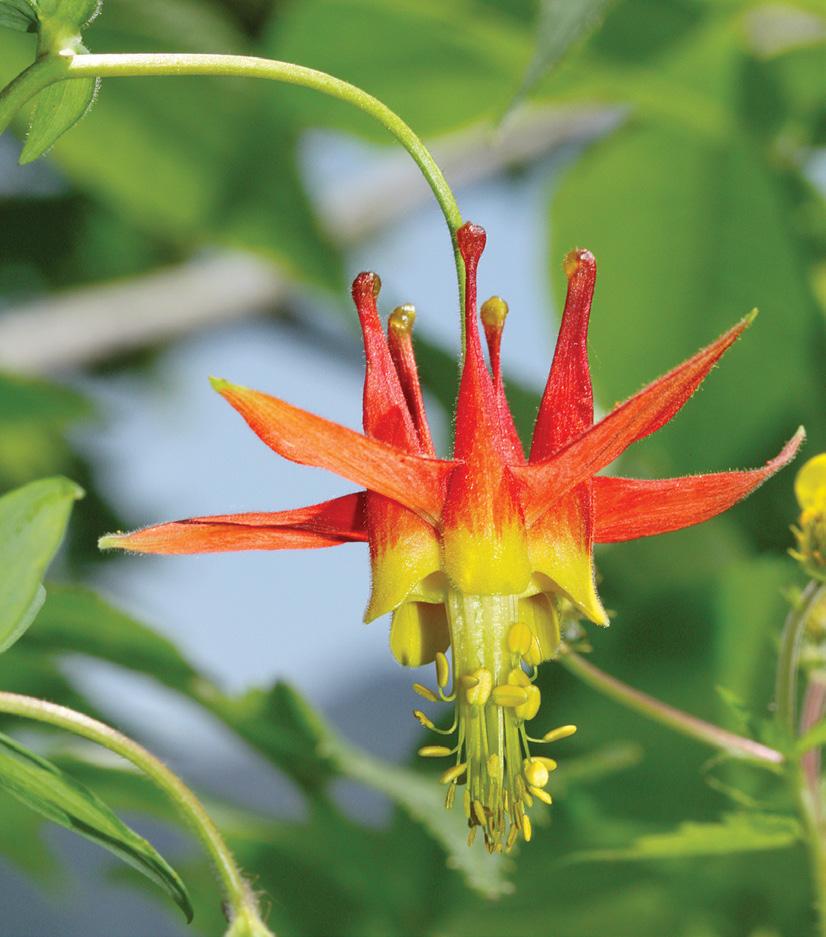

Check out this video to find out how to collect, store, and plant columbine ( Aquilegia) seeds!

https://www.youtube.com/watch?v=UsMRmXWKjac
soil in the crisp fall air or the promising days of spring. If spring planting calls to you, why not give those seeds a cozy start indoors while the frost still nips at the windowpane? They like a bit of a cold spell before they wake up, so chilling the seeds helps them along. Just press them gently into the soil and keep the earth as moist as a dewy morning till they sprout.
Columbine isn’t too picky about its sunbathing, but it does like its sunlight mild and not too hot. If you're up north where the summers are soft, full sun is just fine. Keep the soil as moist as a spring rain; consistency is key here, just like watering your favourite houseplants.
Now, columbine is pretty laid back, but it appreciates a bit of tidying up. Deadheading, or snipping off the faded flowers, keeps your plants looking spry and can encourage them to bloom again. Remember, though, columbine tends to bow out gracefully after a few years, but it'll often leave behind a few seeds to sprout new little surprises for the next season.
Every garden tale has its villains, and for the columbine, it’s often leaf miners and aphids. These critters like to sully the leaves with their antics. A good blast of water or a dab of insecticidal soap usually convinces them to skedaddle. And to keep your columbines from getting all mildewy, make sure they've got room to breathe and dry off after a watering.
The world of columbines is filled with a variety of colourful characters. From the Canadian native columbine ( Aquilegia canadensis) with its red and yellow capes to the elegant Aquilegia vulgaris in shades of knightly blue and royal purple, each variety brings its own charm to your garden.
Planting columbine is like adding
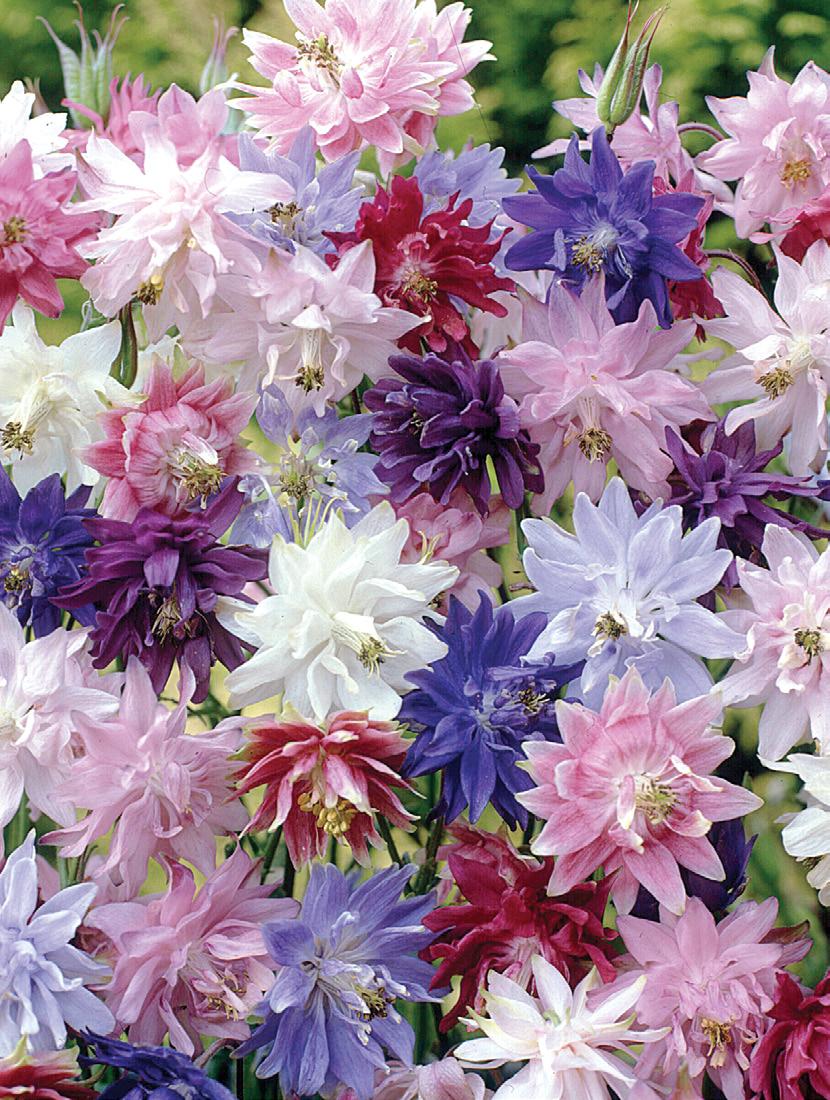



a bit of poetry to your garden. These flowers not only brighten your outdoor space but also invite hummingbirds and butterflies to flit about, adding life and colour to your little slice of nature. By choosing the right spot, preparing the soil lovingly, and caring for your columbines with a tender hand, you'll cultivate a spot of beauty that feels like a leaf right out of a storybook. So, roll up your sleeves, and let the garden magic begin!
Recommended varieties
Native columbines. There are two columbines native to Canada, Aquilegia canadensis and Aquilegia formosa A. canadensis is found from the eastern fringes of Saskatchewan through Quebec. A. formosa exists throughout most of BC.
Barlow series. The first series to produce double spurless flowers. They come in colours from white and blue to almost black and ‘Nora’, a lovely deep pink with a touch of white around the edges.
Kirigami series. Big, upward facing blooms. Comes in blue, pink, red, yellow and white, with a charming deep pink with a lighter pink corolla.
Earlybird series. Bicolour (except the all-white and all-yellow) blooms on tidy plants. Includes purple with white corolla and purple with yellow corolla.
Swan series. This series has large blumes and big spurs leaning back from the petals. Bicolour range includes pink with yellow corolla and blue, violet or purple with white corolla.
Winky Double series. Beautiful double corolla on these upward-facing flowers. So far there are red, rose, white and a beautiful blue with white edges. h
Did you know?
Columbine means ‘dove-like’, because people fancied they could see a cluster of five doves in the flower. Aquilegia means ‘eagle-like’, having to do with the spurs that look like talons. They are short-lived perennials, but they self-sow easily. If you have more than one variety in your garden (or in your neighbourhood) the offspring may not look like the parents, though.
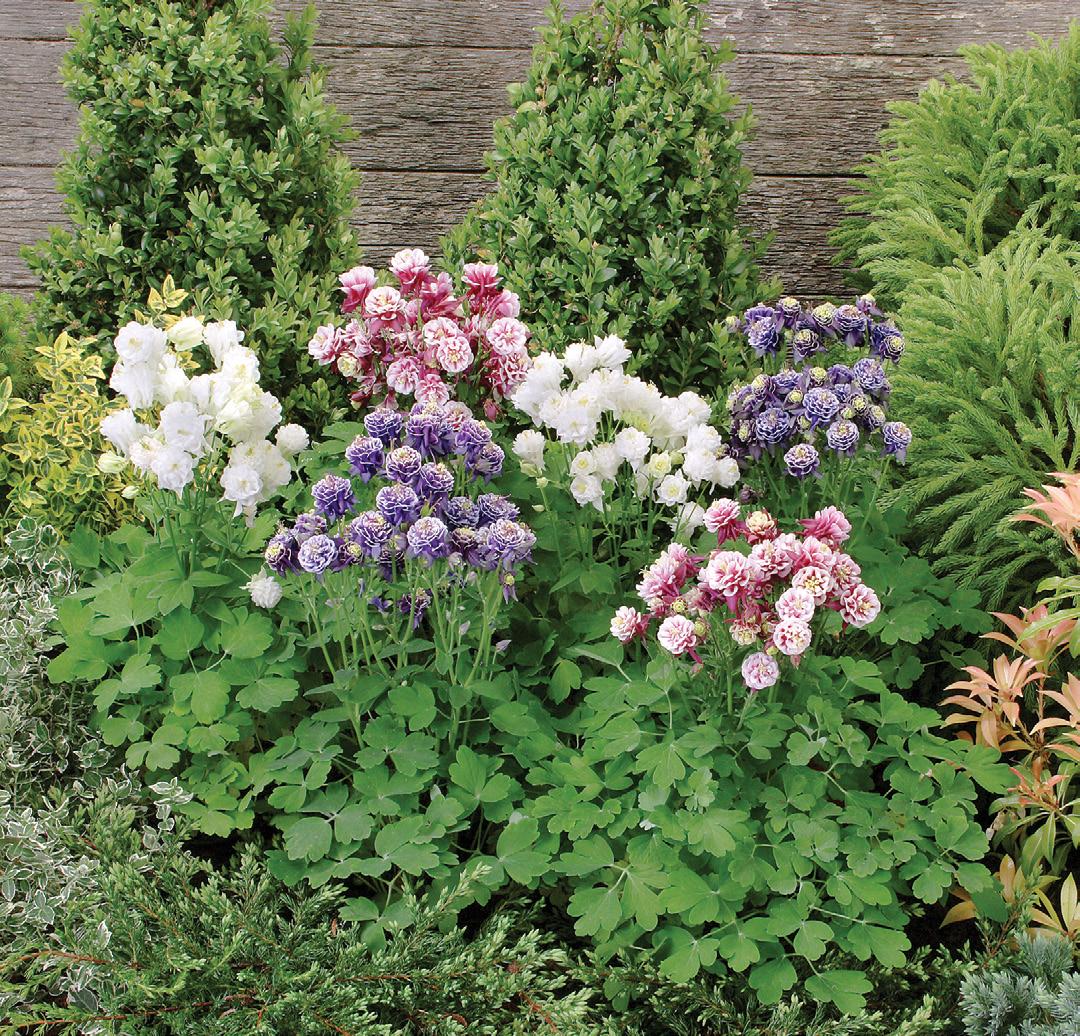




The best idea I ever saw for growing strawberries was in Malaysia. High in the mountains where they also grow tea, there were strawberry greenhouses where the plants were grown in containers above the contaminating ground. This was a decade and a half ago and now I see strawberry bag containers for sale on the internet. No good idea ever goes to waste! However, even though the mountains in Malaysia are the place to escape the heat, it does not get as cold as it does in Canada. Planting in containers in much of our country means going to special lengths to protect the plants over winter.
But most people like to grow strawberries in the ground, and it is one of the easiest fruits you can grow. If you get sick of cultivating and shooing birds away, you
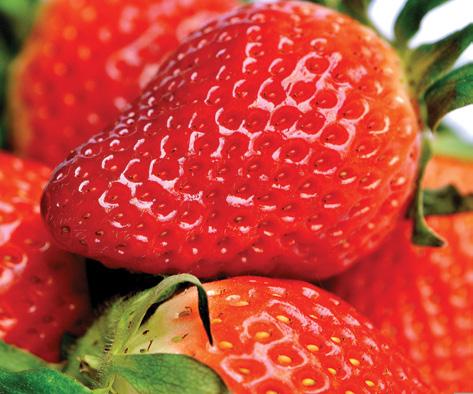
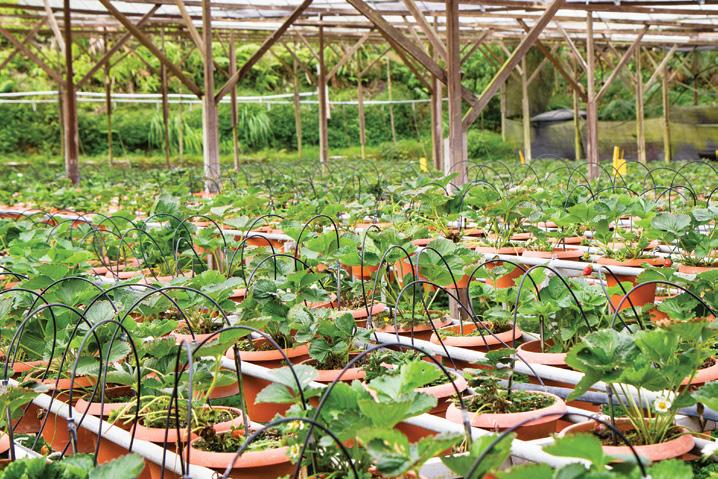
can always use the plants as a ground cover!
Most strawberries need lots of sun – up to 10 hours a day but at least six. They like sandy loam soil with good drainage and will not be happy in clay based or very coarse sandy soils. Improve the soil with compost or other organics and be prepared to mulch, fertilize and or amend the soil annually for the best production. If you have less than ideal soil, you might consider a raised bed, although, depending on where you live, you may have to find a way to insulate over winter or set out new plants each spring – and new plants won’t work with every type of strawberry.
There are four typical types of strawberries and many cultivars. The easiest to grow are the “wild” or woodland ( fraises de bois) strawberries (Fragaria vesca) that produce tiny, intensely flavoured fruit but need very little care. They will tolerate a bit of shade, producing only two to three fruits per plant, but they will spread and make a pretty groundcover. Birds love them. These woodland strawberries are native to all of Canada and most of northern Europe. Also native to Canada are Fragaria virginiana, from Manitoba to Newfoundland, and Fragaria chiloensis in coastal British Columbia.
For cultivated strawberries, June-bearing types are recommended for the home garden and produce very large fruit over a period of three weeks in early summer. You can choose between early, mid or late season types or have a few of each. These perennial plants will not
Astrawberry is not really a berry at all. It is, instead, a multiple fruit, the vessel of a lot of tiny fruits embedded in its juicy walls. By the way, the stems and leaves of the strawberry plant are edible. They can be turned into a flavourful drink, syrup, or a vinegar, are good for cleaning teeth or making an itch-relieving bath.
The little yellow specks we see on the outside of a strawberry are not really “seeds”. The specks are themselves technically fruits called achenes, and the tiny seeds are contained within the achene. Each berry holds about 200 of these.
Did you know that strawberries are the only plant to grow their seed on the outside of what we eat as the fruit?
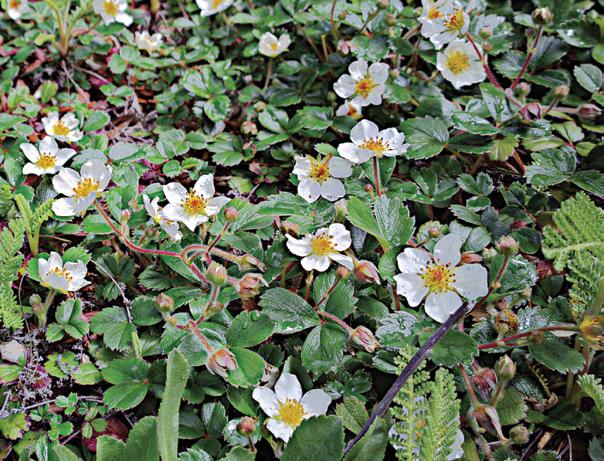
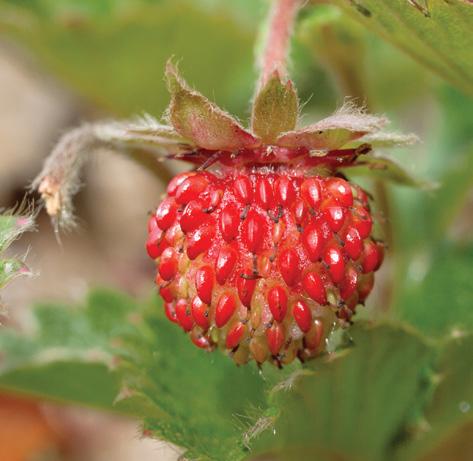
bear fruit until the second year because berries grow from buds prepared the previous autumn.
Everbearing strawberries produce all season long and into autumn. They have smaller berries but are good for making preserves.
Day-neutral strawberries are less sensitive to day length, producing berries throughout the season as long as the temperature remains between 1 and 30 Celsius. The crop is not as heavy as June bearing, but it persists for a much longer time. It is easier to maintain and can be grown as an annual.
Strawberries rely on insects for pollination. You can help production by planting lots of pollinator attractants in your garden. Asters, zinnias, milkweed and marigolds are just a few suggestions.
When planting strawberries, leave them lots of room for expansion because the runners will be reaching out for new territory. Plant them 12 to 18 inches apart in the ground.
Every year or two and not more than three, remove the older, woodier plants and nurture the new ones. Don’t be afraid to prune out runners to keep them under control. Strawberries don’t like to be crowded; it promotes fungus and other diseases. Strawberries appreciate the removal of the first buds in spring which strengthens the leaves and roots and promotes a heavier crop.


What about mulch? Straw is often used under the plants to keep the fruit clean. It also breaks down to condition the soil. In very cold climates, especially if snow cover is patchy or can be sparse, nestling the plants in a nice blanket of straw over winter will protect them from the killing freeze and thaw cycle. Apply the mulch only after you are sure the plant is dormant.
Growing strawberries in containers
Don’t overcrowd strawberries. Plant three plants per square foot in a container (say three plants in a 12-inch pot.)
June-bearing strawberries require a rich, organic soil, basically potting mix amended with compost and slowrelease, granular NPK fertilizer. Fertilize every three weeks then fertilize again in fall. Remember you won’t get berries the first year from June-bearing strawberries. It might be simpler just to grow the day-neutral plants, which can be grown as annuals and so started fresh every year.
Strawberries need to be protected in winter in cold weather regions (zones 2 to 5) by keeping them in an area that stays above -10 Celsius. You can also bury the pot in the garden and insulate the whole thing with mulch or mound topsoil all around them, then cover with more mulch.
One more hint: use a light-coloured container if you can. Strawberries like cool roots. h



Forsythia, with its vibrant yellow blooms that emerge before the foliage, heralds the arrival of spring, brightening gardens even before the rest of the landscape awakens from its winter slumber. This hardy, easy-to-grow shrub is a favourite among gardeners for its low maintenance and high impact.
These shrubs have deep and extensive root systems and they are extremely hardy. The problem is that, while the shrub will survive to -39 Celsius, the flower buds will not (necessarily). In zones 3 to 5, be prepared for some years with no blooms or blooms only on the bottom, where the branches were covered in snow.
Nonetheless, the absolute cheeriness of those bright yellow blooms when you do get them make forsythia a worthy shrub for any Canadian garden in zone 3 and above and even worth the risk in zone 2. And when you don’t get flowers, it is a nicelooking, if slightly dull, shrub.
The genus Forsythia is named after William Forsyth (1737–1804), a Scottish botanist and one of the founding members of the Royal Horticultural Society. Despite its association with Forsyth, the plant was actually discovered and brought to Europe from China by Robert Fortune, a Scottish plant hunter in the mid-19th century. Fortune's expeditions to China introduced many Asian plants to European gardens, including forsythia, which quickly captivated horticulturists and garden enthusiasts with its early spring blossoms and ease of cultivation. Of course, it was already a favourite garden plant in Asia.
Choosing a variety
In the lower zones, Forsythia x

I‘Show Off’ forsythia.
intermedia ‘Northern Gold’ is the gold standard of forsythia varieties, with buds able to withstand temperatures down to -39 Celsius. Developed by Agriculture Canada, it is almost guaranteed to bloom in zone 3 every year. There is also ‘Meadowlark’, good to -35 Celsius, and ‘Northern Sun’, whose buds can be relied on down to -30 Celsius. ‘New Hampshire Gold’ is good to zone 4 or 5.
When living in Toronto, I had a lovely variety with a variegated
leaf that I believe was F. viridissima ‘Kumson’, which is hardy to zone 5 or 6. Others had a groundcover style variety called ‘Happy Centennial’, also hardy starting around zone 5.
Proven Winners has a newer variety that tops out at 6 feet called ‘Show Off’. It is very floriferous with big flowers, but only guaranteed to USDA Zone 5a. There’s a smaller version called ‘Show Off Sugar Baby’, with the same hardiness, that grows to a diminutive 2 to 2-1/2 feet.
n its native regions of East Asia, forsythia has been celebrated for centuries, not only for its beauty but also for its symbolic meanings.
In Chinese culture, for example, the blooming of forsythia flowers is associated with the arrival of spring and the renewal of life. The plant
features in traditional festivals and is often depicted in art and literature, symbolizing good fortune and anticipation of warmer days.
In the West, forsythia’s adoption into gardens has also imbued it with cultural significance. Its early bloom times serve as a natural
indicator of the changing seasons, often cited in folklore and gardening lore as a sign to begin certain agricultural practices, such as planting certain crops. Years ago, I was told by a neighbour to wait until the forsythia bloomed to prune my roses in the spring.

The best time to plant forsythia is in the early fall or spring. Choose a location that receives at least four hours of sun per day, as sunlight is crucial for flower production. Forsythia thrives in welldrained soil. When planting, ensure the hole is twice as wide as the root ball but no deeper, to encourage root growth.
Watering and fertilization
Water your forsythia deeply after planting and be vigilant about watering for the first couple of growing seasons. Once established, forsythia is relatively drought-tolerant, requir-
BOB’S SUPERSTRONG GREENHOUSE POLY.
10 & 14 Mils. Pond liners. Resists hail, snows, winds, yellowing, cats, punctures. Long-lasting. Custom sizes. Free samples. Email: info@northerngreenhouse.com www.northerngreenhouse.com Ph: 204-327-5540 Fax: 204-327-5527 Box 1450 Altona, MB R0G 0B0
To place a classified ad in Canada’s Local Gardener, call 1-888-680-2008 or email info@localgardener.net for rates and information.

ing water only during prolonged dry spells. Apply a balanced, slow-release fertilizer in early spring, just before new growth begins, to support vigorous growth and flowering.
You don’t absolutely have to prune your forsythia, but if you do, do it right after flowering because they bloom on old wood. Of course, you should get rid of any dead or sickly branches, and every few years it’s good to thin the centre to allow light and air to pass through. If you really want to rejuvenate an old one, cut it to the ground in the fall.
If you choose to prune for a precise shape, you can do it with an electric trimmer; just be prepared for fewer blooms.
Landscaping with forsythia Forsythia can be used in various landscaping designs. Its rapid growth and dense foliage make it an excellent choice for privacy hedges or screens. Smaller varieties are perfect for foundation plantings or mixed borders. For an eye-catching spring display, consider planting forsythia in groups or alongside spring bulbs and other early bloomers. h

Join the conversation with Canada’s Local Gardener online! www.localgardener.net Facebook: @CanadasLocalGardener Instagram: @local_gardener X: @CanadaGardener






My husband Michael Holroyd and I have a full-sun 30-footby-30-foot concrete patio where the hot summer sun is ideal for my more than 40 containers of flowers and vegetables. However, if I miss a day of watering, my plants scold me by petulantly drooping, browning and dying. My watering bills are ridiculous, and the wasteful run-off that makes my patio look like a splash pad for kids. While researching options for passive, simple watering, I stumbled across potential use of unglazed earthenware clay for irrigation.
There is archeological evidence that 4000 years ago in China, India, North Africa and Iran, farmers buried large clay pots in the ground and filled them with water to irrigate crops in arid, sandy soil. Earthen-
ware is porous and, through water tension differential, water wicks through tiny spaces in the pot wall into to the surrounding soil. Later the Spanish brought the pots to North America where they were called ollas – pronounced ol-uhz or aw-yahz – which is Spanish for “pots”. In Iran and other areas, the technique is called pitcher irrigation.
After this discovery at about midnight late December of 2022, I woke my long-suffering husband, who is a potter, showed him the ollas and asked him if he could make some for me. In a sleepy voice, he muttered “sure” and went back to sleep. A few months later, he came home from his studio with dozens of ollas and watering spikes of all shapes and sizes along with glazed lids for me to test.
Could a simple olla help me reduce my water use where we have heavy clay soil, thunderstorms, and periodic drought? It was time to do some serious research.
I found technical articles from Kenya, Burkina Faso, Iran and some easy-to-read Coop Extension Bulletins from Zimbabwe and Arizona. In southern United States, there are potters who make ollas for their climate, but nothing I could find for a Canadian Prairie application.
Limitations
According to the articles, limitations are:
• Olla irrigation does not work well in heavy clay soils
• Must be checked regularly
• Refill rates depend on soil, weather and the plant needs; it’s difficult to control variables
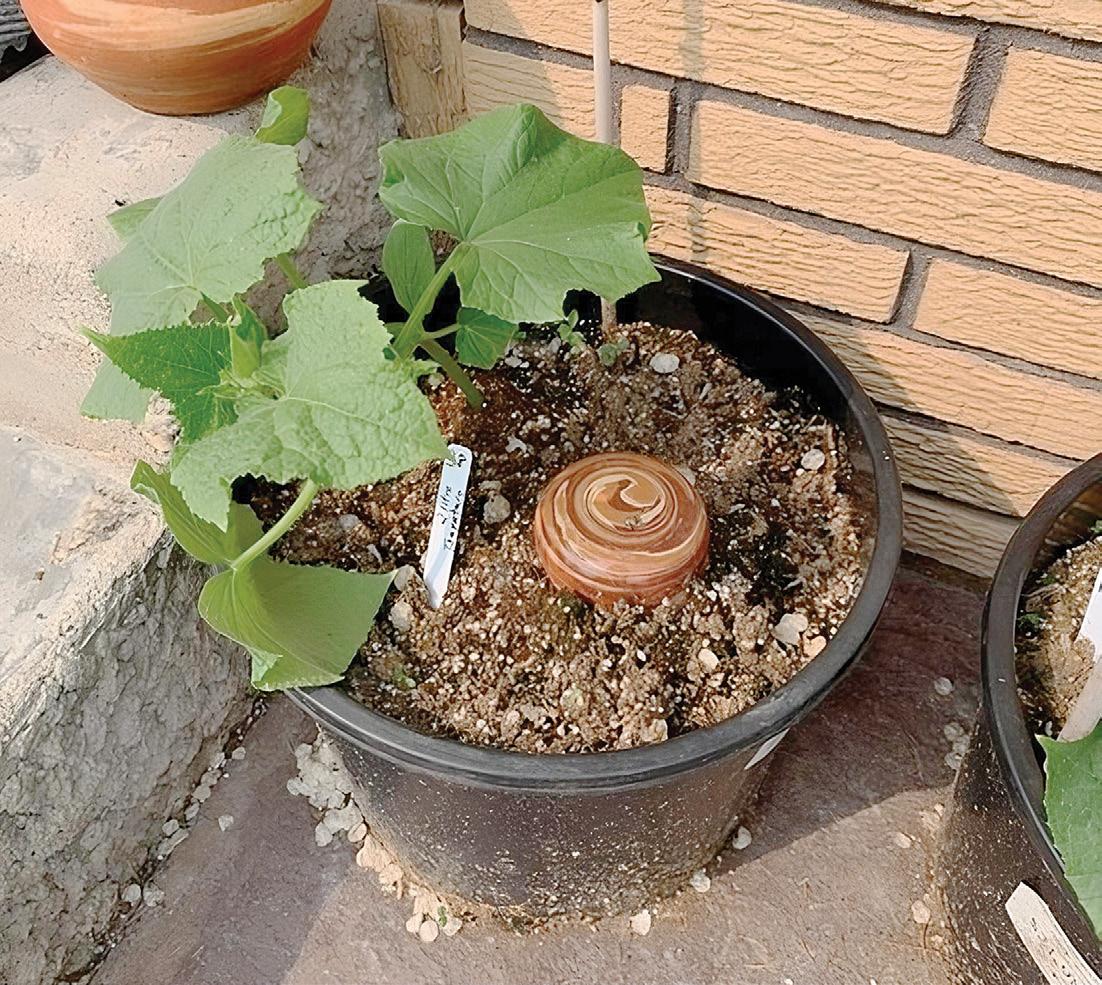
• Earthenware can break in freezing weather
Experiment last summer (2023)
We focussed on container gardening due to the ineffectiveness of ollas in heavy clay soil. Our conditions in Winnipeg last summer were hotter than normal with plenty of rain in the first half of the summer and almost none in second half. Although I tested 66 flower and vegetable containers with various sizes of ollas, earthenware watering spikes, and control groups, this article highlights observations with cucumbers using straight sided, 2-litre ollas.
Method. Using 22-litre black plastic containers and a professional growing mix (Sunshine Mix 4 from Sungro Horticulture), I planted each of eight containers with one cucumber and placed them in full sun. In half of the containers (Olla Test Group), I planted a 2-litre olla off to one side. In the other half (Control Group), I watered with a hose until water ran through the pot as usual.
Every two to four days I would check the ollas and filled any that were ¾ empty. On the same day as I filled ollas, I watered controls with a hose and let the water run through. With no water meter on my hose, I was unable to quantify how much
water was used on controls. The two cucumbers used for this experiment were: ‘Tsuyataro’ Japanese and ‘Straight Eight’ cucumbers.
June. Bedding plants went in June 5 and were watered as described above. On June 15, I fertilized the cucumbers with Liquid All-Purpose Miracle Grow (12-4-8). I added it to each of the 2-litre ollas, and applied the appropriate fertilizer and water mix directly to the controls. While the control plants greened up within a few days of fertilizer application, the cucumbers with ollas took seven days to catch up in growth, likely due to slower release.
July. By mid-July, there was no discernable difference between Olla Test Groups and Controls. With a lot of rain in June and July, it took four to five days between watering. Fertilizer continued to be applied every seven to 10 days until the end of July. By July 28, three out of the four earlier varieties of cucumbers were producing well in all containers. If I missed a few days, it seemed that that the olla tests had slightly better resilience to drooping, but all were affected by hot daily temperatures and blistering sunshine.
August. In beginning of August, plants were in full production and I had more cucumbers than I could give away. But by mid-August when rain was scarce and temperatures were hot, the leaves began to yellow
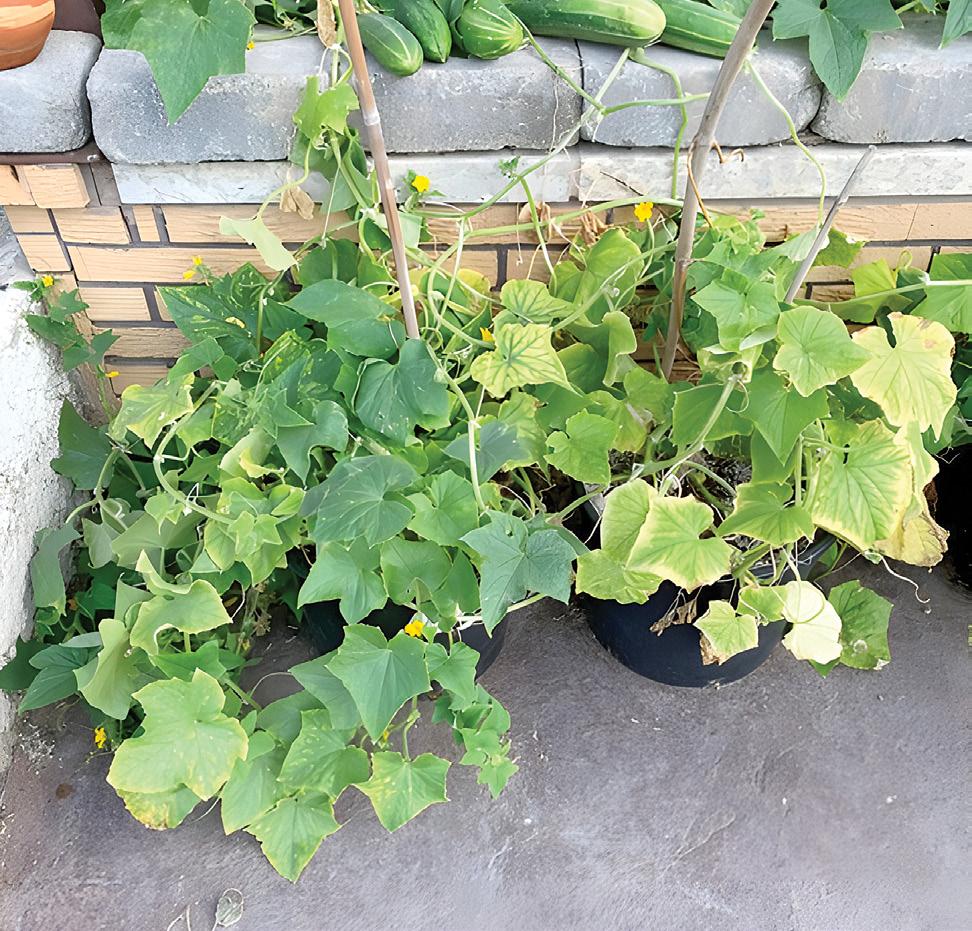


and even burn at the edges, especially on controls. By mid-August, as noted above, the cucumbers were turning yellow and drying in spite of adequate water.
In a desperate attempt to keep them alive and producing, I used a 9-9-16 liquid organic fertilizer. The plants that were fertilized through the ollas bounced back better than those fertilized in the traditional manner. While all the plants suffered in the hot, dry August, those with ollas looked better and continued to produce more cucumbers than the controls.
September. By mid- September, the plants with ollas still had blossoms and fruit and some green leaves while the controls were withered and minimally productive or dead. We were pleasantly surprised at the continued production in the all the cucumbers containers with ollas.
We had some ‘Straight 8’ cucumbers grow unnoticed behind one particularly bushy olla test container and found a wine-bottle sized cucumber on September 14 (see photo). Unbelievably, the ‘Straight 8’ was sweet and delicious even though it looked more like a zucchini.
October. Our last harvest of a few more sweet ‘Tsuyataro’ Japanese cucumbers occurred on October 4. October 12, I removed the ollas and found that the cucumber roots had completely encircled every test olla. While it was easy to remove the now dry olla, I was surprised at how difficult it was to remove the root ball from the soil in the container.
Root development. One of the most positive findings was the robust nature of the roots around the ollas. This finding was consistent across all the plants, whether vegetables or flowers. In the cucumber trials it was very easy to see the difference in roots after removal of the cucumber between tests and controls. Cucumbers with ollas had significantly stronger, longer and more roots that the ones without, both around the olla and at the bottom of the container.
While there are potential applications here in Canada to use ollas to reduce water consumption, we need to understand how best to take advantage of the self-regulating feature of unglazed earthenware pottery in our changeable Canadian climate.
More observations will be required to address the many variables including type of clay, firing temperature, shape, placement of olla, ratio to soil, fertilizer, weather, soil type and plant material. Fast draining clay bodies may be more effective for high water feeders (tomatoes, cucumbers) and slower draining clays for more forgiving flowers.
This summer, Michael and I will be using the self-regulation feature of earthenware in ground irrigation lines and will continue to use ollas and spikes in containers on our patio.
Earthenware clay has used for thousands of years in the garden and there are limitless ideas about adapting this plentiful and fully recyclable resource for other uses such as water cooling, cooking, and water purification. Michael is already working on new designs and we welcome any participation from other gardeners and potters across Canada. If anyone would like more information, please email. We love sharing ideas! h
Karen Thomas is an avid gardener with an interest in permaculture. Michael Holroyd is a potter and carpenter. You can reach them at HTNHomeandGarden@ gmail.com.
Claim
Water savings up to 50 to 70 percent
Ollas self-regulate release of water
General observation over the summer of 2023 in Winnipeg
In order to compare water savings, we must have a way to measure water use more accurately. Observationally, the patio remained dry under ollas while traditional watering from hose caused a wet patio.
The ollas did not empty (release water) when soil was saturated from rain. When the weather was hot, ollas emptied more quickly. As plants grew, the roots found their way to sides and bottom of the olla and used water more quickly.
Tests and controls were watered at the same time for convenience of gardener. Frequency was not compared; plant survival was. Those with ollas seemed more resilient during dry periods when the neglectful gardener missed a few days.
Early season fertilizing showed greening in the control groups more quickly, but the test groups caught up overall. Late season fertilizing through the ollas did significantly better overall in growth and production.
Olla use may extend growing period
We found significantly larger and longer roots in olla test containers. Production of cucumbers was an additional two weeks.

Conclusions
Needs more rigorous measuring system to confirm a numerical value.
Ollas release water as needed based on dryness of soil and needs of plant once roots grow around it.
Ollas may assist the plant survive a few days of neglect.
Earthenware ollas may assist in slowing release of fertilizer.
Ollas attract roots and support development of robust rooting systems.
Earwigs are among the most misunderstood insects, often eliciting unwarranted fear due to myths and their somewhat menacing appearance. However, these nocturnal creatures play an essential role in the ecosystem, breaking down decaying plant material and controlling pests.
The life cycle of earwigs is an interesting journey that spans several stages, from egg to adult. This process is known as incomplete metamorphosis and involves three primary phases: egg, nymph, and adult.
The female earwig lays a clutch of about 20 to 80 eggs in a hidden, underground chamber during the early spring; about 20 percent lay a second clutch of eggs in June. Remarkably, the female displays an unusual behavior for insects. She guards and cares for her eggs, cleaning them to prevent fungal growth.
After about seven days, the eggs hatch. The mother may help them hatch, moving the eggshell to let the nymphs out. The nymphs, which resemble colourless, miniature versions of the adults, make a first meal of their egg casings. The mother continues to protect and feed her nymphs, by regurgitating food for them, until they are capable of fending for themselves, typically after molting twice. Nymphs undergo 4 to 5 molts before reaching maturity, a process that usually spans several months.
Once they have completed their molts, the nymphs are fully formed adults, equipped with the characteristic pincers (cerci) on their rear. These pincers are used for defense, mating rituals, and hunting.
Adult earwigs have a lifespan of approximately one year, during which they mate, and the cycle begins anew.
If you're finding earwigs on your plants and they're causing damage, there are several environmentally friendly methods you can use to manage their population without resorting to harsh chemicals. Here's how to get rid of earwigs on your plants effectively.
1. Reduce moisture. Earwigs are attracted to moist environments. Ensure your garden has good drainage, avoid overwatering, and water your plants early in the morning so the foliage has time to dry during the day. There isn’t much you can do in this regard during a rainy year, though.
2. Clear debris. Remove leaf litter, mulch, and other organic debris from around the base of plants. This deprives earwigs of their preferred hiding spots. Of course, you may want that mulch around your plants to preserve water and keep weeds down.
3. Diatomaceous earth. This is a non-toxic powder made from crushed fossils of freshwater organisms and marine life. Sprinkle it around your plants. It works by dehydrating the earwigs when they crawl over it. You must frequently apply it fresh.
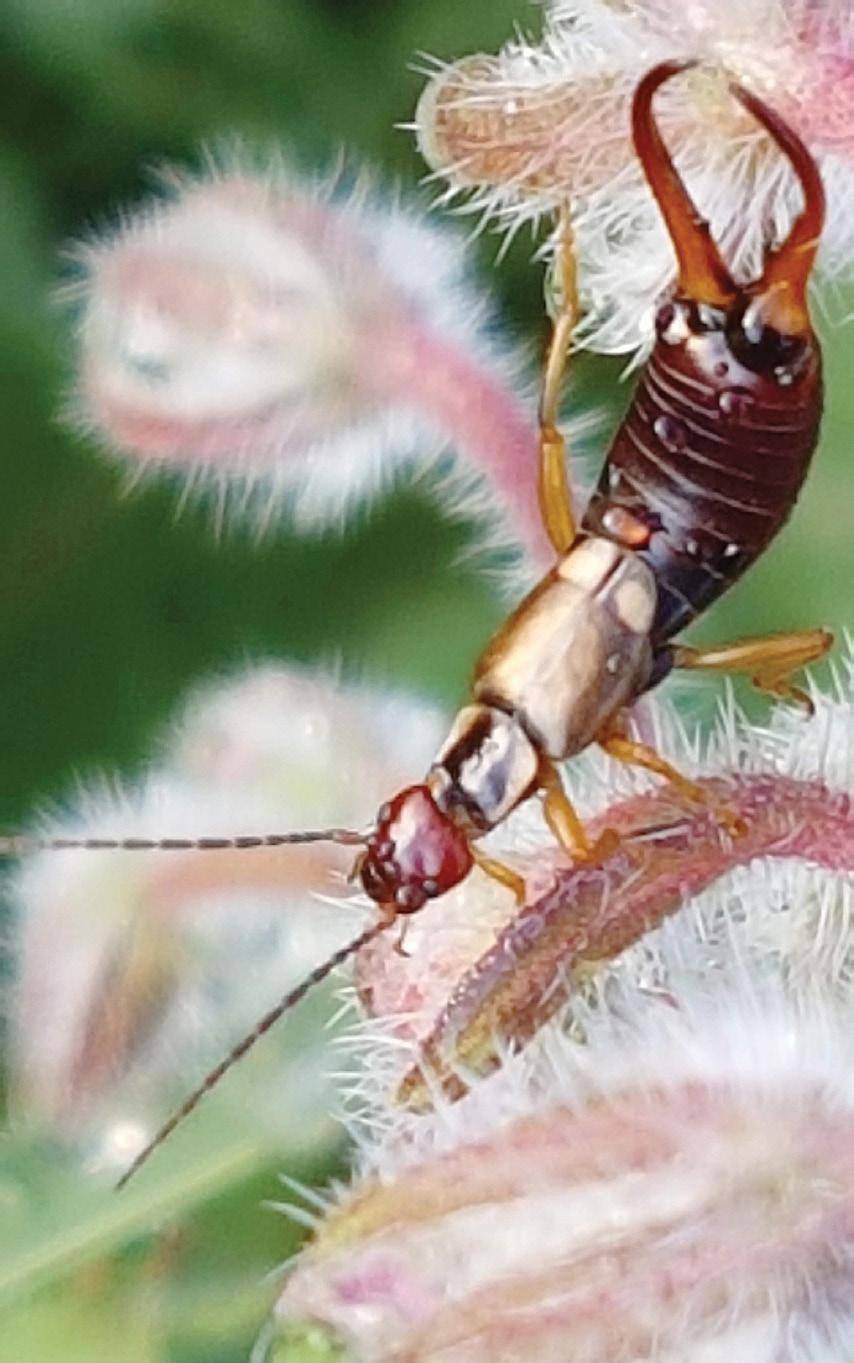
4. Pit traps. Fill shallow containers (like tuna cans) with a mixture of vegetable oil and soy sauce and bury them in the garden so the rim is level with the soil. Earwigs are attracted to the smell and will fall into the trap and drown. Empty and refill the traps as needed.
5. Encourage natural predators. Birds, toads, and some insects such as tachinid flies and parasitic wasps are natural predators of earwigs. Encouraging these predators to visit your garden can help keep the earwig population in check.
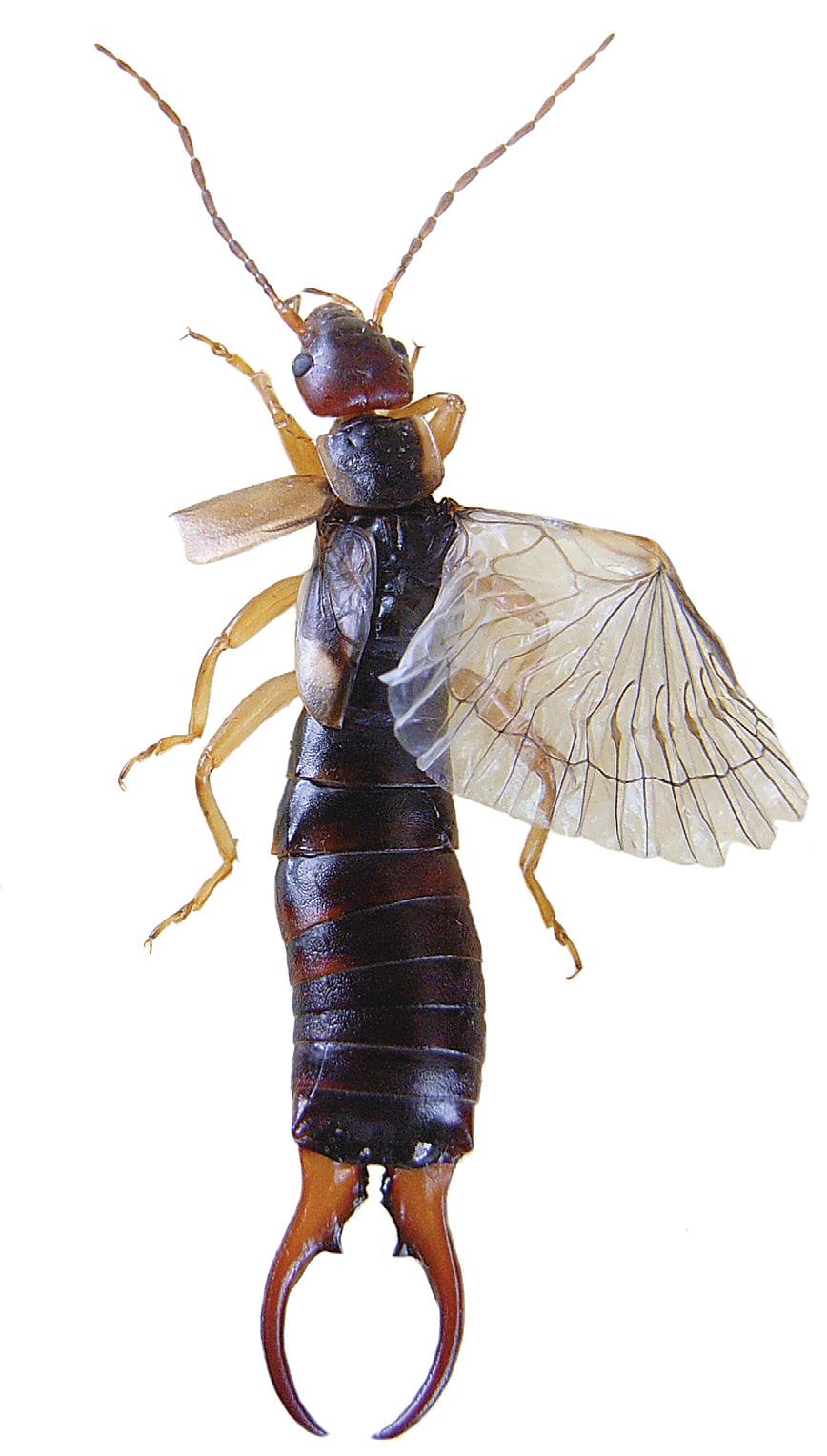
6. Hand picking. If the infestation is small, you can handpick earwigs off your plants in the evening or early morning when they are most active. Wear gloves – they do pinch – and place them in a bucket of soapy water.
7. Row covers. Use floating row covers to protect young plants from earwigs. Ensure the edges are buried or tightly secured to discourage earwigs from crawling underneath.
8. Seal entry points. To prevent earwigs from entering your home, seal cracks and crevices around windows, doors, and foundation.
Always start with the least toxic method of control when dealing with pests in the garden. Earwigs play a role in the ecosystem by breaking down organic matter and eating other insects, so it's beneficial to use methods that control their population without entirely eliminating them. h
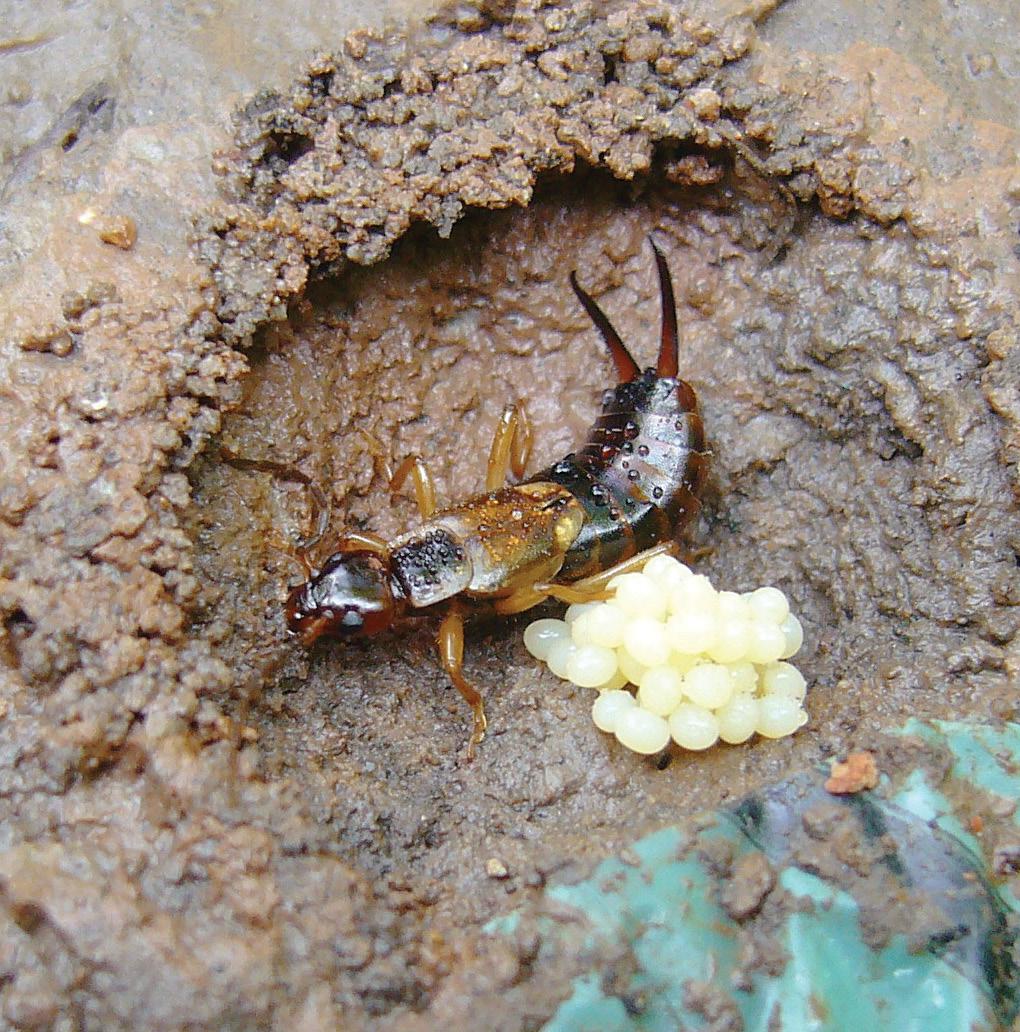
• Parental care. Unlike most insects, female earwigs exhibit maternal care, guarding their eggs and young from predators and disease. This behavior is rare among insects and highlights the complexity of earwig social structure.
• Misconceptions. The name “earwig” comes from an old European myth that these insects crawl into people’s ears and burrow into their brains. There is no truth to this tale; earwigs are harmless to humans (though they can deliver a nasty pinch). Entomologists believe the name refers to the outstretched wing, which looks like an ear.
• Diversity. There are over 2,000 species of earwigs around the world, adapted to a variety of habitats. They vary significantly in size, colour and behavior, demonstrating the incredible diversity of this insect group.
• Diet and habitat. Earwigs are omnivorous and will eat both plant and animal matter. They play a vital role in the ecosystem by consuming decaying vegetation and a variety of pests. Earwigs prefer dark, moist environments and are often found under rocks, logs, or in soil.
• Communication. Earwigs use their cerci not only for defense and mating but also for communication. The shape and size of the cerci vary between species and can be a key identifier in earwig taxonomy. In males, they tend to be curved inward; in females, they tend to be straighter.
• What is an earwig? Earwigs make of an entire Order of insects, known as Dermaptera. There are about 25 species found in North America, though they were not found on this continent before the early 1800s. The one you encounter most of the time is the European common earwig (Forficula auricularia).
Mother earwig with her clutch of eggs. Photo by Tom o ates.
To draw attention to a subject that many of us take for granted, Tara and I wish to share our corporate and our personal concerns and actions regarding the immensely important world of pollinators.
As a seed company, and in my own case as a former commercial grower of sunflowers, we have always been aware of the importance that pollinators play in the production of our food source.
Let’s take the sunflower as one small example… if you examine the head of a standard sunflower growing in fields or your own back yard, you will see an amazing collection of up to 1,500 tiny individual flowers that form the centre of the plant. Each of these flowers (florets) will produce a seed containing a small nut but they can’t do it by themselves. These tiny florets are not self-pollinating and require a pollinator of some sort (usually bees) to visit each plant and distribute the pollen they produce across the florets. Through this process they pollinate the neighbouring florets enabling them to produce a nut within the seed. For this very reason, unless local pollinators are in great abundance, beehives located in these fields help produce the crop and in the case of sunflowers, a very pleasant byproduct called sunflower honey.
Several years ago, General Mills, through their Honey Nut Cheerios brand, partnered with Vesey’s Seeds to produce virtually the single biggest pollinator protection initiative that North America had ever seen. For several years running, specially marked boxes of Honey Nut Cheerios invited the consumer to send in a request and receive a free package of wildflower or sunflower seeds, which are especially suited to attract and maintain pollinators throughout the continent. Over the course of this initiative millions of packages were distributed containing hundreds of millions of seeds that were planted everywhere from coast to coast.

Hand in hand with this promotion was a high level of public education that showcased the importance of maintaining a healthy pollinator population. General Mills even went as far as to create a grocery store that showed the contrast between the foods we have available thanks to pollinators and the small assortment of foods we would be restricted to if pollinators didn’t exist. The impact of sharing the fact that 75 percent of all our crops are dependent on pollinators to produce a healthy yield is astounding! What more would we need to know in order for us to pay closer attention to pollinators, their health and their declining habitats?
Through initiatives such as this the public is slowly becoming more aware of the importance of these winged helpers in the gardens and fields. To help the cause along, we encourage gardeners to add some wildflowers or other pollinator attracting flowers to your landscape and consider adding a mason bee house to help these friends in their reproduction success.
Tara grew up on a stereotypical potato farm, nestled among the picturesque fields on Prince Edward Island. Her summers were spent chasing butterflies (she thought were magical fairies), catching grasshoppers in jars, and picking wildflowers to be proudly displayed on the kitchen table.
Thirty years later, her summers are still spent chasing butterflies, but for different reasons! Now she is focusing on their role as pollinators which, when you think about it, is pretty darn magical. Tara is currently a Butterflyway Ranger with the David Suzuki Foundation. This project is a citizen-led movement growing highways of habitat for bees and butterflies across Canada. Tara also happens to also work in the trial gardens at Vesey’s Seeds in York, Prince Edward Island.
When people hear the word “pollinator”, they often think of bees and butterflies, but you might be surprised

by some of the others. Birds, bats, moths, flies, beetles, and wasps are all considered to be pollinators. Pollinator populations are declining due to their loss of habitats, pollution, diseases, certain crop sprays and climate change. This decline is concerning with so much of our food supply relying on pollination.
Fortunately, people are paying attention. Farmers are planting more flowers around their crops and homeowners are embracing the ‘No Mow May’ initiative. Should you consider participating in No Mow May, think about adding more flowers into your grass like clover or violets to provide more variety than simply dandelions. In addition to having a late start to cutting your grass, you can also delay your yard cleanup. With longer days and warmer temperatures, you might be tempted to start your outdoor spring cleanup early… don’t do it; mother nature needs you to leave the mess just a little bit longer. When you clean up or prune too early in the spring season, you risk disrupting or destroying eggs or pollinators who may not have left hibernation yet. Wait until it is consistently 10 Celsius outside to keep pollinators safe. For the summer season


consider growing black-eyed Susan, milkweed, cosmos, purple coneflower, shasta daisy, sunflowers and zinnias in your garden beds.
Within the trial gardens at Vesey’s Seeds, we are working hard to bring in more flowers that benefit pollinators. Just last year we added both common and swamp milkweed to our catalog, which are two of the only food sources for the monarch caterpillar which can only eat milkweed leaves as a caterpillar. This year, we have created a new bed that will be planted with our Butterfly Garden Collection. Vesey’s gardens have also been certified Wildlife Friendly by the Canadian Wildlife Federation and certified as a Monarch Waystation though MonarchWatch.org.
While Tara doesn’t catch grasshoppers in jars anymore, she is always happy to see them. Their presence as an essential contributor to our ecosystem and research is starting to show that they too are pollinators. Every effort, no matter how small or large, contributes to pollinator health and helps secure our food supply. All gardeners are encouraged to do what they can; after all, pollinators will improve your flowers and increase your vegetable yield. h

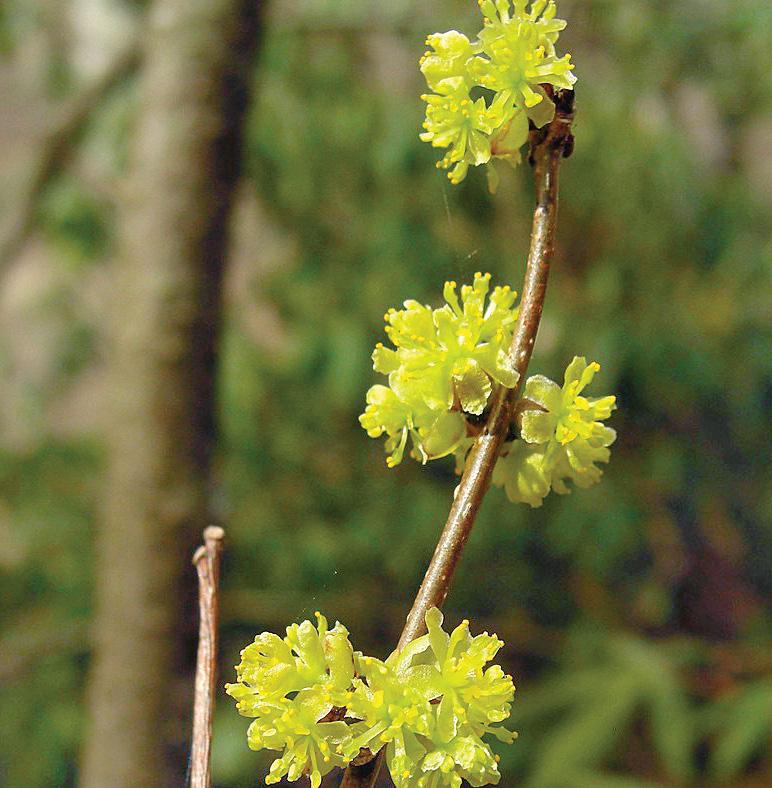
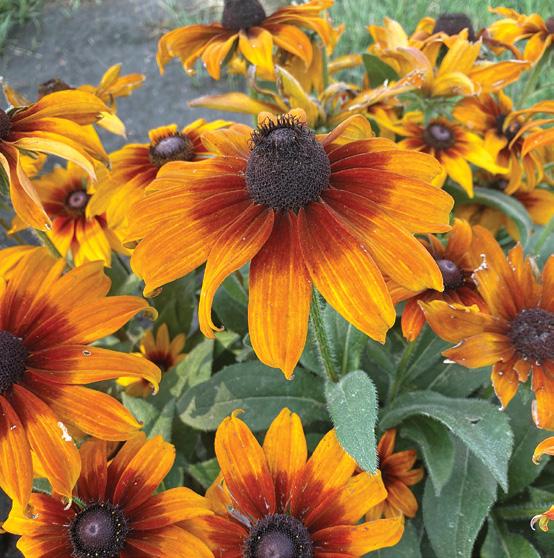

Adiversity of plant materials can attract birds, butterflies, and bugs.
First, you must know who lives in your neighbourhood. Learning what birds live there year-round and which birds migrate is beneficial. Once you know who visits it can help to narrow down specific plants for your landscape.
Understanding what plants grow best is also necessary. There are many plants that while they attract specific birds can also attract butterflies and bugs. There is a wide range of plant materials to provide the needed diversity for everyone’s landscape.
Spicebush, (Lindera benzoin, zone 4) is a shrub that provides both shelter and
food to birds. It attracts a lot of migrant birds because it has red berries in the fall. To ensure that there is good pollination this shrub has separate plants for male and female flowers. You will need two or three spicebushes together in a group to produce berries. It grows in shade and its natural environment is woodland. It gets to be about 3 to 5 feet wide in shade and 6 to 12 feet high and wide in full sun.
If planted in full sun, make sure it is in an area that does not go dry. Growing in the sun, it will have denser growth and be less vigorous, but it will have better flowering and fruit production. It prefers rich, moist soil, and a wet location in your landscape would be ideal, but spicebush can grow in a
variety of soils and is tolerant of clay. Other than attracting migrant birds, American robins and other birds in the thrush family, as well as game birds like pheasant and quail, spicebush attracts caterpillars of the spicebush swallowtail butterfly, the huge promethea moth, and the eastern tiger swallowtail. It also attracts bees.
As companion plants to spicebush, purple coneflower (Echinacea purpurea, zone 3) and black-eyed Susan (Rudbeckia hirta, zone 3) look great, especially if you are growing your spicebush in full sun. Coneflower and black-eyed Susan both like full sun and can tolerate some light shade, but they need moist, welldraining soils.
Winterberry (Ilex verticillata, zone
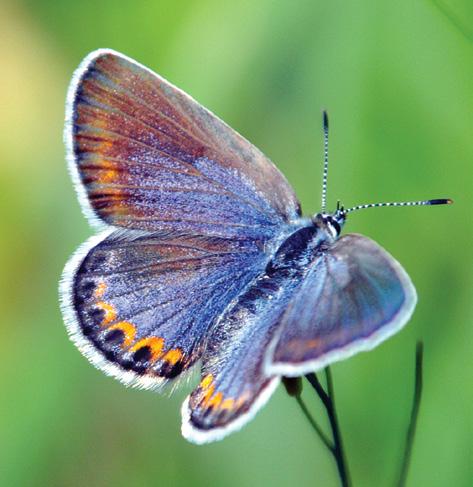
The Karner blue butterfly is a hauntingly beautiful creature. If you see it in flight, the top sides of the wings have dark blue in them with orange spots. When the wings are closed, they are more subdued. The caterpillars are obligate feeders of wild lupines.
In 2003, the Canadian Species at Risk Act declared the Karner blue extirpated from Canada; it can no longer be found in its native Southern Ontario homeland. It is still in parts of Minnesota, Wisconsin, Michigan and New York states, though, so … perhaps it could come back to Canada?
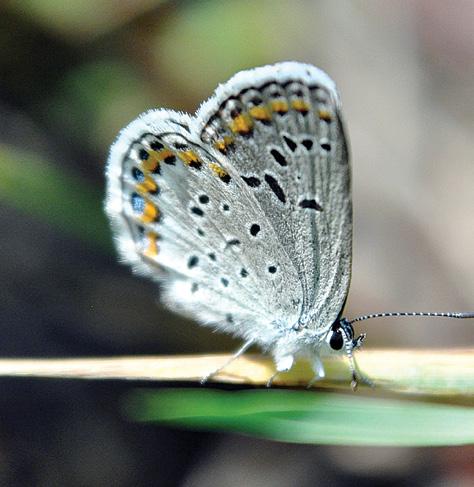
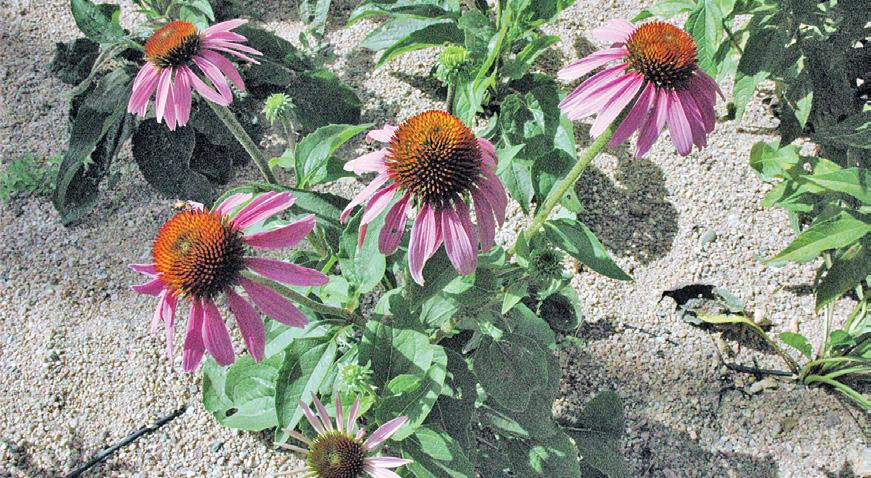
3) and blueberry (Vaccinium angustifolium, zone 2) are good choices for attracting birds. American robins and grosbeaks eat blueberries and sometimes, dark-eyed juncos eat blueberries and winterberry fruit (though the main diet of dark-eyed juncos is insects and seeds of weeds and grasses). Winterberry grows best in wetlands but can tolerate dry soil and grow to 3 to 15 feet high and as wide. Winterberries and blueberries grow best in full sun. Blueberries need moist, well-draining soil that has an acidic pH of 4 to 5 and, depending on the species, can grow to 1 to 8 feet tall by 2 to 10 feet wide. Blueberries are self-fertile but will need two to three plants for the best fruit production.
Other shrubs such as forsythia (zone 3), lilacs (Syringa, zone 2) and rose-ofSharon (Hibiscus syriacus, zone 4) are good for providing shelter. Forsythia, lilacs, and rose-of-Sharon all make good companion plants if they are spaced properly to give them enough room to grow to maturity. Chipping sparrows and dark-eyed juncos will find shelter in these shrubs. If you plant sunflowers nearby, they will feed on the seeds.
Many herbaceous perennials will

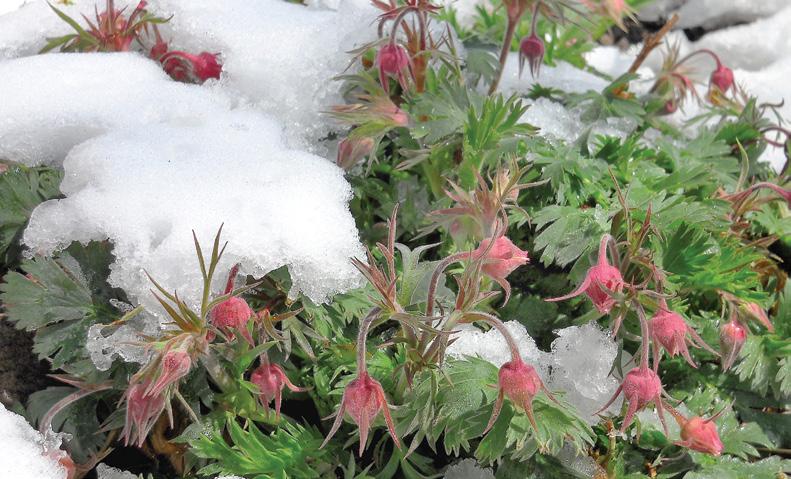
attract pollinators and bugs. The native perennial lupine (Lupinus perennis, zone 4) is a good one because it is the only plant that feeds the caterpillars of the Karner blue butterfly (see sidebar). Lupines grow in sand and loamy soils, and they get to be 1 to 3 feet tall. They also attract bees.
Other herbaceous perennials such as prairie smoke (Geum triflorum, zone 2), golden Alexander (Zizia aurea, zone 3) and Pasqueflower (Pulsatilla vulgaris, zone 2) provide nectar for the birds and pollen for a variety of pollinators.
Annual flowers are important too. Tick seed (Coreopsis tinctoria) grows in sandy, well-drained soil. It grows 1 to 3 feet tall and 1 to 2 feet wide in full sun and partial shade. It has yellow-rust bicolour blooms. Bachelor buttons or cornflower (Centaurea cyanus) grows 12 to 48 inches tall and 10 to 12 inches wide, and does well in moist, welldrained soil in full sun to partial shade. Yellow mustard (Brassica alba), or any species of mustard, are great for attracting honeybees, solitary bees, and hoverflies.
Providing a diversity of habitats gives the birds, butterflies, and bugs something for every creature’s palate. Just

remember that butterflies need host plants and nectar plants. Sometimes that can be the same plant. Marigolds, zinnias, and sunflowers provide both nectar and pollen for butterflies and invite soldier beetles, which are predacious to grasshopper eggs, snails, and slugs. Plus, soldier beetles pollinate, carrying pollen from flower to flower. They hide among grasses either native or ornamental. Having marigolds, zinnias, and sunflowers will invite lacewings that feed on nectar and pollen and eat soft-bodied insects such as aphids.
Grasses and weeds provide seed for the birds that are ground feeders, like chipping sparrows and dark-eyed juncos, which also eat grasshoppers, caterpillars, beetles, true bugs, and spiders. Some of these insects live among little bluestem grass (Schizachyrium scoparium, zone 3), which is also a host for butterfly species such as Indian skippers and Leonard’s skippers.
Whether you have a wildflower garden or a formal garden landscape, be sure to provide a mix of shrubs, perennials, and grasses that will cover the habitats you need. You will have a landscape teeming with birds, butter flies, and bugs. h
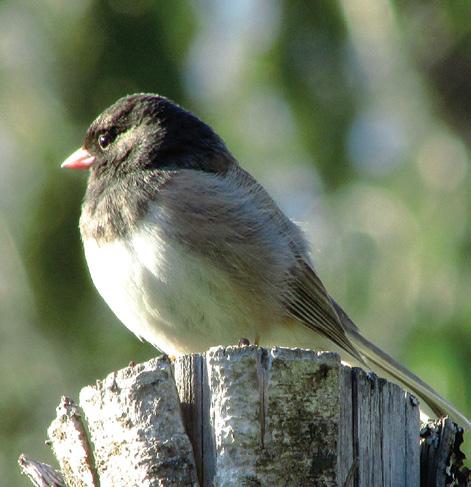
Pollinating plants by hand is a fascinating and useful gardening skill, particularly important for indoor gardens, greenhouses, or in areas where pollinator populations are declining. It's a simple process that can significantly increase the yield of fruits, vegetables, and seeds in your garden.
Understanding pollination
Pollination is the transfer of pollen from the male parts of a flower (the anthers) to the female part (the stigma) of the same or another flower. This process is crucial for the production of fruits and seeds. While many plants rely on bees, butterflies, birds, and other animals for pollination, some situations require human intervention.
How to do it
First, you need to understand the flower structure of your plants. Some plants have flowers with both male and female parts (perfect flowers), while others have separate male and female flowers (imperfect flowers). For example, tomatoes and peppers have perfect flowers, whereas squash and cucumbers have imperfect flowers.
For perfect flowers, gently brush the pollen from the anthers to the stigma within the same flower or between flowers on the same plant or different plants. That’s it. Done and dusted! (Pun intended.)
For plants with separate male and female flowers, identify the female

of the flower, as shown on
flowers; they often have a swelling at the top of the stem, just under the bloom, that looks a little like the fruit. Collect pollen from the anthers of the flowers without the swelling using a small brush or cotton swab. Gently brush the
collected pollen onto the stigma of the female flower. In some cases, such as with squash and cucumbers, you might directly touch the male and female parts together to ensure pollination: pull off a male flower and smoosh it into a female flower.
1. Low pollinator activity. In areas with declining bee populations or insufficient presence of other natural pollinators, hand pollination can ensure that plants are pollinated. This is crucial for the production of fruits and seeds.
2. Indoor gardens and greenhouses. Plants grown indoors or in greenhouses may not have access to natural pollinators. Hand pollination allows these plants to produce fruit and seeds.
3. Increase yield. Even in environments with adequate pollinator activity, hand pollination can increase the yield and quality of fruits and vege-
tables. By ensuring that flowers are effectively pollinated, gardeners can maximize the productivity of their plants.
4. Educational purposes. Hand pollination offers a unique educational opportunity to learn about plant biology and the pollination process. It can be a valuable hands-on learning experience for students, garden enthusiasts, and anyone interested in botany.
5. Pollination of specific plants. Some plants, especially exotic or specialty varieties, may require specific pollinators that are not present in their growing location. Manual polli-
nation ensures that these plants can still reproduce and produce fruit.
6. Unfavourable weather conditions. Poor weather conditions, such as rain, high winds, or extreme temperatures, can inhibit the activity of pollinators. During such times, hand pollination can be a reliable alternative to ensure that plants are pollinated.
7. Controlled breeding. Hand pollination enables precise control over plant breeding, allowing gardeners and breeders to produce specific plant varieties. This is especially useful in developing new plant varieties with desired traits, such as disease resistance or improved flavour.

Continue the pollination process with other flowers on your plant or in your garden, ensuring that you're using pollen appropriately if you're working with different plant species.
Tips for hand pollination
• Timing is crucial. Flowers are often most receptive in the morning, so aim to pollinate early in the day.
• Be gentle. Flowers are delicate, so work carefully to avoid damaging them.
• Know your plants. Understand-
Buzz pollination, also known as sonication, represents a fascinating facet of the natural world where certain plants have evolved to release their pollen only when vibrated at specific frequencies. This process is a vivid demonstration of the intricate relationships between flora and fauna, showcasing the specialized adaptations that have emerged through millennia of co-evolution.
Buzz pollination involves a unique interaction primarily between certain flowering plants and their pollinators, most commonly bees from the genus Bombus (bumblebees). About 9 percent of plants you come across require buzz pollination, including tomatoes, eggplants, peppers, potatoes, blueberries, cranberries and bearberries.
Unlike the more common method of pollination where pollen grains freely dust the bodies of visiting insects, which then transfer pollen from flower to flower, buzz-pollinated plants hold their pollen inside tubular anthers, releasing it only when the right “buzz” is applied.
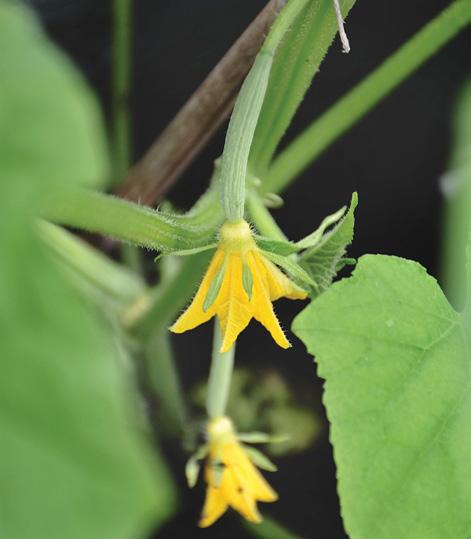

Check out this video to find out the toothbrush tomato trick to get better fruit set & flower pollination.

ing whether your plants are selfpollinating or require cross-pollination with another plant is vital.

The process is quite remarkable: a bumblebee or another capable insect will grab onto the flower and rapidly vibrate its flight muscles without flapping its wings, producing a high-frequency buzz. This vibration is transferred to the flower, shaking loose the pollen grains inside the anther, which then adhere to the insect’s body. When the bee visits the next flower, some of this pollen is transferred, fertilizing the plant.
What makes buzz pollination especially intriguing is its mutual benefit. For the plants, it ensures that pollen is only collected by pollinators capable

• Monitor your plants. After pollination, keep an eye on your plants for signs of successful fertilization, such as fruit development.
Hand pollinating plants can be a rewarding experience, offering a deeper connection with your garden and ensuring the productivity of your plants. Whether you're dealing with low pollinator activity or growing plants indoors, manual pollination is a simple yet effective way to enhance your gardening success. h
of triggering release, reducing waste and increasing the chances of successful cross-pollination. For the pollinators, it provides access to a rich and exclusive food source, as not all insects can perform the necessary buzz.
However, buzz pollination is under threat due to various factors including habitat loss, pesticide use, and the decline of pollinator populations. The specificity of this pollination method means that the decline of suitable pollinator species can significantly impact the reproductive success of buzz-pollinated plants. Conservation efforts are crucial to protect these specialized pollinators and maintain the biodiversity and resilience of ecosystems.
Buzz pollination is a testament to the complexity of natural selection and the delicate balance of ecosystems. It highlights the importance of conserving pollinator species and their habitats to ensure the continued success of this unique pollination method, which is vital for the reproduction of certain plants and the overall health of ecosystems.

Recent years have seen increasing difficulties in maintaining healthy bee populations in Canada, with particularly high losses during the winter months. Agriculture and Agri-food Canada has identified several critical factors impacting bee health:
• Bees are threatened by Varroa mites, the parasite Nosema ceranae, and American foulbrood, a bacterial virus.
• The decline in diverse foraging options means supplementary feeding (sugar water) by beekeepers. New housing developments are good for the increasing human population but not great for honeybees.
• The vitality of a colony hinges on the health of its queen, which can be affected by breeding practices and exposure to diseases and chemicals. Beekeeping practices vary widely and can significantly influence bee survival.
• Severe weather conditions, including long, harsh winters, can decimate bee colonies.
• Bees often come into contact with pesticides used in agriculture, posing a serious risk.
Reports from the Canadian Association of Professional Apiculturists indicate a troubling increase in bee overwintering mortality since 2006, with losses reaching as high as 35 percent in 2007 to 2008. They had moderated in recent years, but in 2021 to 2022, the losses amounted to over 45 percent.
Varroa mites
Key factors identified by beekeepers as contributing to the high mortality rates included poor Varroa mite control, weak colonies in the fall, and adverse weather conditions.
Varroa mites feed on the hemolymph (essentially the blood) of both adult bees and developing brood (larvae and pupae). This feeding not only weakens the bees but also impairs their developmental and reproductive capacities.
Perhaps the most damaging aspect of Varroa mites is their ability to act as vectors for several viruses, including the deformed wing virus and acute bee paralysis virus. These viruses are often present in colonies at low levels but can become epidemic when the mites spread them throughout a colony.
High infestations of Varroa mites can lead to a weakened colony. Beekeepers can monitor the number in their hives by several simple methods and can treat the bees to get rid of the mites.
Neonicotinoids are a type of pesticide widely adopted across Canada, praised initially for their lower toxicity to mammals and targeted effectiveness. However, these chemicals have been implicated in bee population declines, particularly noticeable after significant bee die-offs in 2012 linked to the planting of treated corn and soybean seeds in southern Ontario.
The connection between neonicotinoids and bee deaths appears to be mostly associated with exposure to pesticide-laden dust during the planting of treated seeds. In response, Health Canada's Pest Management Regulatory Agency introduced several measures aimed at minimizing dust exposure during these critical planting periods. Regulations now require the use of dust-reducing lubricants during the planting of treated seeds. Pesticide labels have clearer warnings
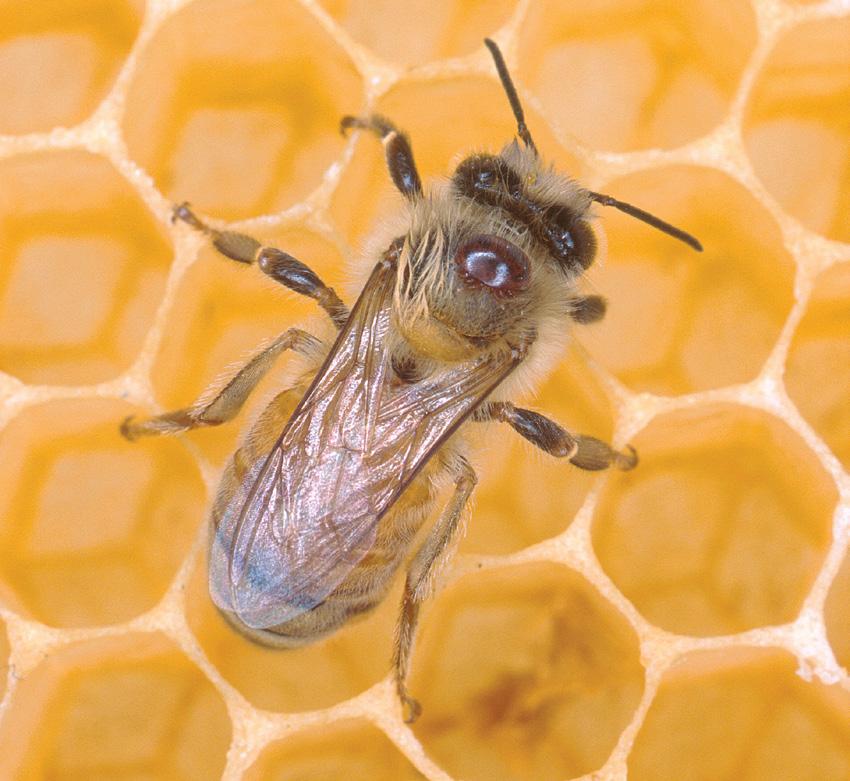
to protect bees during crop spraying. And the promotion of Integrated Pest Management practices encourages reducing dependence on chemical treatments.
Vaccine against foulbrood and more
The first vaccine designed for insects, specifically targeting Ameri-

can foulbrood, a bacterial disease affecting honeybee larvae, has been developed by Dalan Animal Health. The vaccine is administered through a sugar paste ingested by worker bees and then fed to the queen. It shows promise not only in protecting against the targeted disease but also in reducing viral diseases spread

by Varroa mites. In a study conducted by Dalan, hives with vaccinated queens had 83 percent less virus than unvaccinated hives, despite similar mite levels.
The vaccine has been given conditional approval by the Canadian Food Inspection Agency and is being used for the first time this year. h

great yard or garden begins with a great foundation. Reimer Soils has been providing the highest quality landscaping products for more than 40 years. With a complete range of top quality products and unmatched customer service, there is no reason to look any further than Reimer Soils for all your landscaping supply needs.

When gardeners (or potential gardeners) contemplate the design of their gardens, thoughts instinctively go towards raised beds, ponds, retaining walls, pergolas, border plantings and so forth. Trees are often thought of much later as an add on or something to work around, yet trees are really the core of the typical garden providing a defining if not rather permanent feature. Unlike smaller plants and shrubs, trees cannot be moved once in place. Trees should be one of the first elements to consider in your garden as they offer structure, providing a base for all its other elements.
Through their leaves, bark and sometimes fruit, trees provide colour and shade to the garden. Shade can directly affect the productivity of the rest of the garden; shade tolerance is a very powerful theme in forestry and in gardening. There are many other environmental benefits that can be attributed to trees including: cooling and warming houses, air and water quality, flood and drought reduction, erosion control, wildlife habitat, carbon capture and sound and glare reduction.
The guiding principle in the use of trees in the design of a garden should always be the right tree in the right place. It’s an easily understood phrase, but one which involves species, soils, aspect and shade, with the use of native trees always emphasized. Native trees are widely adapted to natural conditions and have evolved to live with the local ecology (climate, insects, diseases). Unlike many exotic trees, native trees generally require less special maintenance or interventions and are better habitat for local wildlife, which is a desirable trait (in most cases!). However, the case for the non-native can be made where conditions are severe, such as compaction or road salt.
Species
Generally, pick a species of tree that you like the look of, that won’t be a source of constant maintenance (attention: white birch!), that will fit into your garden and that is of a hardiness zone suitable to where you live. In general, I prefer larger trees with the option of pruning as opposed to planting tiny “lollipop” trees hoping they will one day fill in a particular
spot. Pay particular attention to not only the height but also the maximum width of your tree to avoid it unnecessarily scraping against your house, a fence, or your neighbour’s backyard. Conifer or deciduous (hardwood) is a large decision. Conifers are valuable because they can screen things – like garbage boxes, heat pumps and neighbours – all year long whereas deciduous trees will lose their leaves in the winter.
Although all trees prefer the sun, they have evolved to live in various intensities of shade, from full sunlight (like poplars and willows) to complete dark shade (like beeches and hemlock). With time, trees will increasingly create shade, a consideration where sun is required (like vegetable gardens and swimming pools). With time, shading can change the use of your garden, going from sun-loving wildflowers to shade tolerant shrubs such as witch hazel or hydrangea. For more adventurous forest gardeners, you can create your own mini forest by planting a canopy of light loving trees with an understory of shade loving trees
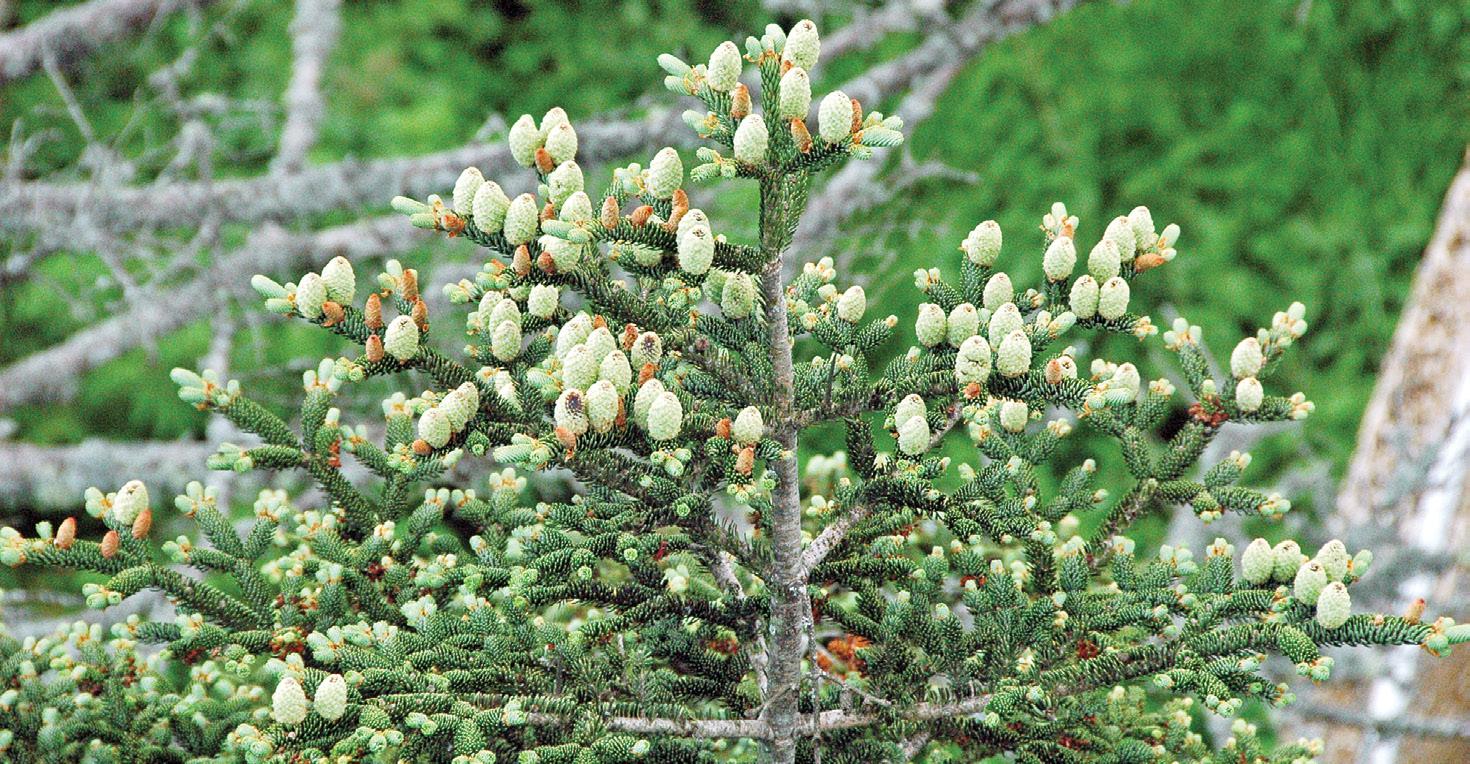
and herbaceous plants below it. For less adventurous gardeners who want to ensure that they live and garden in the sun, placing trees along the northern boundary is the easiest plan.
Soil
While most homes have soils that are heavily modified in the construction process, it is important for tree growth to know if the soil is sand, loam or clay. Trees modify soils as well. Conifer needles tend to lower the pH of the soil (making it more acidic) while deciduous trees can raise the pH (making it more basic). Acidic soils can be problematic for many species of trees and other plants.
Size matters
There are two takes on the theme of size: the size of the material you are planting, and what size you want the tree to grow into.
Regarding the material to plant, the choices are: bareroot stock, container stock and large diameter stock (ball and burlap or large containers). There are two benefits in planting larger trees on your property: instantaneous aesthetic gratification and protection against the compaction and abuse of people and pets. Otherwise, if you can wait a few years and if the tree will not be subject to people pressure, planting a much smaller tree (either bare root or container) may have a greater chance of survival and cost a lot less.
The other piece to the size question is how big a tree you want to
Poplars, willows, dogwoods
Oak, red maple, yellow birch, elm
Sugar maple, American beech, hemlock
Do well in sand Do well in loam Do well in clay
Serviceberry, red oak, bur oak, pines, gingko*, honey locust, hackberry, Kentucky coffee-tree
Maples, oaks, Fraser fir, Douglas fir, Norway spruce*, dogwood, birch
Red/silver maple, poplar, willow, tamarack, swamp white oak, hawthorn, basswood
Good for small spaces and patios
Serviceberry, katsura*, eastern redbud, dogwood, smoke tree*, hawthorn, ironwood, blue-beech, magnolia, crabapple, plums/cherries, alder
Can withstand harsh, city conditions (compaction, salt)
Ironwood, gingko*, hawthorn, Norway maple**, hackberry, elm, scotch pine**, Austrian pine, London plane tree, black locust, honey locust, zelkova*
*Non native, ** Non native and sometimes invasive
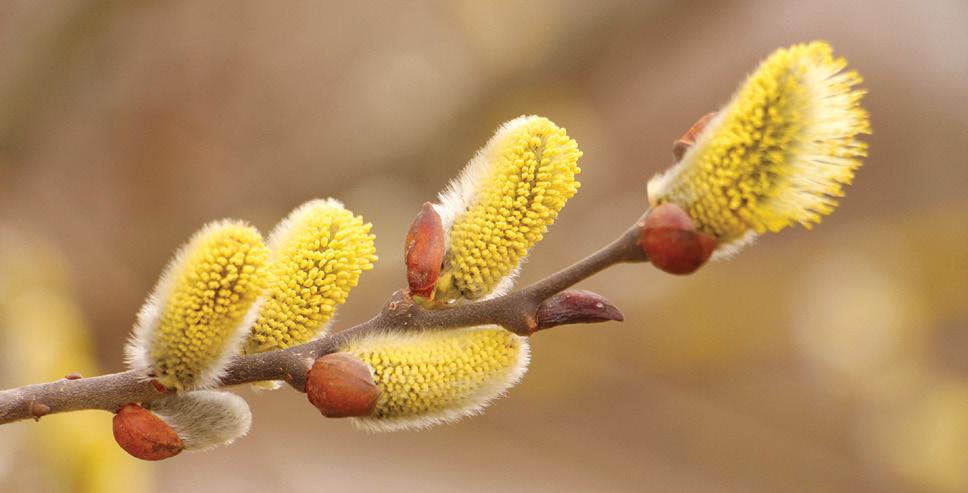



have on your property. As previously mentioned, most trees can be easily pruned so planting a potentially large tree can be considered, depending on the size of your lot. Look at where you will be planting your tree and imagine it when it is fully grown (many websites will tell you the maximum height and width of trees). Choose carefully.
When trees are planted very close together, say less than 6 feet, they will easily fill in a bare space in little time, but they will lose limbs as they self-prune: side branches will be shaded out and will die. If there is sun on the other two sides of the tree,
it will form and keep branches (like a cedar hedge). Along most boulevards, a spacing of 10 feet is generally used. This allows the crowns to fully develop and will usually allow the trees to eventually touch at maturity. Most trees will have widths exceeding 10 feet. In the forest, these trees’ crowns often touch, they self-prune and grow tall. The greater the spacing between the trees the more of the tree’s energy goes into side branches and not into height.
There are many myths around trees and house foundations. Tree roots seek nutrients and water, both of which house foundations have none of. That being said, trees,

particularly in clay soils, can draw enough moisture from the soil that subsidence can occur, resulting in a shift in the soil (and your basement walls particularly if the house foundation is back filled with clay). A general rule is that your trees should be planted at least half the width of the tree’s mature canopy away from the house.
North, south, east, west
In Canada, southern aspect is warmer than northern aspect, western aspect is windier than eastern aspect. When planting trees that are marginally hardy for your climate, south-facing planting can help in survival. For energy conservation

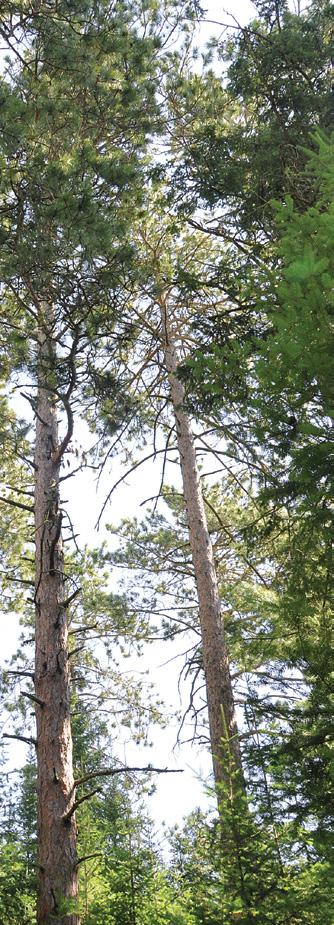

purposes, it makes sense to have conifer trees planted on the western and northern sides of your house, as these are the prevailing winds: they will screen your house against cold winter winds throughout the winter. Similarly, deciduous trees planted on the southern side of your house will give adequate protection from the sun’s rays in the summer and with winter leaf loss, will allow sunlight to penetrate and help warm your house during the colder part of the year.
Plant shrubs around your air conditioner. The shade created by these shrubs will increase the energy efficiency of your air conditioner

by keeping it cooler during the hot summer months. You can save up to 15 percent of your energy bills through the proper placing of trees around your home.
Maintenance
All trees need to be maintained. When they are young or in times of drought they need to be watered. If growth needs to be controlled, pruning must take place. As the tree is growing, weeds which rob the tree of light, water and nutrients need to be controlled. This can be done through mulch mats (carpets of coconut or geotextile cloth) or loose mulches (wood chips) which are piled no higher than 4 inches around
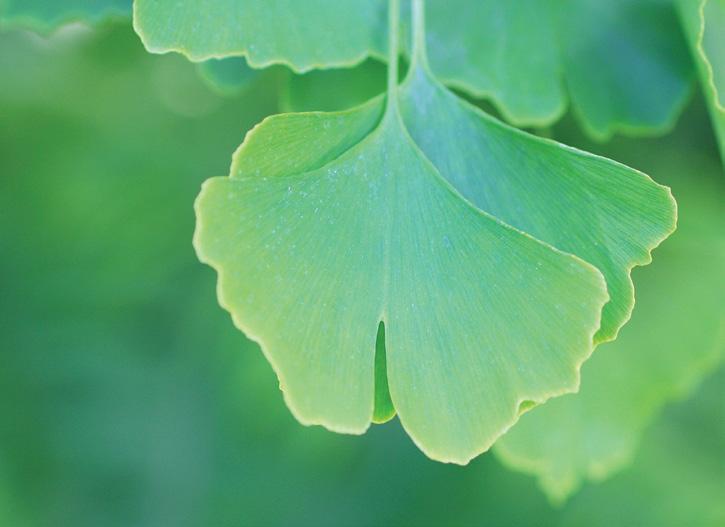
the tree in a 3 to 6 foot circle, but not right up against the bark.
One thing to be wary of is trying to combine flower and plant arrangements around the base of trees. Not only will these rob the tree of light, nutrients and water but maintaining these plants may destroy feeder roots of the tree; most tree roots are in the top 16 inches of the soil.
Rodent guards for newly planted trees are always recommended.
Now that you have the information, good luck in designing your garden with trees! h
Michael Rosen, RPF, Certified Arborist, TRAQ, Former President Tree Canada, Adjunct Professor UBC.
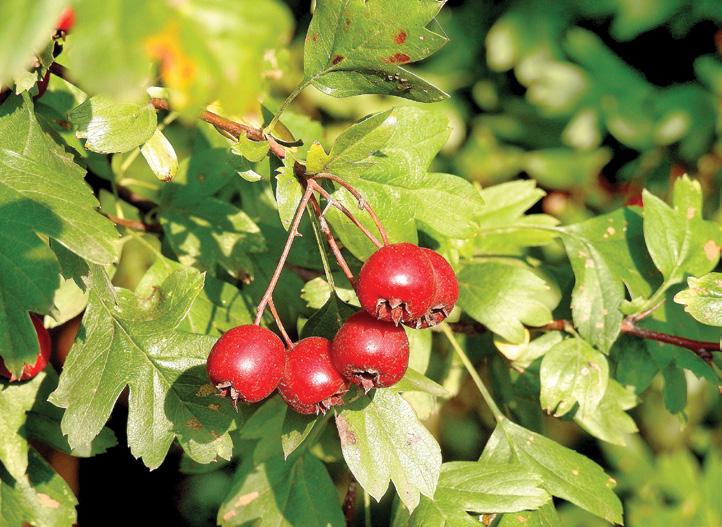
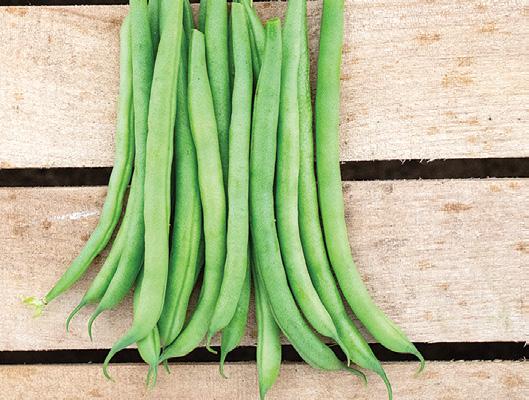

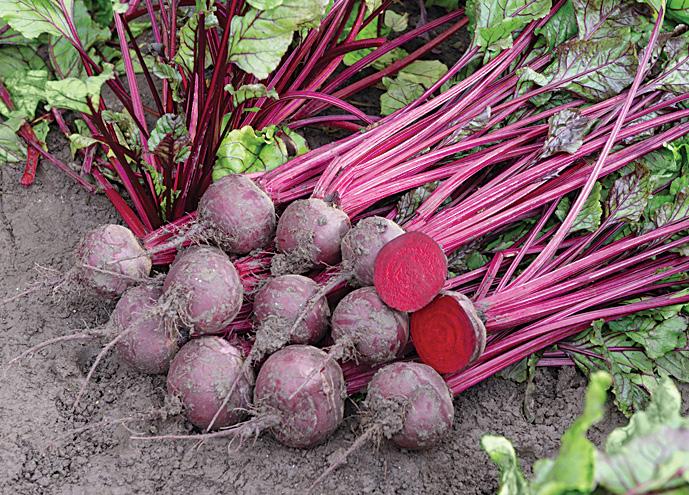
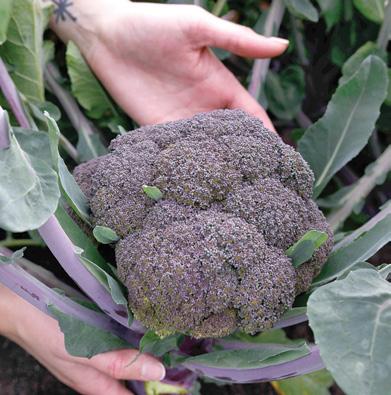


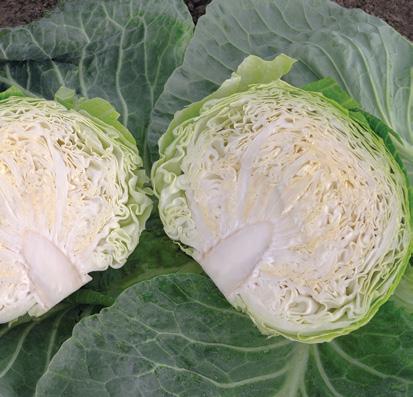
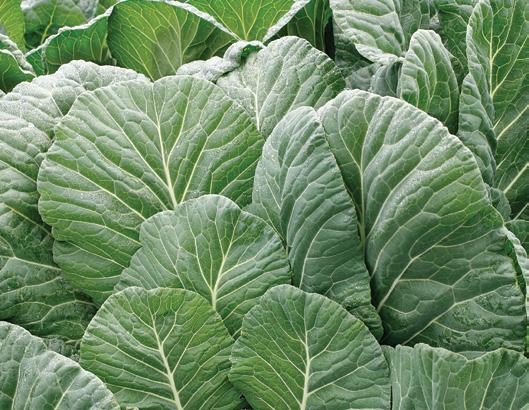


Bean ‘Blue Lake Superior’ (Phaseolus vulgaris). Very flavourful green bean with bushy, less-floppy habit and strong resistance to diseases. Perfect for canning and freezing. Bean pods are uniform and medium green. 12 to 18 inches high. Pure Line.
Bean ‘Caspian’ (Phaseolus vulgaris). Beautiful gold colour and high yield in this wax bean, which stays yellow even when blanched. Can be crowded to 3 seeds in a 10-inch pot for small gardens, but for larger spaces put them in every 2.5 inches. Pure Line.
Beet ‘Manolo’ (Beta vulgaris). Nice round shape and beautiful red colour with good foliage. 18 to 24 inches high. Bejo Seeds.
Broccoli ‘Purple Magic’ (Brassica oleracea). Tight uniform heads, great flavour, heat tolerant… and it's purple! 24 to 36 inches high. All America Selection.
Broccoli ‘Skytree’ (Brassica oleracea). Beautiful solid broccoli with wonderfully tender stems. 18 to 24 inches high. All America Selection.
Butternut squash ‘Metro PMR’ (Cucurbita moschata). Great flavour in a smaller size. It keeps well in storage and grows on a less-crazy vine. It takes 105 days to reach maturity, though, so plan accordingly. Johnny's.
Cabbage ‘Conqueror’ (Brassica oleracea). Good cabbage, early harvest, and grows as big as 6 pounds. Also has a four-week harvest window. 18 to 24 inches high. Bejo Seeds.
Collard ‘Top Chop’ (Brassica oleracea). Very slow to bolt, making this collard a winner. Also features a narrow rib and quick regrowth after cutting. 18 to 24 inches high. Sakata.
Cucumber ‘Kosara’ (Cucumis sativa). Long cuke that is parthenocarpic, which means it doesn't need to be fertilized for the fruit to grow. Dark green and lightly ribbed. Cucumbers are 12 to 13 inches long. 5 to 6 feet high. Pure Line.
Cucumber ‘Quick Snack’ (Cucumis sativa). One of the Kitchen Minis Collection, this is a cucumber you can grow indoors. Small, cocktail sized cucumbers. 18 to 24 inches high. PanAmerican.
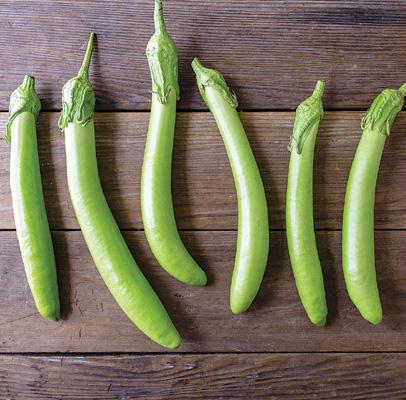
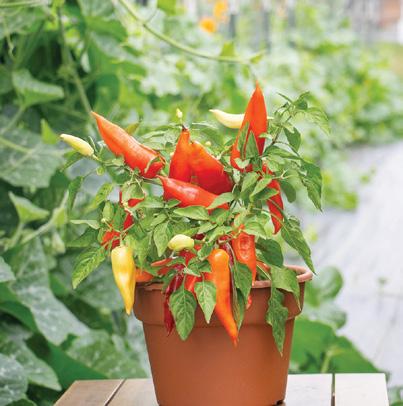
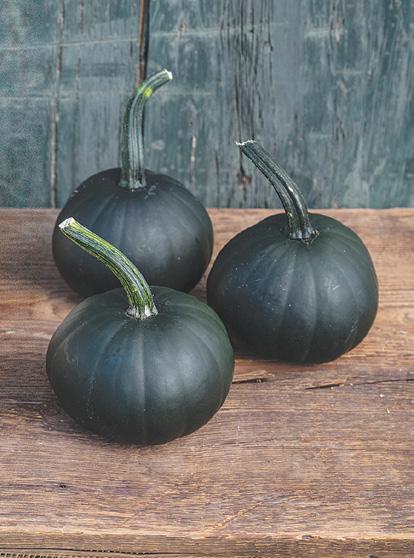



Eggplant ‘Summer Emerald’ (Solanum melongena). Has a reputation as one of the best-tasting eggplants ever. Nice and firm, sweet and tasty, with few seeds. Skin is thin and not bitter. And it's lime green! Johnny's.
Pea ‘Peas 'n' Pod Bernard’ (Legume psium). A petite pea plant with an “afila” vine, which means that it sticks to itself like velcro to keep the plant upright. Grow it in an 8 to 10-inch pot. You can expect 10 to 12 pods per plant. 12 to 18 inches. Pure Line.
Pepper ‘Cambuchi’ (Capsicum baccatum). Shaped like a flying saucer! It is spicy but not terribly so. 12 to 36 inches. True Leaf Market.
Pepper ‘Chaak’ (Capsicum chinense). A habanero pepper that is ready significantly earlier. Bright orange colour. Good production. 18 to 24 inches. Sakata.
Pepper ‘Ponky Peppers Sweet Caroline Red’ (Capsicum annuum). Petite plant fruits go from cream to orange to red, when they are at their sweetest. Looks great in a container. 12 to 18 inches. Pure Line.
Pepper ‘Prism’ (Capsicum annuum). Don't want a mini pepper or a bell pepper? This one is in between. Grows from light green through orange to red. 24 to

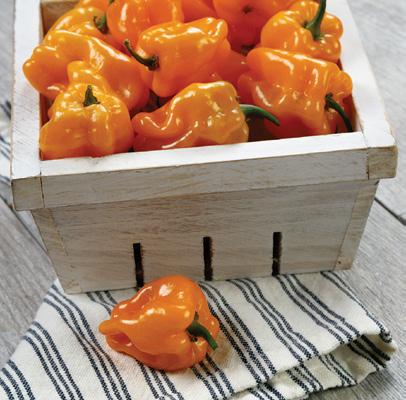

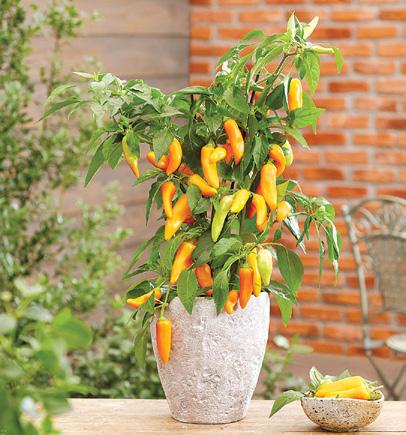
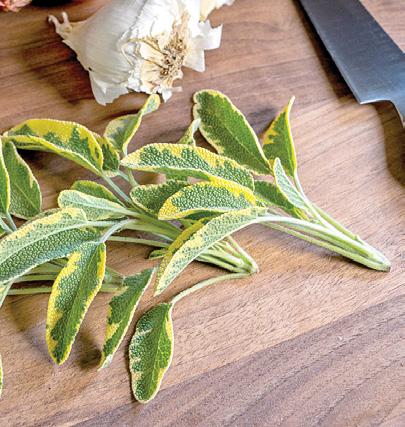

36 inches. PanAmerican.
Pepper ‘Sargento’ (Capsicum annuum). Big, dark green poblanos that ripen to deep red. Fruits are long and tapering, firm and straight, and mostly two-lobed. Vigorous plants. 24 to 36 inches. Sakata.
Pepper ‘Spicy Jane’ (Capsicum annuum). Starts out as a compact plant, then after the first harvest it will grow taller and spread wider, so know that if you have a long growing season. They are ripe when they turn yellow. 18 to 24 inches. Totally Tomatoes.
Pumpkin ‘Black Bear’ (Cucurbita pepo). Vegetable or ornamental? Maybe both. Fruits are 1 to 1.5 pounds and just about the blackest green imaginable. Johnny's.
Pumpkin ‘Fireball’ (Cucurbita pepo). Looks like a drawing of a pumpkin! Round fruits average around 9 pounds and have orange striping on light coloured base. 18 to 24 inches. Jung.
Sage ‘Celebration’ (Salvia officinalis). Colourful herb in green with gold margins. It's perennial and hardy to zone 4. 18 to 24 inches. Plant Haven.
Shiso ‘Ohba’ (Perilla frutescens). Green top and bottom. Shiso is a herb used in Japanese cooking and Eastern medicine. 24 to 36 inches. True Leaf Market.
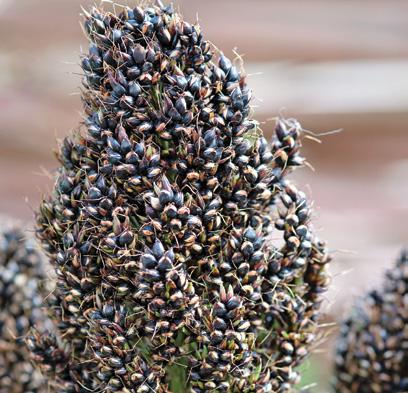


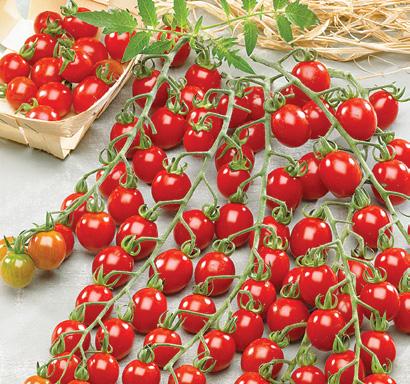


Sorghum ‘Black Falcon’ (Sorghum bicolor). Gorgeous black seedheads have few fibres. You can pop them like popcorn! 24 to 36 inches. Takii.
Tomato ‘Gondwana Rose’ (Solanum lycopersicum). Mildly sweet and mildly tart, these tomatoes start out green and turn to purply black. 24 to 36 inches. Victory.
Tomato ‘Harvest Moon’ (Solanum lycopersicum). Prettiest tomato in a while! Looks plain on the outside, but on the inside it has a red ring around yellow flesh. Indeterminate. Johnny’s.
Tomato ‘Rambler’ (Solanum lycopersicum). Red fruits of excellent size, texture and firmness. This is a great all-purpose tomato. 24 to 36 inches. Sakata.
Tomato ‘Tiny Temptations Orange’ (Solanum lycopersicum). You want a productive cherry tomato? Look no further. The fruits are sweet and ripen to sunny orange. 12 to 18 inches. Pure Line.
Tomato ‘Tutti-Frutti Cherry’ (Solanum lycopersicum). Very sweet with a “honey-umami” flavour. Fruits are red and perfect for snacking. 5 to 6 feet. Jung.
Tomato ‘Zenzei’ (Solanum lycopersicum). A tidy no-prune Roma-type tomato. Fruits are 4 to 5 inches long and really meaty and flavourful. Your plant will be covered in tomatoes. Does need staking or a cage.

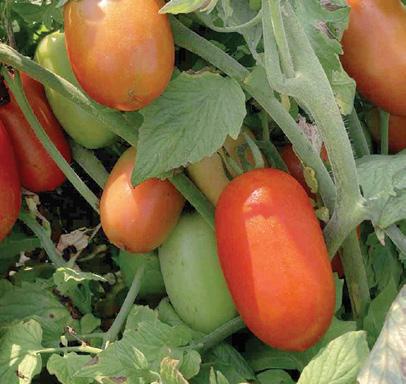



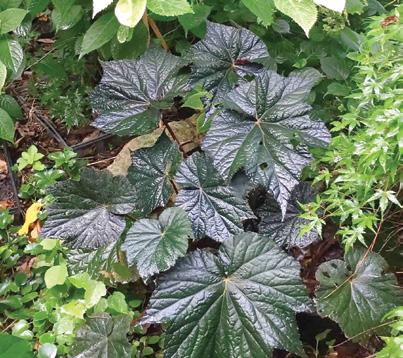
Height to 6 feet. Seminis Home Garden.
Watermelon ‘Golden Honey’ (Citrullus lanatus). Weighing in at 20 or more pounds, this watermelon has yellow flesh and sugary taste. And it should be ready for harvest in 85 days! Willhite Seed.
Yellow summer squash ‘Butterfingers’ (Cucurbita pepo). Spineless yellow squash on a semi-open plant with intermediate powdery mildew resistance. Johnny's.
Angelonia ‘Alonia BIG Cherry’ ( Angelonia). Nice upright habit in this early-blooming and heattolerant plant. Usually saved for containers, but this one begs for a spot in the garden bed. 12 to 18 inches. Danziger.
Angelonia ‘Archangel Ruby Sangria’ ( Angelonia). Lovely dark red colour and huge flowers, which stand out against dark green leaves. 10 inches. Ball.
Begonia ‘Lunar Lights Dark Side of the Moon’ (Begonia hybrid). This one earned its street cred through heavenly dark shiny foliage and delicate sprays of bright red blooms through the summer. It is actually a perennial if you care to overwinter it or if you are in zones 7 and up. Needs shade. 24 to 36 inches. Plant Development Services.


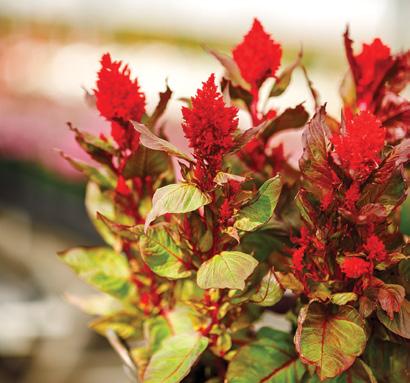



Begonia ‘Tectonic Caldera’ (Begonia silletensis). Giant glossy leaves – they can be 2 feet wide! – start out red and open to bright green. Can stay smaller in containers, but give this baby elbow room! Perennial if overwintered. 5 to 6 feet high. Monrovia.
Butterfly bush ‘Baby Buzz Candy Pink’ (Buddleja). A hanging butterfly bush! Blooms continually for five months. It will overwinter if you bury the pot in zones 6 and up. For anyone in lower zones, here is your chance to enjoy a beautiful pink buddleja. Remove spent flowers and feed to encourage re-blooming. Deer resistant! 18 inches high as annual, 24 inches as perennial. Plant Haven.
Canna ‘South Pacific White’ (Canna x generalis). Big creamy blooms last a long time on lush green foliage. Can display flowers continuously from mid-summer to fall. Must have plenty of sun! Lift the bulbs and store for the winter and you can enjoy it again next summer. Also new this year, ‘South Pacific Yellow’. 24 to 36 inches. Takii.
Cape daisy ‘Ballade Mix’ (Osteospermum ecklonis). Scrumptious daisy-like flowers in shades of pink, purple and white, with orange eyes. Stick them in a sunny bed and they will not disappoint. Under 12 inches. Eden Brothers.
Carnation ‘Capitán’ (Dianthus). A robust bloom in pink with a purple eye under its semi-double petals. Beau-
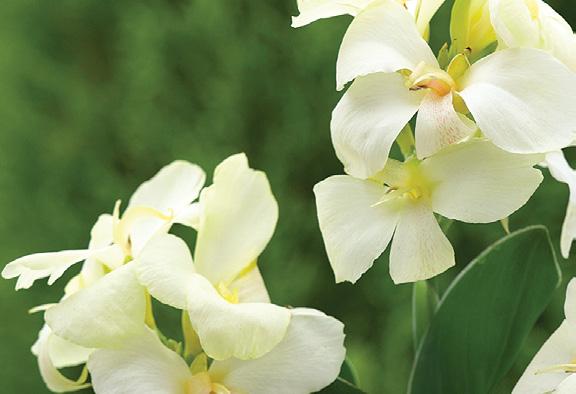
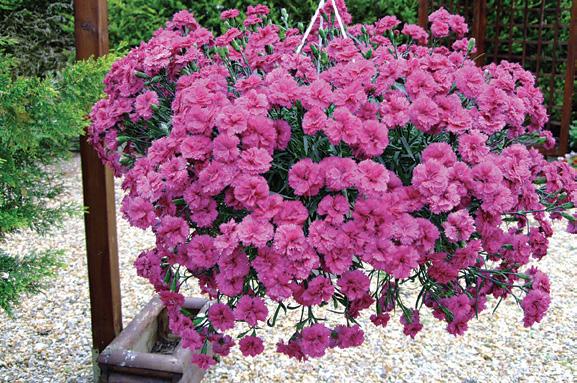

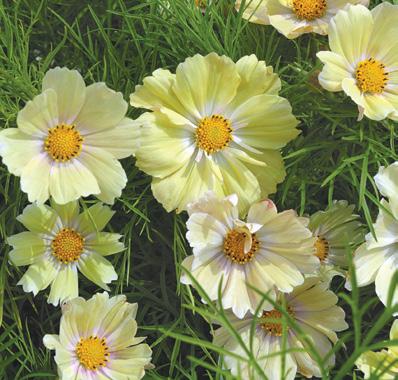
tiful 2-inch blooms on taller stems appreciates sun but will bloom indoors in a sunny room. Smells great and will survive a light frost. 12 to 18 inches. Selecta.
Carnation ‘Falling in Love Rosie’ (Dianthus). This very floriferous dianthus forms a mat over an area of the rock garden or drapes over the sides of a container. Puts out big pink flowers continuously. Short-lived perennial in zones 6 and up. 2 inches tall and 12 inches wide. UpShoot.
Celosia ‘Arrabona Bronze Leafed Red’ (Celosia plumosa). Plume-type celosia has maroon leaves and bright red flowers on branched stems. And… did you know the leaves are edible? 18 to 24 inches high. Hem Genetics.
Celosia ‘Burning Embers’ (Celosia plumosa). Bred for its beautiful bronze foliage with darker pink veining and pink, plume-like flowers. All America Selection judges noted that this one had the biggest and longest-lasting flowers of all celosia they trialed. Under 12 inches. AAS.
Colocasia ‘Redemption’ (Colocasia). Deep black leaves with pink centre that extends along the veins. Shiny, rippled finish. Lift the corms for repeat performance next year. 3 to 4 feet. Plant Development Services.
Cosmos ‘Sulphur’ (Cosmos bipinnatus). Light lemon yellow blooms look fresh and beautiful all the way until fall. Great foil to the usual pinks and whites. 3 to 4 feet. Rohrer.





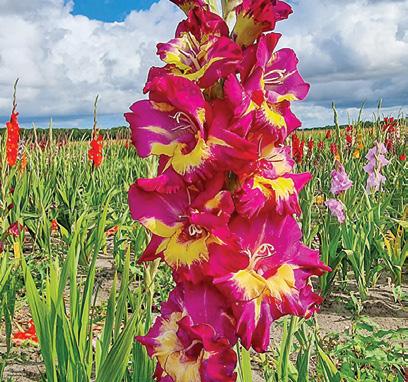
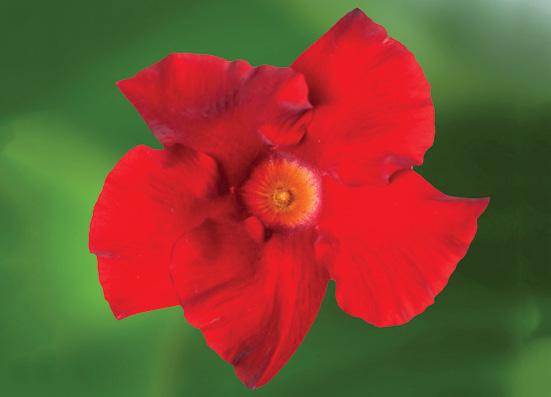

Cuphea ‘Sweet Talk Lavender Splash’ (Cuphea procumbens). A pretty little annual, perfect as a pollinator plant in the veggie patch or as an accent in the flower bed. It has tighter branching and flowers more than older cupheas. This is one of three colours; also comes in red and pink. Under 12 inches. PanAmerican.
Didiscus ‘Lace Blue’ (Didiscus caerulea). Haven't heard much about this plant yet, and never heard of it before, so we're interested. Online description says “Large powder-blue umbels, for cut and landscaping.” Apparently it is fragrant, likes full sun and requires deadheading. Intrigued! 24 to 36 inches high. Takii.
Fan flower ‘White Dove’ (Scaevola aemula). Looking at this plant from a distance, it's like it's made up of big white flowers with a green eye. In fact, it's a scaevola that goes all the way around in a circle. So pretty, and semi-trailing. Under 12 inches, spreads to 18 inches. Dummen Orange.
Foxtail fern ‘Myersii’ ( Asparagus densiflorus). You know that kind of spindly houseplant asparagus fern? This is not that. It's not a fern either. Big bushy fronds come out of the crown and rise up to see the world. Works in sun or shade. 18 to 36 inches. Proven Winners.
Geranium ‘Big EEZE Pink Batik’ (Pelargonium x interspecific). Pretty pelargonium with big light pink
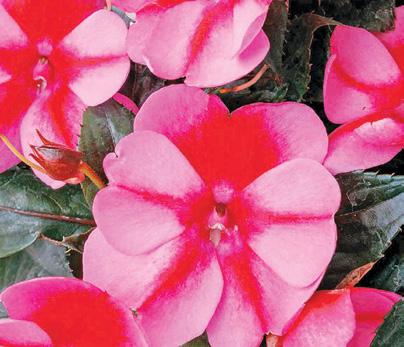
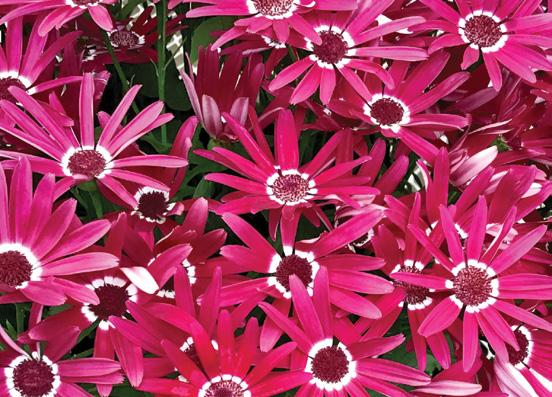
petals splashed with darker pink. Great for containers. 12 to 18 inches. All America Selection.
Gladiolus ‘Seashore’ (Gladiolus). Big 4-inch blooms in bright fuchsia splashed with yellow. Wowee! Dig the bulbs before freeze-up and replant next year. 36 to 48 inches. Breck's.
Impatiens ‘SunPatiens Compact Red Candy’ (Impatiens). Colour variation in an impatiens that can take sun or shade. Each petal is pink with a spreading red centre. 18 to 24 inches. Sakata.
Mandevilla ‘Madinia Petite’ (Mandevilla). If you've ever passed up mandevilla because it grows too long, here is your chance to get in on the fun of this floriferous vine. This one stays compact! Under 12 inches. Syngenta.
Ornamental pepper ‘Onyx Orange’ (Capsicum annuum). Almost black foliage is the backdrop to fruits that transition from purple to vibrant orange. Gorgeous! Under 12 inches. Takii.
Pericallis ‘Senetti Red Halo’ (Pericallis hybrid). The cool red of this daisy-shaped flower is new. Has a white circle surrounding a red eye. 12 to 18 inches. Suntory.
Petunia ‘Amazonas Plum Cockatoo’ (Petunia). Frilly petunia pairs greenish-cream flowers with dark purple eyes. 12 to 18 inches. Danziger Flower Farm.
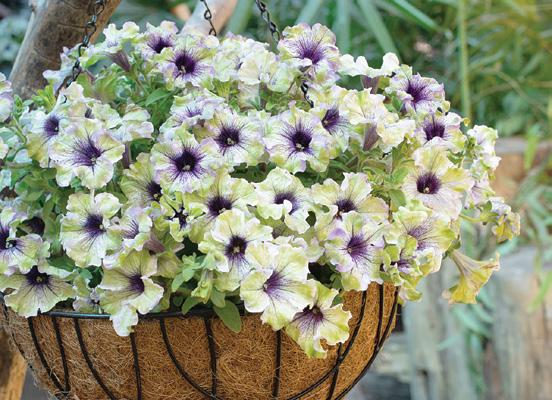
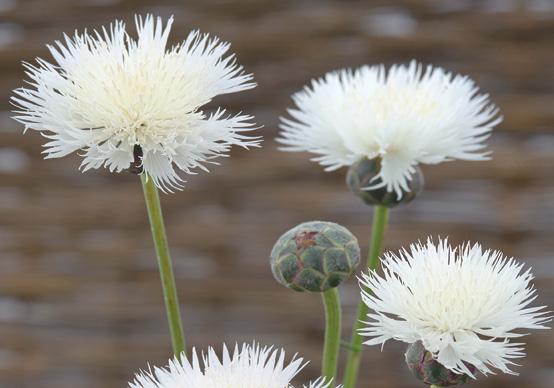
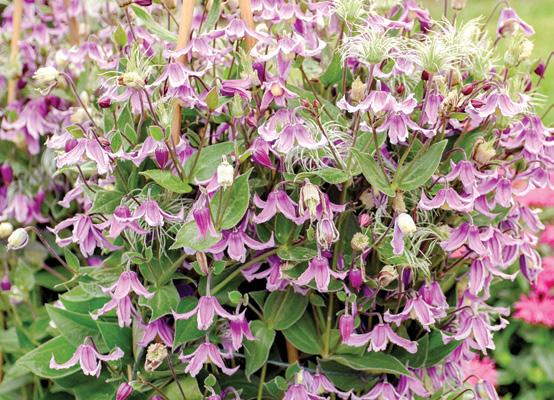
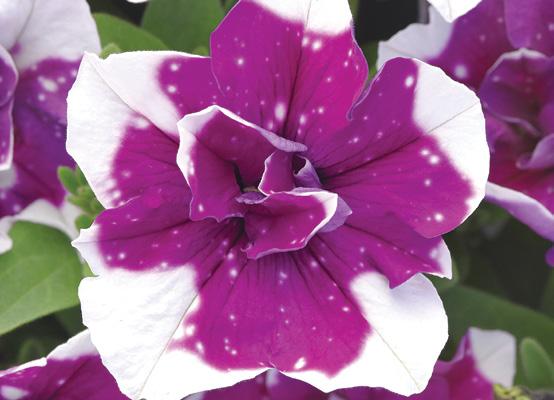
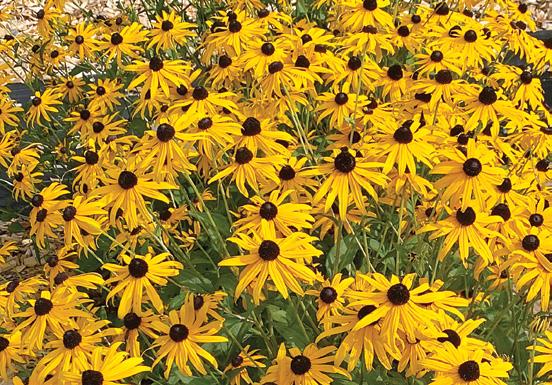

Petunia ‘Sweet Sunshine Magenta Sky’ (Petunia). The 'Sky' petunias, that look like they are covered in stars, have enchanted us the past few years. This year, they come out with one that is a double. 12 to 18 inches. Selecta.
Sunflower ‘Desire Red’ (Helianthus annuus). Wine-coloured petals on a deep dark centre in a dwarf sunflower. Blooms last into fall. 24 to 36 inches. Burpee.
Sweet sultan ‘The Bride’ (Centaurea moschata). Pure white flowers in spikey brilliance. 24 to 36 inches. Takii.
This section is divided into recommended zones for the plants listed. These zones are not written in stone. Look at the plants that are above your zone; you may be able to overwinter them! And, of course, look at plants below your zone because you can grow them.
In any case, trust your local greenhouse. If they say a plant is hardy in your area, trust them.
Black-eyed Susan ‘Mega Millions’ (Rudbeckia

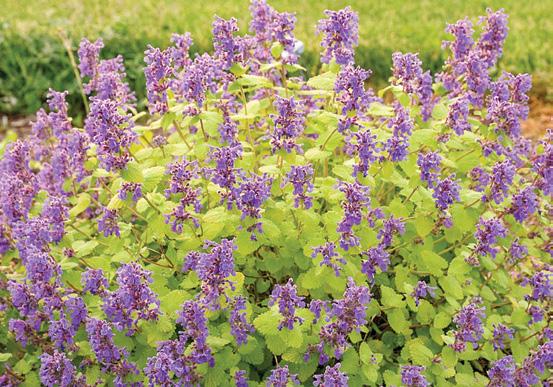

fulgida). ‘Goldsturm’ was the standard since 1937, but then along came septoria leaf spot. ‘Mega Millions’ is resistant and doesn't seed all over the place. In breeder's trials, one 3-year old ‘Mega Millions’ had over 1,000 more flowers than a 7-year old ‘Goldsturm’ in one season! 36 inches. Proven Winners.
Catmint ‘Chartreuse on the Loose’ (Nepeta). Lavender flowers all summer long on chartreuse foliage. Will continue to produce without cutting back. Under 12 inches. Walters Gardens.
Clematis ‘Stand by Me Pink’ (Clematis). Beautiful bell-shaped flowers in pink. Flowers early and reblooms, peaking in summer, followed by masses of beautiful seed heads. Dies completely to the ground for winter. 38 to 42 inches. Proven Winners.
Coneflower ‘Prairie Blaze’ (Echinacea). This purple coneflower has petals that run from pinkyred near the centre to lemon at the outside. And it is hardy to Zone 3! 12 to 18 inches. Syngenta.
Hosta ‘Shadowland Love Story’ (Hosta). Typical old hosta shape with nice colouring: chartreuse and cream centres with green margins. According to grower Proven Winners, “A gentle piecrust wave edges each leaf.” The flowers are white. 14 to 16 inches. Proven Winners.
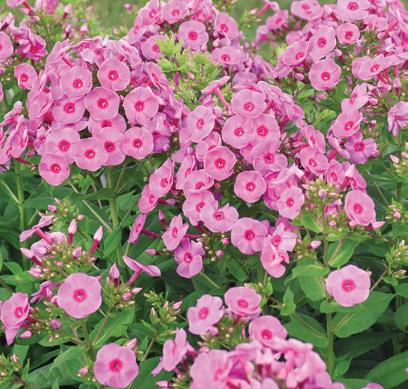
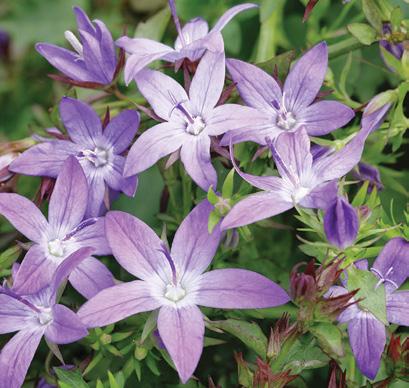




Phlox ‘Luminary Prismatic Pink’ (Phlox paniculata). Straight standing pink flowers with a darker pink eye. 32 to 34 inches. Proven Winners.
Veronica ‘SeaSide’ (Veronica spicata). Lots of blue spires on this great performer. It is coastal friendly and salt tolerant. Blooms July through August. 24 to 36 inches. Eason Horticultural Resources.
Sedum ‘Rock 'n Grow Midnight Velvet’ (Sedum). Foliage is a melange of purple, green and brown and flowers are a beautiful red. 22 to 26 inches. Pro ven Winners.
Artemisia ‘Silver Lining’ ( Artemisia). A new shape of artemisia! And it's hardy to Zone 4, but happy enough as an annual otherwise. 12 to 16 inches. Proven Winners.
Bellflower ‘Purple Fountain’ (Campanula poscjarskyana). When is the last time you thought of campanula? This one has cascading foliage and is covered in lavender blooms shaped like stars. Put it in a hanging basket, let it climb over the edges of a container, or have it scramble over a rock garden. Under 12 inches. Monrovia.
Bergenia ‘Peppermint Patty’ (Bergenia). Lovely flowers in white edged in pink, with a matching pink throat. 22 inches. Proven Winners.
Coneflower ‘Double Scoop Deluxe Watermelon’

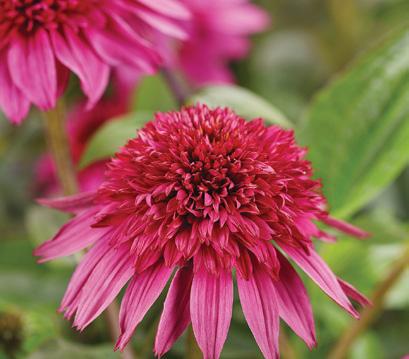

‘Fun and Games Capture


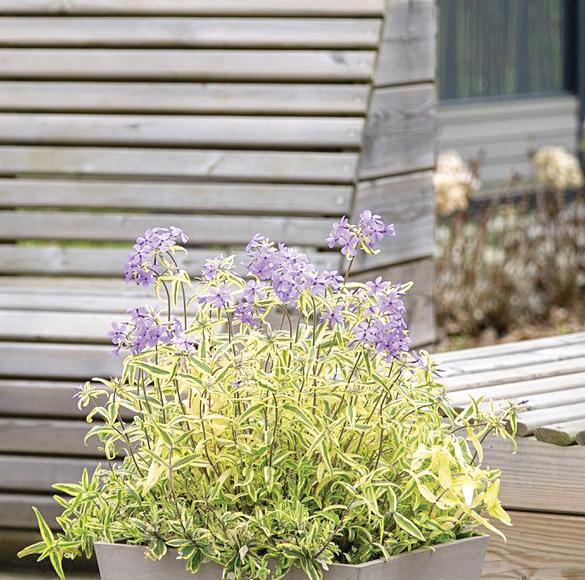
(Echinacea). The latest in the series that features a mophead above longer petals, this one is an improvement on the original ‘Double Scoop Watermelon’, with more branching and more flowers. 18 to 24 inches high. Darwin Perennials.
Daylily ‘See You Tomorrow!’ (Hemerocallis). Yellowy green blooms on this daylily are not what the excitement is about. It's about the fact that the flowers last a full five days! Grower will only say it's hardy to Zone 4. 12 to 18 inches. Monrovia.
Coneflower ‘Sunseeker Rainbow’ (Echinacea). Very nice lemony colour on this double echinacea, with green tips. 18 to 24 inches high. Jung.
False indigo ‘Decadence Deluxe Perwinkle Popsicle’ (Baptisia). Later to flower than most baptisia, this one waits until the others have disappeared to open up its glorious dark blue blooms. 48 inches. Proven Winners.
Heucherella ‘Fun and Games Capture the Flag’ (Heucherella). Big, maple-shaped leaves on this one! Chartreuse with a burgundy centre. Blooms in white. Likes the shade! 8 to 10 inches, spreads to 18 inches. Proven Winners.
Phlox ‘Blue Ribbons’ (Phlox divaricata). Variegated foliage and violet flowers on this one make a statement. It will take a bit of shade. Under 12 inches. UpShoot.

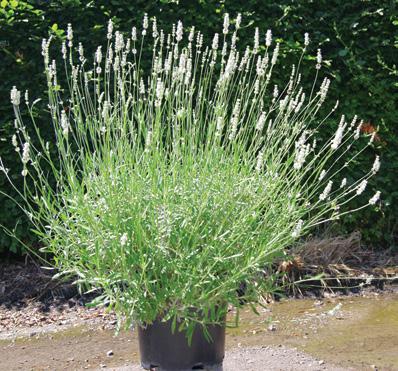
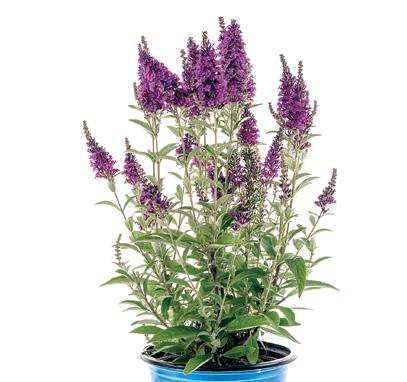

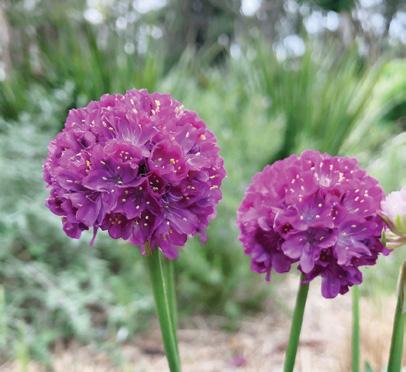
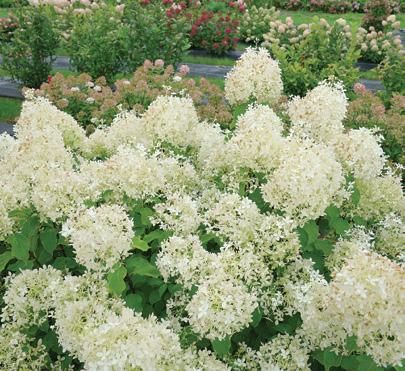
Pineberry (Fragaria hybrida). Small yellowy strawberries flavoured like pineapple. Seeds are red. Under 12 inches. Jung.
Primula ‘Blue Ripples’ (Primula vulgaris). Big violet flowers with a white margin. Try it in a container or in your garden. 5 to 8 inches. Proven Winners.
Primula ‘Mandarin’ (Primula vulgaris). These flowers are just as big as ‘Blue Ripples’ and they are doubled. A very orangey yellow. 5 to 8 inches. Proven Winners.
Zone 5
Fountain grass ‘Water to Wine’ (Pennisetum alopecuroides). Sturdy upright with black to cinnamon inflorescences, the grass starts bright green then mellows to tan. The form persists through winter. 24 to 36 inches. Must Have Perennials.
Lavender ‘Exceptional Hillav’ (Lavandula x intermedia). White flowers on this lavender make a very nice contrast to the classic purple. Remarkable rugged, easy to grow and sweet smelling. 24 to 36 inches. Concept Plants.
Sea thrift ‘Dreameria Vivid Dreams’ ( Armeria pseudarmeria). As a frost-to-frost flower, we expect this beauty to be available in lower zones as an annual before too long. Big ball-shaped clusters on sturdy stems in bright purple. Under 12 inches. Darwin Perennials.
Sweet box ‘Sweet and Lo’ (Sarcococca hookeriana). This is a new one for many of us! It has clusters of skinny flowers in white tipped with hot pink and shiny evergreen foli-
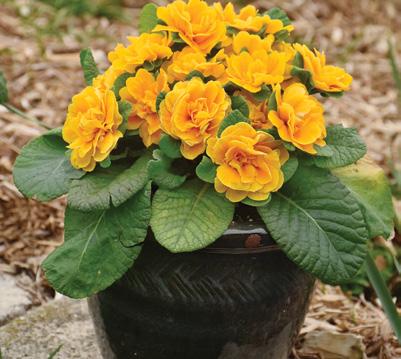
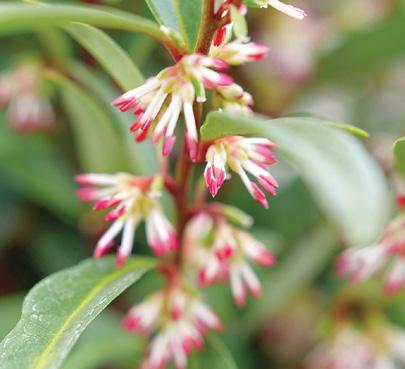




age. It smells like jasmine and it likes part to full shade. 18 to 30 inches. Proven Winners.
Wallflower ‘Erysistible’ (Erysimum linifolium). Flowers start out orange and fade to purple at different times. The colour really is irresistible. 18 to 24 inches. Syngenta.
Butterfly bush ‘Birthday Cake’ (Buddleja). The blooms stand straight up, like candles on a birthday cake! Compact and beloved by pollinators. Bloom size up to 8 inches long. 6 feet. Bloomin' Easy.
Hydrangea ‘Puffer Fish’ (Hydrangea paniculata). Big puffy white flowers nearly block out the foliage! They turn lime as they age, then a fresh sprig of white flowers emerges from the tip of the panicle. 3 to 5 feet. Proven Winners.
Hydrangea ‘Tiny Quick Fire’ (Hydrangea paniculata). A dwarf form of 'Quick Fire', a hydrangea that blooms early in white and then ages to a beautiful pinky red. And it maintains its short stature! 18 to 36 inches. Proven Winners.
Ninebark ‘Honeycomb’ (Physocarpus opulifolius). Brilliant chartreuse foliage that holds its colour all summer. White flowers bloom in fall above golden leaves for beautiful contrast. 5 to 7 feet. First Editions.


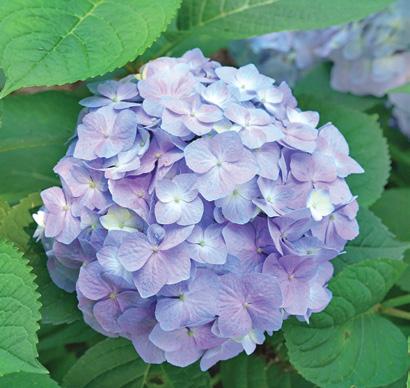

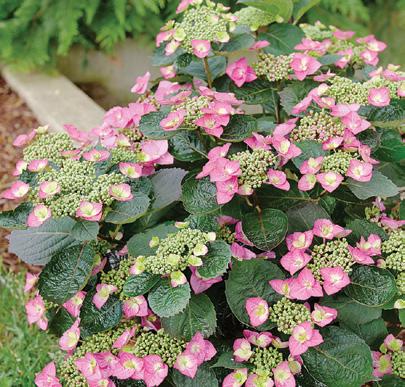


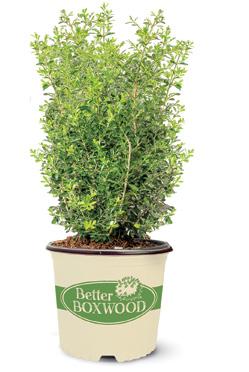
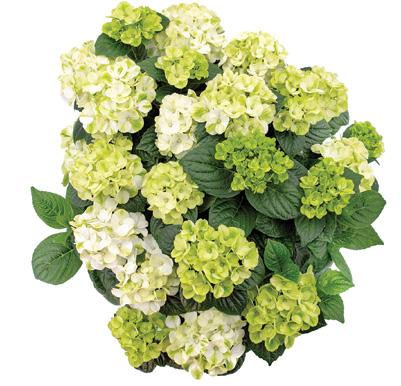

Rose ‘Oso Easy Ice Bay’ (Rosa). Pretty white semidouble flowers that bloom continuously all summer. Disease resistant. Deadheading is not necessary. 24 to 36 inches. Proven Winners.
Hydrangea ‘Let's Dance Sky View’ (Hydrangea macrophylla). The grower recommends planting this in acidic soil to turn it blue because it is just stunning, but we think it's mighty pretty in pink too! 24 to 36 inches. Proven Winners.
Hydrangea ‘Sweet Starlight’ (Hydrangea paniculata). Panicles start out white and age through light to deep pink. 3 to 4 feet. Star Roses and Plants.
Hydrangea ‘Tuff Stuff Top Fun’ (Hydrangea serrata). A lacecap with bright burgundy stems and tiny green florets at the centre and pink flowers around. Blooms on old and new wood. 24 to 36 inches. Proven Winners.
Rose ‘Easy Bee-zy Knock Out’ (Rosa). Fragrant yellow flowers bloom repeatedly all season. 3 to 4 feet. Star Roses.
Rose ‘Flavorette Honey-Apricot’ (Rosa). If you've never eaten roses, now is the time to try! This one is bred for eating, but it is just as gorgeous in the garden as on the plate. It is also fragrant and reblooms without deadheading. 5 to 8 feet, but we think shorter in the lower zones. Proven Winners.
Rose mallow ‘Summerific All Eyes on Me’ (Hibiscus hybrid). Blooms are a huge 8 inches across in pink with a


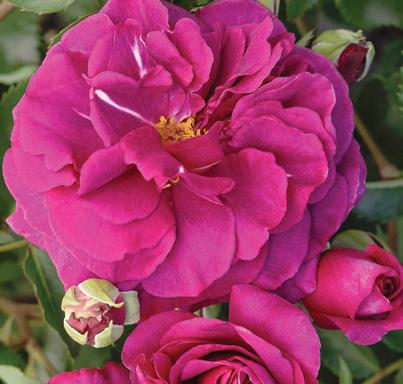
red eye and dark green leaves. This hardy hibiscus stays shorter than its cousins. 42 inches. Proven Winners.
Boxwood ‘Better Boxwood Skylight’ (Buxis hybrid). Scientifically bred over two decades to be blight resistant. This is one in a collection of the first plants to be bred in this particular way to resist boxwood. 6 feet. UpShoot.
Hydrangea ‘First Editions Eclipse’ (Hydrangea macrophylla). Dark purple leaves and cranberry-edged blooms for dramatic impact. A real beauty. 3 to 4 feet. First Editions.
Hydrangea ‘Grin and Tonic’ (Hydrangea macrophylla). This one has flowers that emerge lime green and mature to white. Improved sun tolerance. 24 to 36 inches. Van Belle/ Bloomin' Easy.
Hydrangea ‘Let's Dance Lovable’ (Hydrangea macrophylla). Very floriferous! Blooms on old and new wood. Flowers are pink, purple or blue, depending on pH of the soil. 36 to 48 inches. Proven Winners.
Quince ‘Double Take Eternal White’ (Chaenomeles speciosa). Blooms in late spring with flowers that look like single creamy roses that really last. It's on the shorter side, so works perfectly in a mixed border. 24 to 48 inches. Proven Winners.
Rose ‘Eau de Parfum Berry Rosa’ (Rosa).

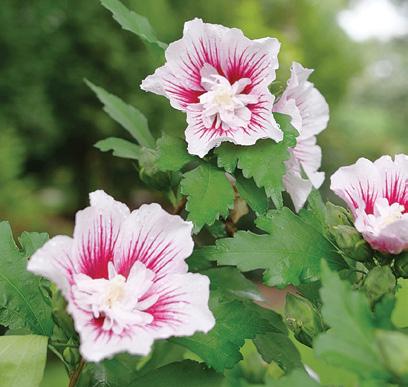
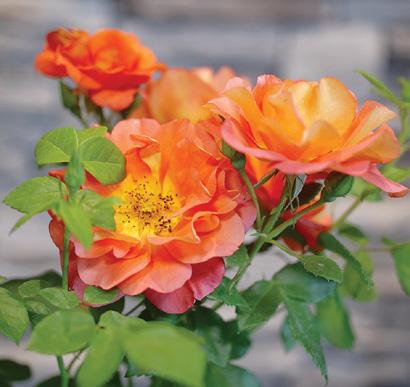


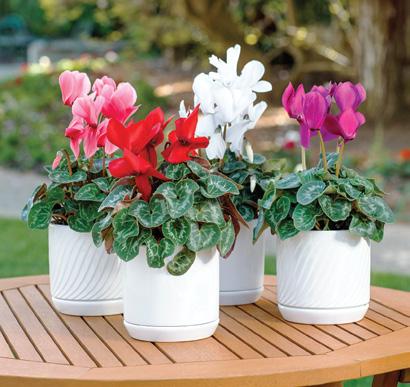
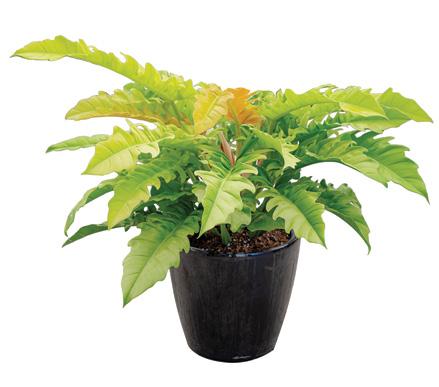


Rose ‘Itsy Bitsy Peach’ (Rosa). Smaller rose with abundant peach blooms. 18 to 24 inches. Monrovia.
Rose of Sharon ‘Starblast Chiffon’ (Hibiscus syriacus). Wide white flowers with a burst of hot pink in the centre; coming out of that hot pink is a fully doubled white centre. The flowers really last. 8 to 12 feet. Proven Winners.
Rose ‘Rise Up Emberays’ (Rosa). Lovely warm colours of orange and yellow glow through the summer then soften to pale pink and fold up. 36 to 60 inches. Proven Winners.
Rose ‘Sunblaze Sweet Mini’ (Rosa). Clusters of pink double roses on a miniature shrub perfect for pots. 12 to 18 inches. Edmunds Roses.
Holly ‘Red Sky’ (Ilex crenata). Here's one for the warmest-season gardens that is a stunner. The growth starts out reddish before going emerald green and it features black berries. Over 6 feet. Plant Development Services.
Alocasia ‘Jacklyn’ ( Alocasia). A gorgeous big-leafed plant with purple mottling on the petioles and texture like an elephant's skin. It's been around for a while but this is the first time it's being offered for commercial sale to folks like us in North America. 3 to 4 feet. Costa Farms.
Alocasia ‘Silver Velvet’ ( Alocasia reginae). Just beautiful.
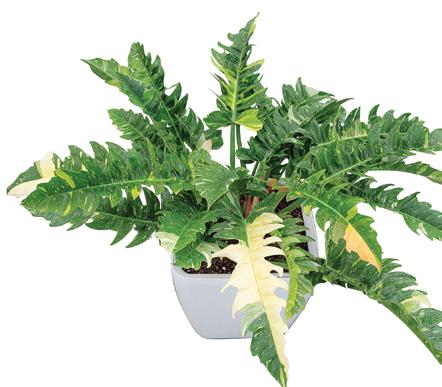
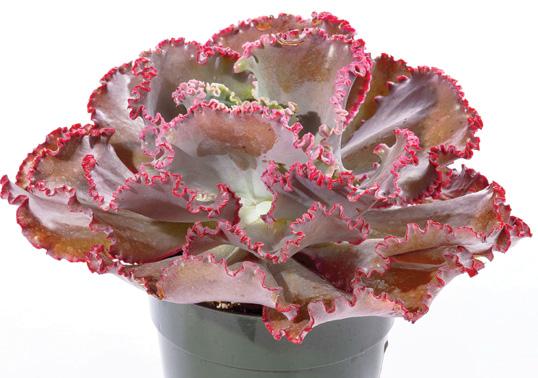
The big silvery leaves have burgundy shade beneath and grow up to a foot long. 3 to 4 feet. Costa Farms.
Cyclamen ‘Eco’ (Cyclamen persicum). These indoor beauties flower faster and better than most compact cyclamen. Under 12 inches. Syngenta.
Dieffenbachia ‘Crocodile’ (Dieffenbachia). Typical variegated dieffenbachia, but the ribs of the leaves have a ruffled crest on the underside! Easy to care for. Over 6 feet. Costa Farms.
Philodendron ‘Golden Crocodile’ (Philodendron). Big serrated leaves start out copper and mature to golden green. 24 to 36 inches. Costa Farms.
Philodendron ‘Ring of Fire’ (Philodendron). Big serrated leaves on this one that are dark green streaked with cream. It is a rare plant but it's easy to grow. 3 to 4 feet. Costa Farms.
Philodendron ‘Tortum’ (Philodendron). This is one for collectors. A philodendron with finely dissected foliage. Can climb to 6 feet. Thrives in bright light. Over 6 feet. Costa Farms.
Spider plant ‘Variegatum’ (Chlorophytum comosum). A little different from the typical spider plant: it is green with white edges. Who can resist something different? 12 to 18 inches. Proven Winners.
Wax plant ‘Coral Reef Red’ (Echeveria gibbiflora). Extremely ruffled leaves come in brownish foliage with red picottee edges. Shade tolerant. Under 12 inches. Green Fuse Botanicals. h

If there is a word to describe this year’s container designs by Proven Winners, it is eclectic. This year, most of their designers have mixed colours in an unprecedented way.
This company has chosen three container recipes as winners for the year. The first combination is named Polar Peach and features a combination ‘Supertunia Mini Vista’ in purple and mauve; warm peach-coloured double calibrachoa ‘Superbells Double Amber’; and mauve and white verbena ‘Amethyst’.
The second is Sunshine State, described as a vibrant mix. It contains ‘Coral Sun’ calibrachoa, ‘Whirlwind Blue’ scaevola and a bright yellow lantana, ‘Goldengate’.


If planting in a pot rather than a hanging basket, they suggest adding the grass ‘Queen Tut’, as a thriller. Finally, the focus turns to non-flowering caladium, a combination of peach and green, ‘Heart to Heart Chinook’, a blushing leaf edged in green, and ‘White Wonder’, a pale green rimmed with dark emerald. This combo is called Instinct.
The monotones
A pot arrangement called Crisp and Clean is a mix of hues bordering on white: ‘Angel Wings’ lamb’s ear, ‘White Licorice’ licorice plant and ‘Pink Cashmere’ verbena. It will have you drifting off on a sea of daydreaming. On the darker side is ‘Called Your Bluff’. Using ‘Angel-

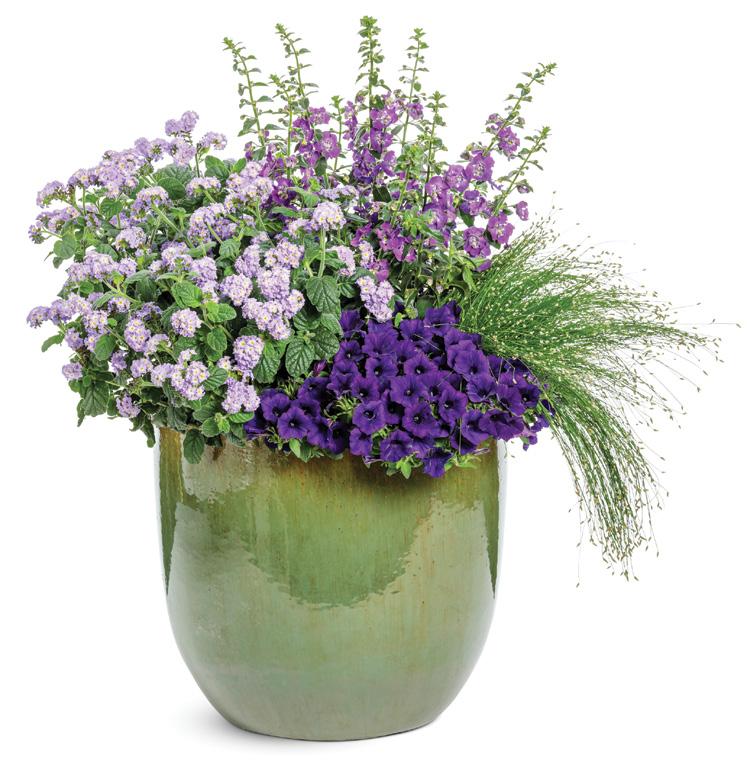
face Blue’ angelonia, delicate ‘Augusta Lavender’ heliotrope, and ‘Mini Vista Ultramarine Supertunia’, this pot of purples gets a little jolt from a shock of ‘Fiber Optic Grass’.
The single plant
Look for the vibrant multi-toned verbenas. There are some lovely and unusual combinations worth a second glance. I seldom see them potted alone as they are usually forced to play second fiddle to the petunia and calibrachoa stars, but some of the new ‘Superbena’ varieties could easily steal the show on their own.
To add to the vibrancy, there is a new calibrachoa, ‘Superbells Double Redstone’ with a variegated orange and gold double blossom that will sing in a sunny spot.
Scaevola is a showstopper all on its own, mainly because of its pretty fan-shaped blossoms. You don’t see

this plant too often, so it is always a novelty. It comes in mauve and white.
I am a great fan of sun-tolerant begonias, which require little if any deadheading and bloom profusely until frost hits. There are so many hybrids now it is difficult to single out any favourites. They all perform very well, but ‘Solenia Apricot’ will provide competition for the sun with bright gold highlighting orange double blooms.
And for a shady corner, it’s hard to beat rex begonias. There is one called ‘Bewitched Night Owl’ with scalloped pointy leaves and stormy colours that holds me in thrall.
Finally, coleus fans will be thrilled at the variety and the intensity of colours available this year. Leaf shape is fascinating, too, and one that caught my eye is ‘Color Blaze Cherry Drop’, with its lobed leaves of burgundy finely rimmed with green. h
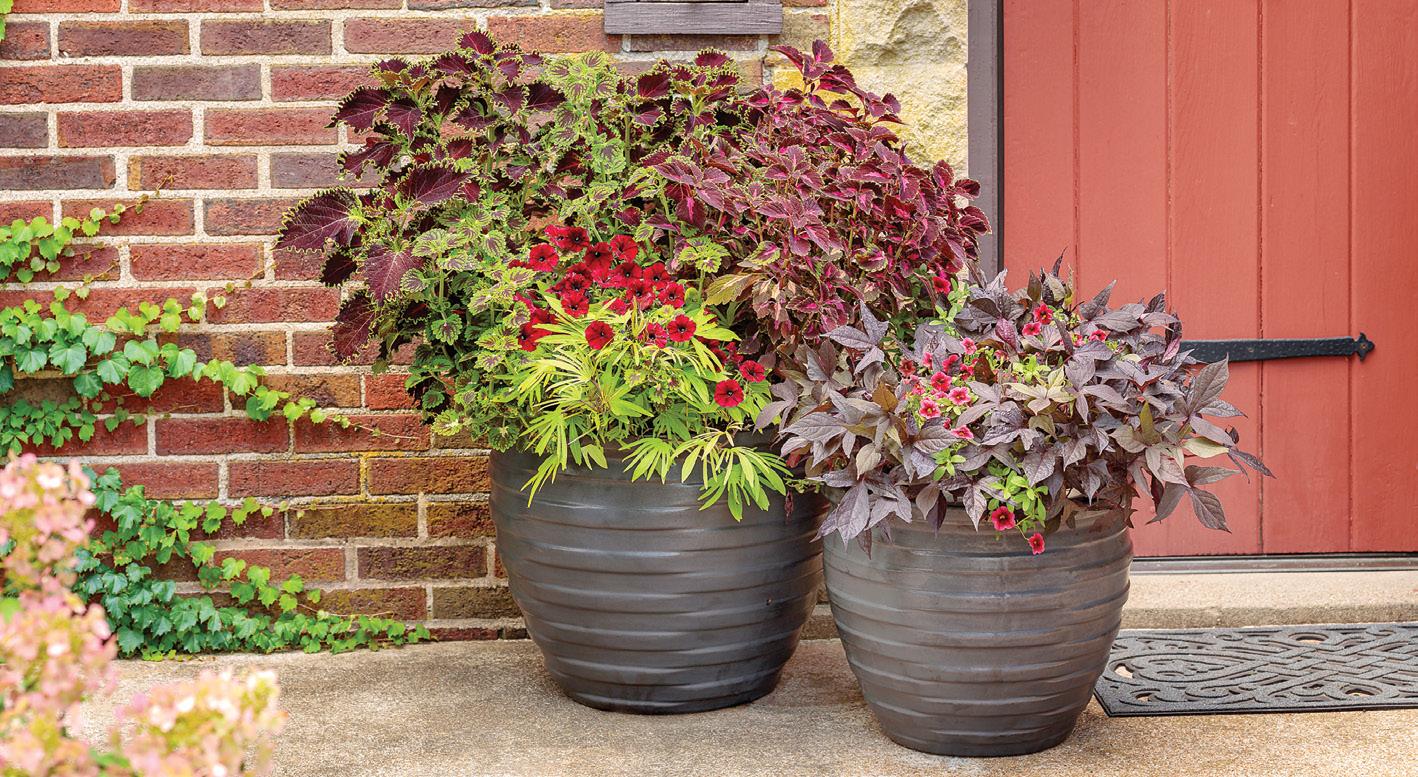
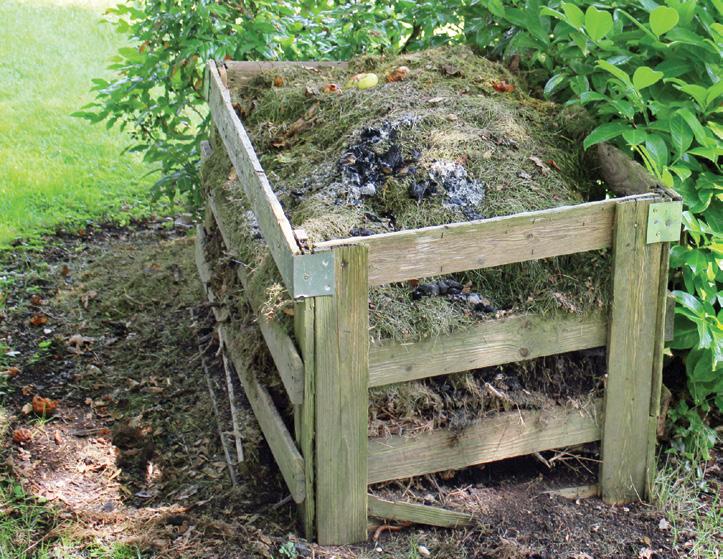
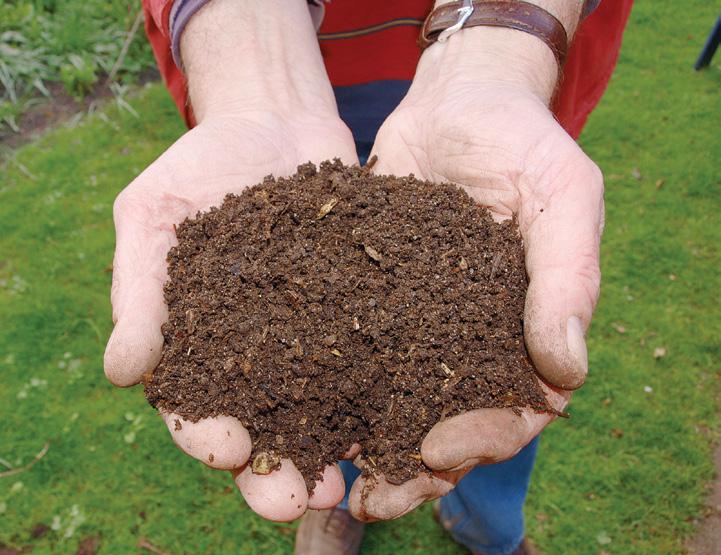
As they say, too much of a good thing is not a good thing. So, it is with compost.
Too much compost can poison plants, especially if you have been adding heavy amounts over a number of years. Salts can build up in the soil just as they do if you over fertilize your houseplants (you’ll see a white ring on the outside of clay containers, for example. At that point, you are encouraged to take the plant to the sink and give it a thorough watering, letting it drain well. You are washing away harmful salts).
Vegetable gardens are especially sensitive to too much compost and plants may not thrive but become stunted in an over-composted mixed soil.
Even using compost, it may still be necessary to fertilize with the macro nutrients, nitrogen, phosphorus and potassium (often expressed as NPK). Undernourished plants may show signs

Check out this web page to hear Shauna Dobbie talk with Robert Pavlis about composting.

https://localgardener.net/flora-amp-fauna-episode16nutrients-in-the-garden-with-robert-pavlis/
of primary nutrient deficiency with yellowing leaves or stunted growth and lack of fruit. Compost may not replace the primary NPK nutrients in large enough measure to make a difference, although it does deliver some important trace nutrients. What compost does is condition the soil and introduce organic materials that feed the soil’s bacteria, fungus and other microscopic life whose digestion releases nutrients in a form plants can use.
Many people make their own compost, and it is not hard. You just have to remember to balance the amount of “green” material with the amount of “brown”.
Green compostables include fruit and vegetable scraps and peelings, coffee grounds, eggshells, leaves, grass, and weeds – be sure the weeds are seed free. Brown compostables include paper and newspaper (but not glossy paper and shred uncoated paper and newsprint to encourage it to break down), sawdust, small twigs and branches – chop them up. You need a 50 percent mix of each green and brown materials.
Don’t add pet or human feces, dairy products, oils and fats, fish, eggs, poultry, treated wood or diseased plants. These items can introduce harmful bacteria, attract rats and cause odour.
The other two ingredients in making compost are water and air. Keep your
General NPK plant needs: 7-1-6. (This varies by plant.)
Typical homemade compost has an NPK of 3-0.5-1.5.
Commercial composted manure NPK is typically 1-1-1.
This means that plants need seven times as much nitrogen as phosphorus. Neither compost nor composted manure gives them that.
Your soil probably doesn’t need phosphorus, and one issue is that unused
phosphorus tends to stay in the soil. (Nitrogen unused by plants is continually changing form, and much of it leaves the soil as a gas, dispersed into the air.)
Too much phosphorus makes it difficult for plants to take up manganese and iron. You see this as yellowing of the leaves (chlorosis). The common recommendation for chlorosis is to add iron chelate, but if the soil already has too much phosphorus, more iron won’t help. When phosphorus gets too high, it
also poisons mycorrhizal fungi, which are really important in aiding plants to take up water and, oddly enough, phosphorus.
The takeaway? Don’t keep adding more and more and more compost. Don’t plant directly into compost. Use 1 to 2 inches per year for ornamental plants and as much as 3 inches per year for vegetables. This differs from the advice in the main article; gardening is full of contradictions!

compost pile moist but not sodden and turn it every week or so to introduce air. You will know it is working when the centre of the pile becomes warm.
You can also buy composted manure collected from herbivores: cows, horses, llamas, goats, even rabbit and chicken droppings. Sheep manure is quite popular and is often an ingredient in commercial composts. Mushroom compost contains fewer nutrients but is light and a good soil conditioner, especially for heavy clay soils.
So how much should be used? Add 1 to 2.5 inches to the top 6 inches of garden soil in springtime. If you like, you can add a thin layer in the fall to break down over winter.
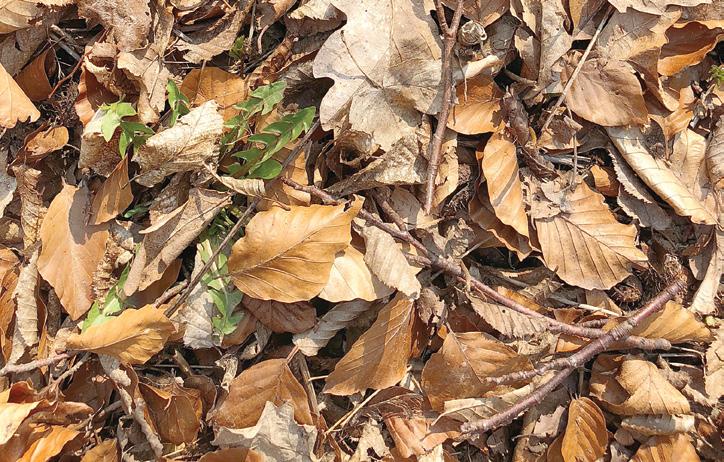
For lawns, you may wish to add a very thin layer to the lawn both spring and fall and I mean thin – one cubic yard to every 1,000 square feet or a quarter inch or so, raked in evenly.
For containers, advice varies wildly, and some suggest 40 per cent compost to 60 per cent potting mix. I think this is overdoing it and would err on the side of caution. I would mix one part compost to 19 parts potting mix. And certainly, no more than 20 percent compost.
It is also a good idea to add some topsoil to potting mix – not much is needed but it will introduce the bacteria and other tiny life that will help your compost work. It will also help
maintain moisture levels. Cocoa husk (coir) is also a great way to introduce organics and keep pots from drying out too quickly. Once again, don’t use too much – one part coir to seven parts soil and potting mix seems about right.
Be observant. Local conditions always dictate the correct answer. If your plants are thriving, you are doing the right thing.
One last thing: Compost needs to be renewed periodically. Some renew it every year (remember to keep the application light), others add compost on alternate years. Once again, your good sense and keen eye will be the best expert in your garden. h



As someone who grew up on a bustling farm, the idea that “you can take the girl out from the farm but never the farm out of the girl” was impossible to skip! In 1975, with my husband, Frank, we purchased our new home in South Edmonton. So, with no surprise, we chose a fair-sized lot and this became the makings of my “little piece of country”. I recall riding in the back of a truck bringing home a sizeable assortment of birch trees and evergreens. This marked the start of filling the blank landscape with trees. Over the years these have been replaced with other species of trees, ever changing shrubs, perennial and potted plants.
Every April, I go to a local nursery’s “Basket Days” where I buy their bedding plants. I then arrange and plant them in the many planters that I bring. They supply the soil, fertilizer and care for them in a heated greenhouse until the May long weekend. It is amazing how beautiful and lush they become with this head start in a controlled environment. In the late

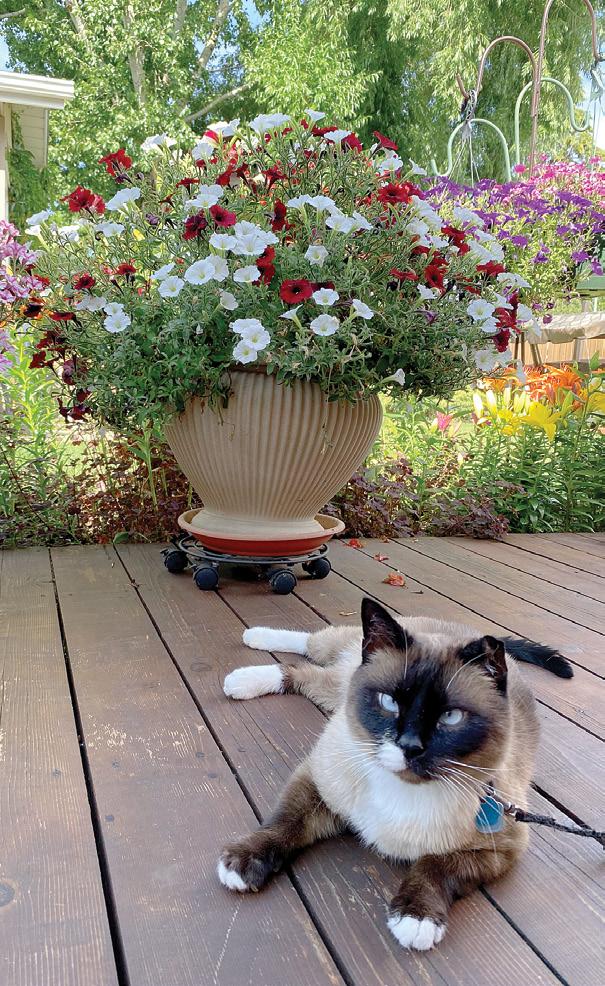
surveys his surroundings.

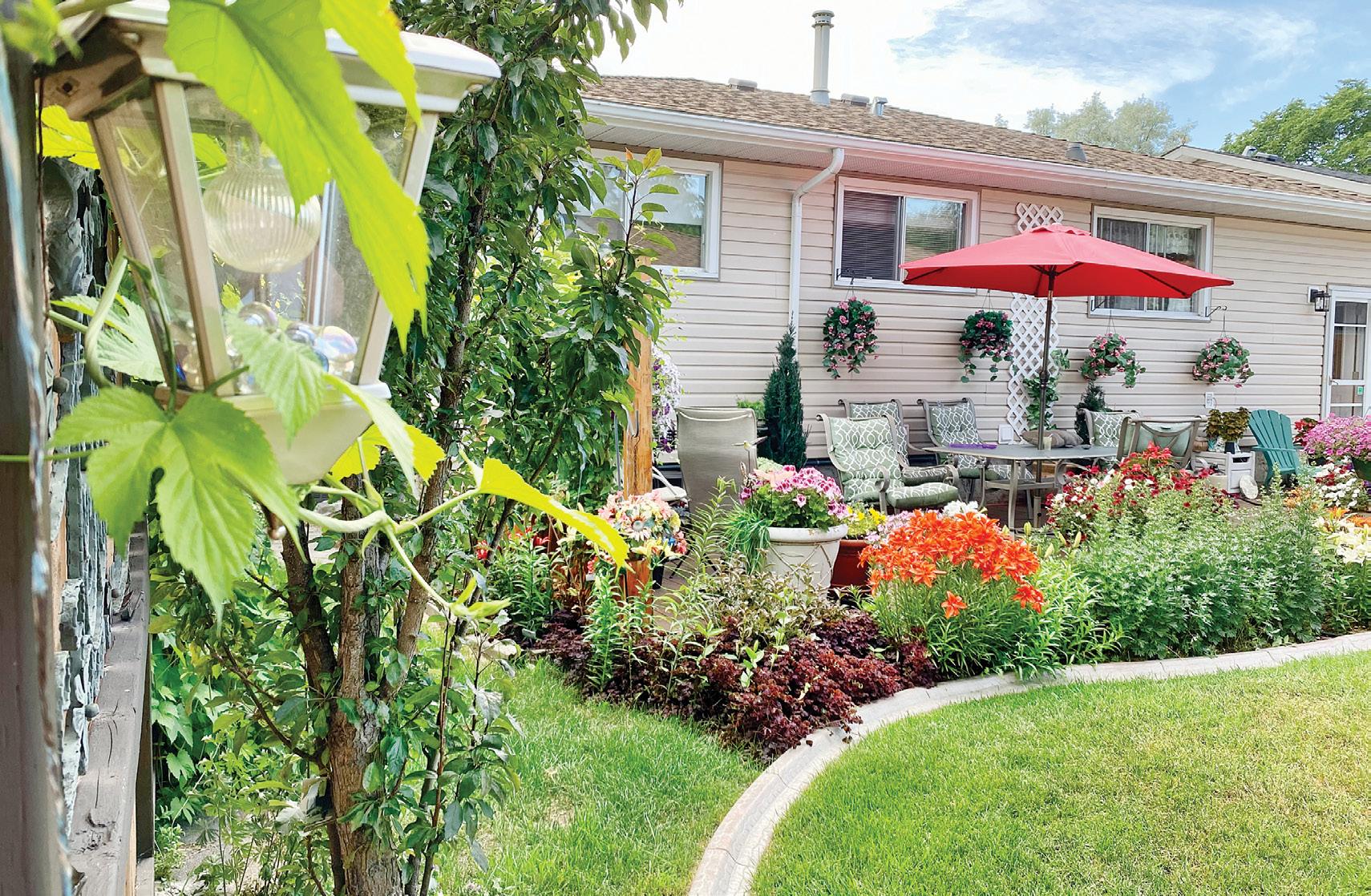

winter, I also order some hanging planters with my choice of colours from another greenhouse which also keeps them until the May long weekend.
There is a different view of the yard no matter where you sit. You could say that we are either chasing the sun or the shade here in comfort. Weather permitting, I spend every day with my morning coffee and breakfast out there, with the relaxing sound of water trickling down the water fountain in the background. It is always a pleasure to see flowers and trees bursting into bloom in the spring as winters in Edmonton can be quite harsh.
A deck running along the full backside of the house gives a view of the whole yard including a swing that provides views of the deck with its many flowerpots, water fountain, patio table and chairs and lattice trellis at the deck’s end. Growing behind the trellis are a variety of lilies and clematis vines that climb over the top. More lilies, monkshood and weigela grow along side of the deck. It is always dense, vibrant and lush.
There is a view of the Virginia creeper that has been invited to grow along one side of the garage with a collection of perennials beneath it. Hop vines climb along the fence. The lilacs bloom profusely at the end of the swing and beside another grouping of plants and bird feeders.
When I retired, I decided to plant more varieties of lilies each year. They are hardy in this area and their foliage is lovely all season long. I enjoy perusing the gardening catalogues before ordering different varieties of lilies to plant each spring or fall. A few years after I started was about the time the lily beetles started munching away in our area, but using a variety of ways, I get the better of them every year! Behind the garage is another swing from where you can view what I call my Secret Garden because it is hidden behind the garage and surrounded by fences. Beside it and at the end of the yard are two huge trees, a poplar and a willow. They have become enormous and had started to shade the garden, so I planted shade plants (mostly hostas) on the shadiest side. The other side gets enough sun for a vegetable garden with hop and clematis vines climbing on the fence.
I have planted many varieties of perennial shade plants over the years
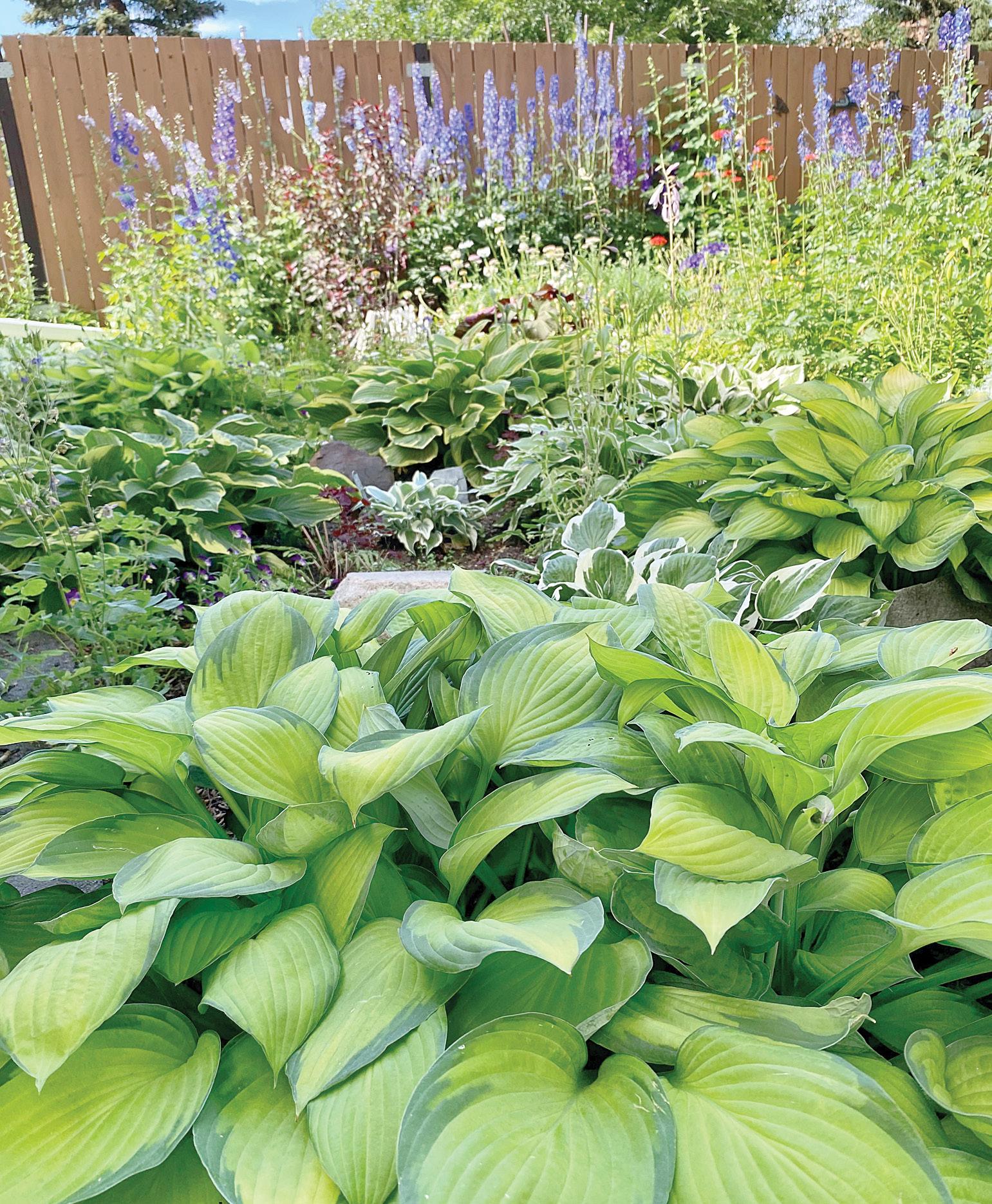


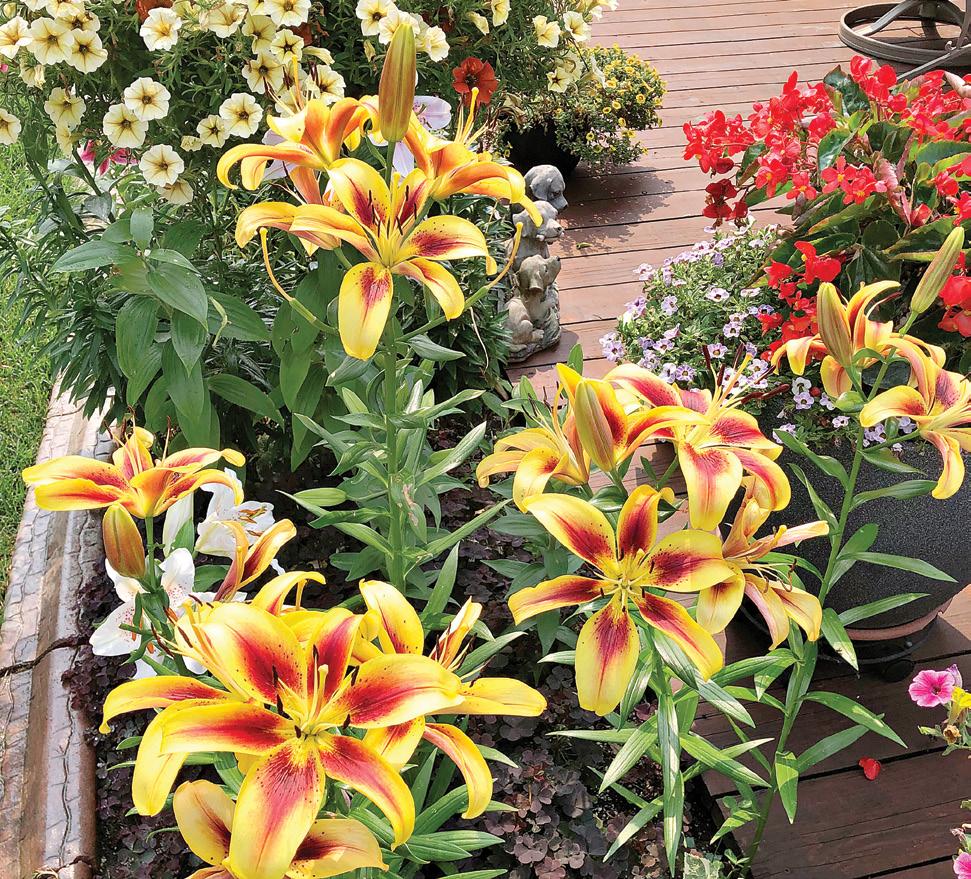
but the hostas have outlasted most of the others. The willow tree came from a friend who gave me a branch that was planted sideways and grew into a multi-trunked tree. The poplar was planted because I wanted a tree that would grow fast. That it did, including the troublesome roots! The trees do cap off the yard to make it feel more country-like, but have required professional pruning several times.
The focal point of the front yard is a Japanese lilac tree with perennials, evergreens, shrubs and petunias lining the driveway with a backdrop of evergreens against the house. There are planters hanging off the fence by the driveway leading from the front to the back garage with more pots of flowers grouped at the end.
Our children Kerri, Colleen and husband Garry, family and friends have enjoyed many backyard gatherings. One of our family stories starts with Frank dropping me off at my university campus office. As I
was getting out of the car, Colleen, who was three years old at the time, exclaimed “Mom you forgot your hoe!” She had only ever seen me working at home in the house and yard and had never been inside my office at work where the “tools of the trade” were quite different!
When Kerri turned 16 years old, we surprised her with a backyard birthday party with her friends and a new portable fire pit, which is still used to this day. Grandchildren Izzy and Charlie use the open green lawn space to play games and have fun. A basketball stand has recently been added in the back, which could prove to be a danger to some plants, but it’s for the grandchildren.
Tucked away around the yard are remembrances from the farm I grew up on, which had been in the family for 100 years when it was sold. These relics include bricks from the original chimney, rocks from the fields, crock jugs, wicker plant stand, bird bath, bird feeder, steppingstones from Mom’s garden and her big crock pot including the big white rock used for making sauerkraut. The gardens have become a special place for everyone; we feel our roots while caretaking those that continue to grow and those yet to be sown. h

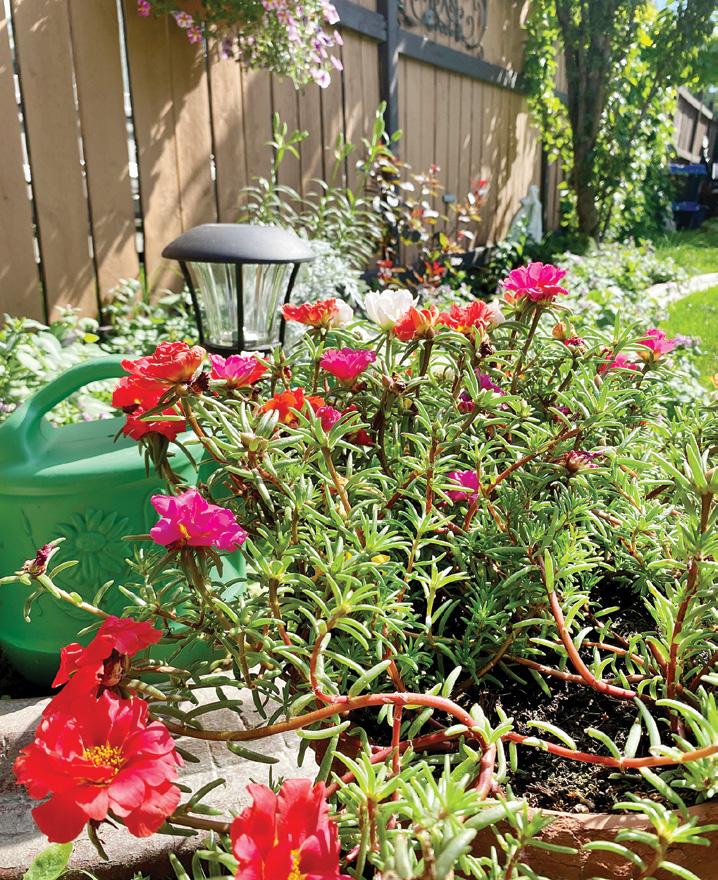


Toronto
storyand photos by
Gail m murrayJoin
me as we tour the Toronto Botanical Garden. There is ample parking and the gardens are serviced by bus. At the entrance, notice the dolomite elephant by the living green sculpture of Cornelian cherry and purple beech.
Stroll down the Entry Garden designed by Dutch nurseryman Piet Oudolf whose new wave planting style combines perennials and grasses. Their rhythmic swaying adds drama to this sophisticated meadow. Bees love the coneflowers and catmint. In spring, bulbs reign, drifts of iris, tulips and daffodils; peonies are queen in June and by July it feels like you are wandering through a meadow among fluttering monarchs. There’s a structure to the tour yet blooms are ever changing.
Open the black wrought iron gates and enter Floral Hall Courtyard to thrill your senses. Hear water ripple down the water curtain, see mauve wisteria and trimmed boxwood, smell fragrant David Austin roses,
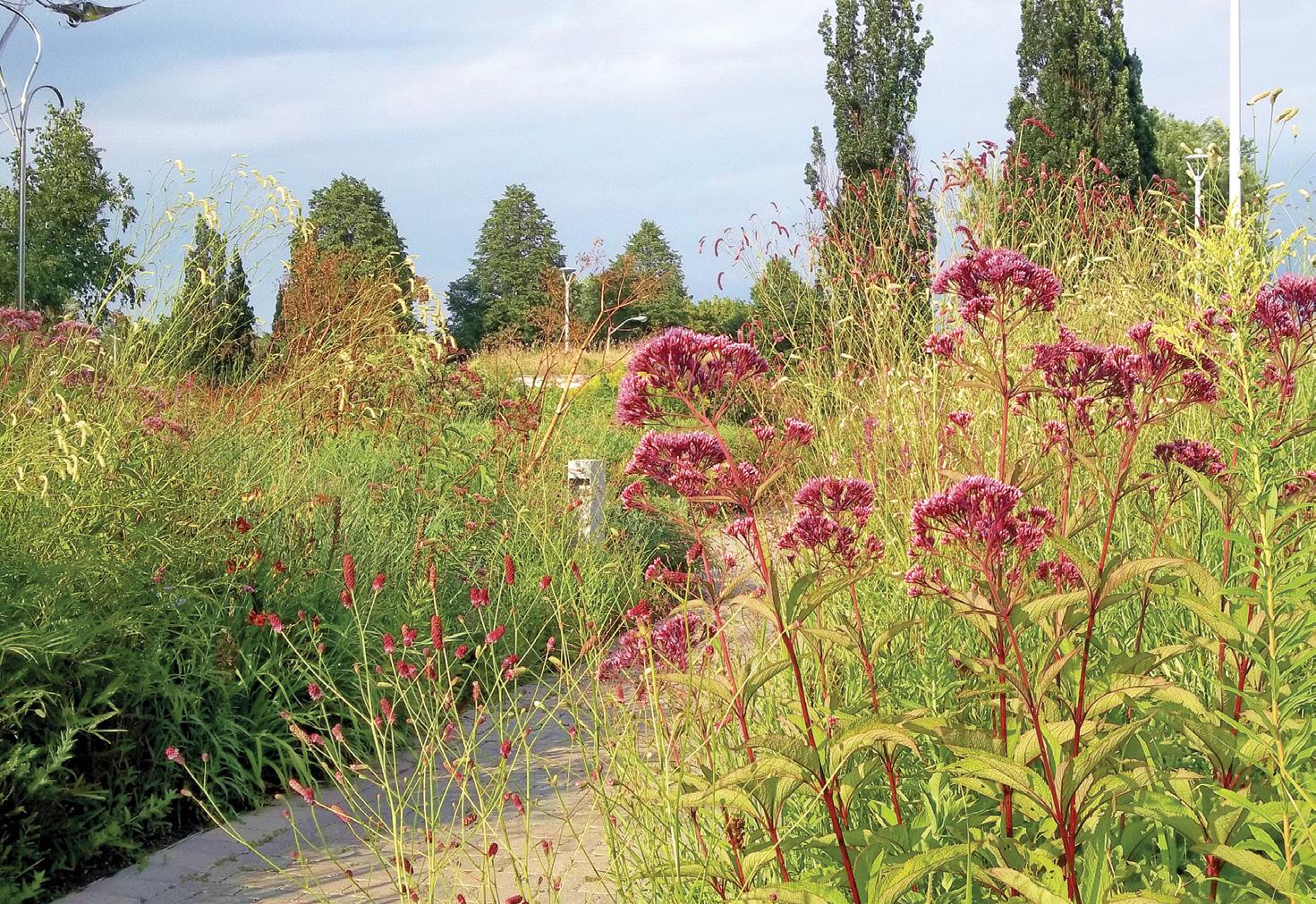

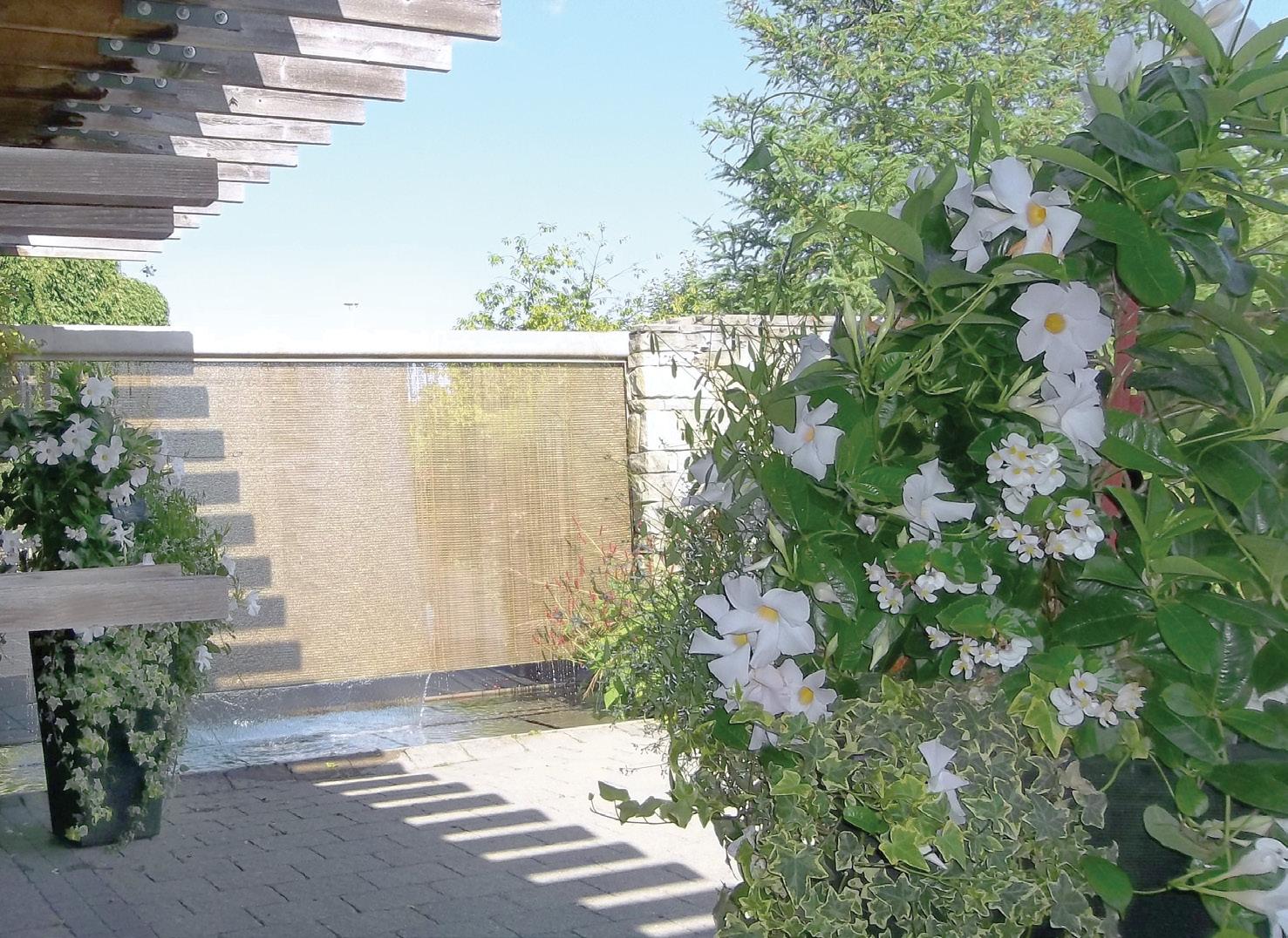
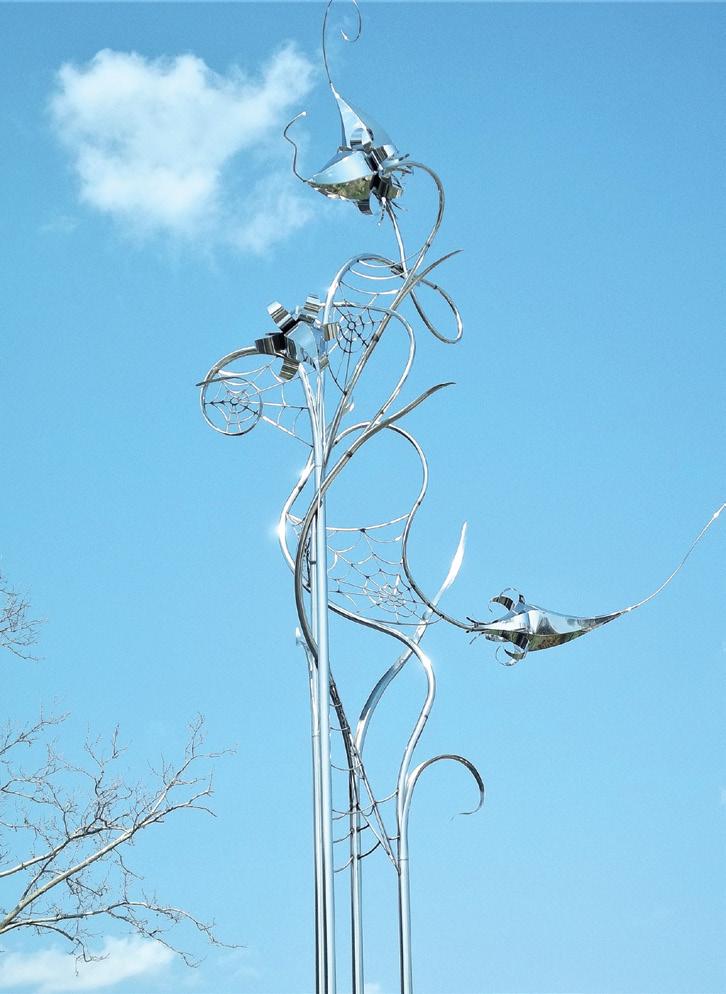
touch fuzzy lambs’ ears and soldier straight horsetail, enjoy the peace and serenity of a green and white palette. The main building houses offices, bathrooms, a large auditorium (lectures, plant sales, and wedding receptions), teaching classroom, an eclectic gift shop, and the largest horticulture library in Canada.
Wander Westview Terrace, a sheltered area with aromatic plants (viburnum, daphne, lavender), delicate faerie roses, a waterfall and water channel to soften the cool hardscaping of the paved courtyard. Sculpture, long a tradition in formal French and Italian Renaissance gardens, is becoming popular in North America. In 2018, Toronto Botanical Garden hosted Zimsculpt, a small business, displaying over 100 pieces of hand carved stone from Zimbabwe. A sleek heron stands tall in the Westview Terrace. The Garden Web, a stunning nine meter high stainless steel modern sculpture by Ontario College of Art graduate Ron Baird, gleams against the brilliant blue, a piece of whimsy and imagination.
The Knot Garden demonstrates the formal art of shaping and pruning plants, mostly boxwood, Japanese yew and privet, into geometric patterns. These formal gardens were popular in 17th and 18th century France, particularly in the gardens of the palace Versailles and the Gardens of Love at Chateau Villandry in the Loire Valley.
Continue walking to the wooded area at the end of the Carpet Beds. Here members of the Milne family lie at rest in a private cemetery. The Milnes were Scottish settlers who farmed this area beginning in 1817 and ran a mill on Wilket Creek. In autumn it’s magical

to descend the winding pathway through the forest of golden maples to the creek in the valley. Feel like a hike? To your left you can leave the park and follow the path along the creek and woods, walking all the way across the city to Sunnybrook Park. This little hike takes about an hour. Upon return, enjoy the rushing waterfalls, mallards, rock garden and in June, rhododendrons dancing in the dell. But I’ve diverted from my set tour.
From the Carpet Beds, head to Rupert Edward’s original barn (now a café) and stables. In summer, free concerts are held in this large courtyard. The music varies from jazz to rock and roll to flamenco.
Donated by the Toronto Historical Society, the bronze plaque delineates the early history of Edwards Gardens. Rupert Edwards purchased the property of 31 acres in 1954 to fulfill his dream of a country estate with wide open spaces. Calling it Springbrook Farm, he set about creating one of the finest landscape gardens in Toronto, including a nine hole golf course and rockery of Credit Valley stone to prevent erosion. Ten years later, when developer EP Taylor was creating Don Mills, one of the first subdivisions, Taylor offered Mr. Edwards $500,000, a huge sum at the time. Fortunately for us, Mr. Edwards sold his property to the city of Toronto for $150,000 with the stipulations his name would remain and it would always be free.
When the Edwards home burned down in 1962, up and coming architect Raymond Moriyama was chosen to design a shelter on the foundation of the former home – a shady respite and perfect vantage point to view the valley. Japanese tea house and west coast
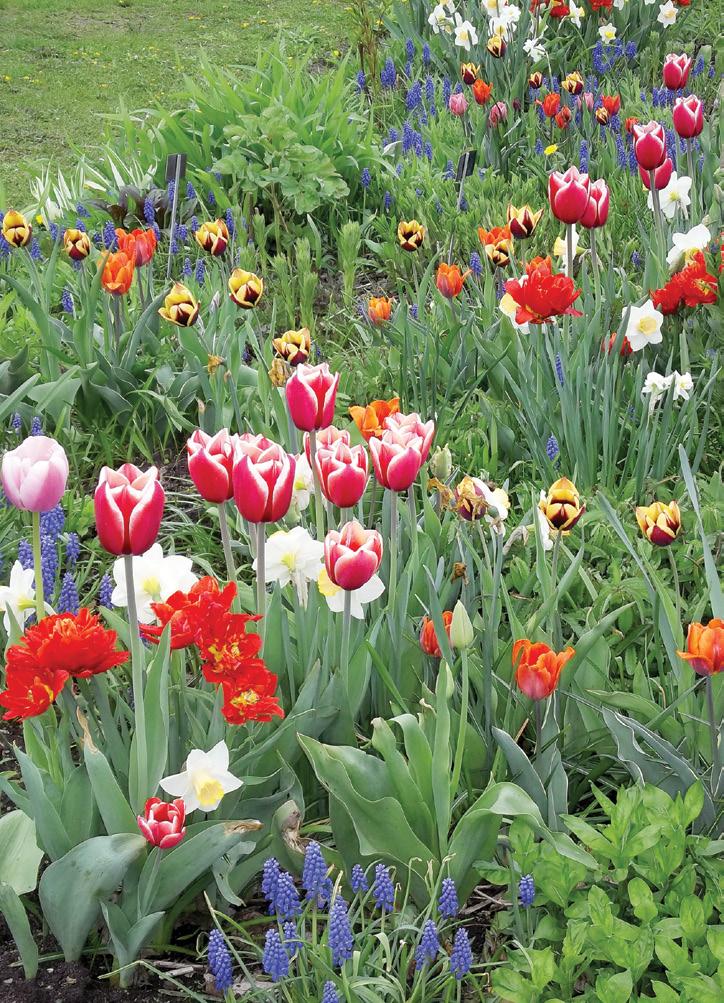
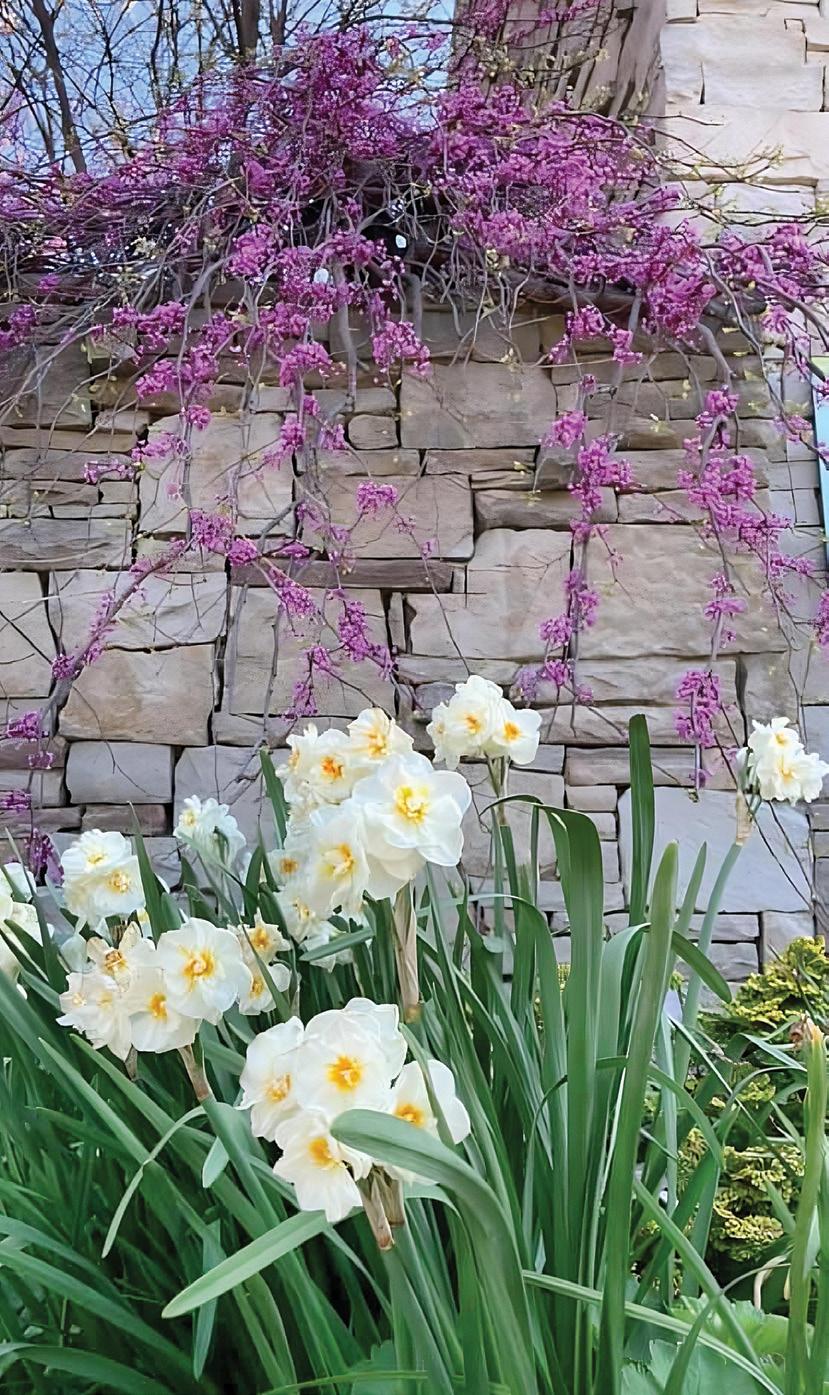


themes are evident in his design. Moriyama went on to create the Civic Garden Centre, which houses the Toronto Botanical Garden staff, as well as the Bata Shoe Museum and the Ontario Science Centre.
The charming fountain and stonework by the towering willow trees are the creations of Len Cullen who later developed Weall and Cullen Nurseries (now Sheridan). Len’s son, renowned garden writer Mark Cullen, is an honorary patron and huge supporter of TBG. Mark launched his book, Escape to Reality, here in 2018. We were fortunate to have Paul Zammit, TV, radio personality and super garden guru, as our Director of Horticulture for over ten years. Paul is currently teaching at Niagara College.
In addition to fabulous gardens, TBG offers horticulture courses, a hands on teaching program for young students, various events such as book launches, craft shows, yoga in the garden, plant sales and Through the Garden Gate – a most exquisite garden tour spotlighting a different area of the city each year.
To learn more or sign up for a tour, visit www.torontobotanicalgarden.ca. Whether you join a guided tour, stroll quietly through the gardens, sit under a tree to read, take a class, or meet a friend for cappuccino in the courtyard – enjoy the beauty and the respite.
Note: After retiring from teaching, Gail became a volunteer tour guide at Toronto Botanical Garden. h
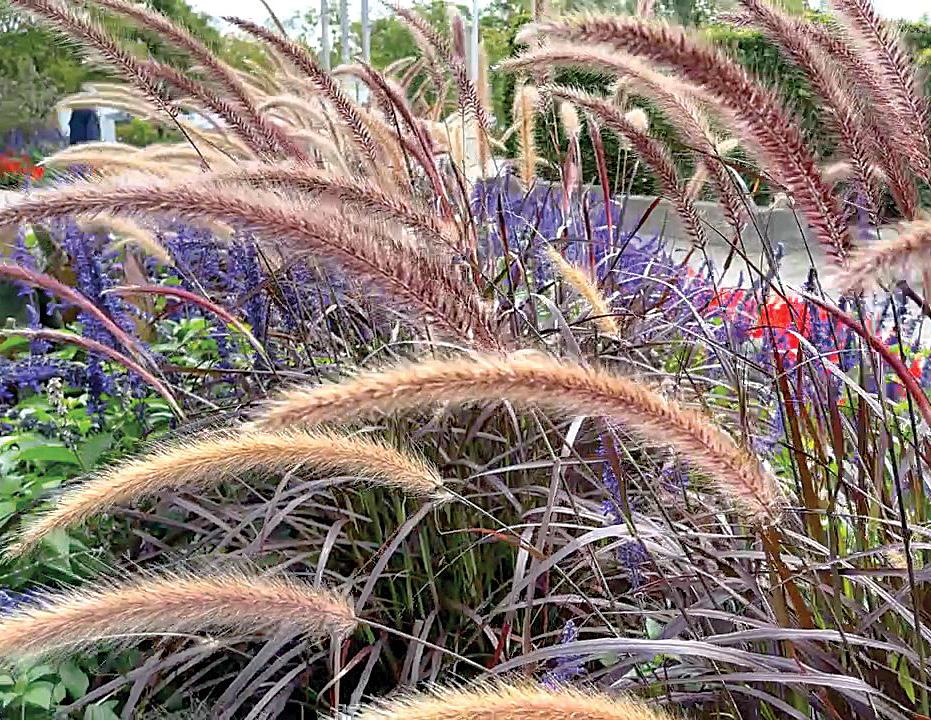

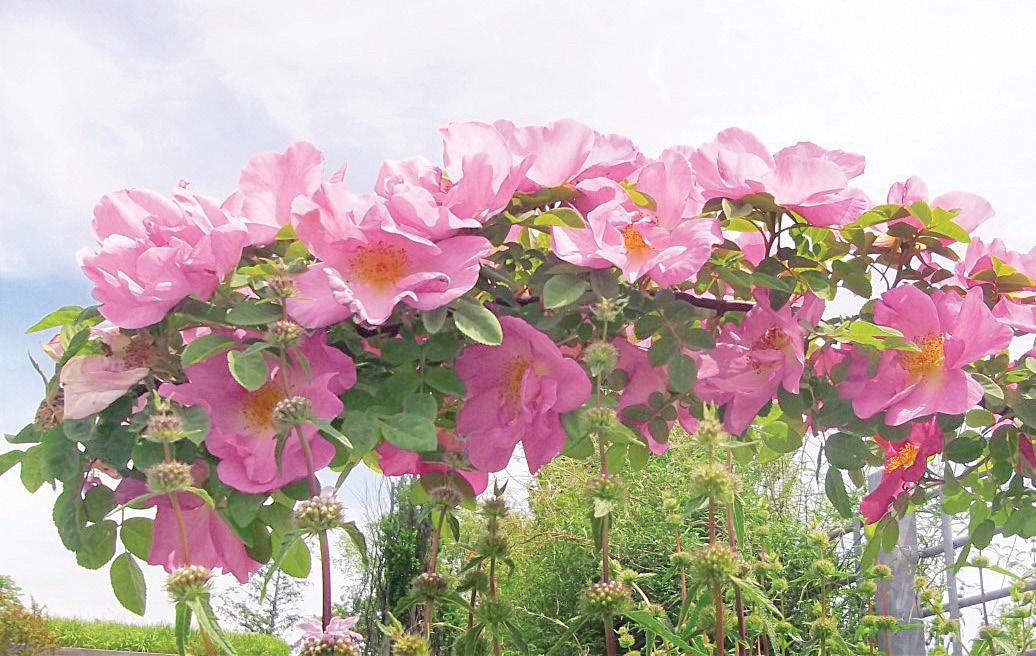
Secret Garden
by Gail MurrayThe child in me cannot resist touching feathery branches of the Larch opening tall black gates entering Floral Hall Courtyard. Not to me… my secret garden, not unlike Burnett’s hidden garden Escape the crush of traffic on Lawrence strollers that nip at heels like vixens
giddy youngsters running round and round the spiral mound.
Transparent etched glass walls welcome espaliered cherry trees keep tour groups at bay.
Perhaps I’ll meet a bride dreaming of elegant nuptials made magic by candlelight reflected off pale blooms in soft evening glow. Listen, water trickles down the water curtain
over silvery chain mail collects in a quiet pool fragrant David Austin roses perfume humid summer air.
Touch, brittle horse tail rushes standing warrior straight ancient mauve wisteria slowly climbs rigid grey Credit Valley stone Bend low pet the woolly lamb’s ears run your fingers against lavender whose oil scents and soothes. Linger.

event

Succulents are definitely trending and it's no surprise why! Their captivating shapes, textures and easy-care requirements continue to win over the hearts of Canadians. Their flexibility makes them ideal for container gardening, enabling you to craft displays both indoors and outdoors all year (although maybe not outside during those cold Canadian winters!). Whether you’re a gardener or just getting started here's a rundown of the top succulent container design trends and ideas tailored to the Canadian climate.
Embracing the miniature trend
Overcome space constraints with the “mini garden” craze. “Miniature gardens offer a way to bring the charm of succulents into areas,” notes Jennifer Lasko, Principal Designer at Modpots, a small-space garden design company based in Victoria, BC. Consider geometric containers
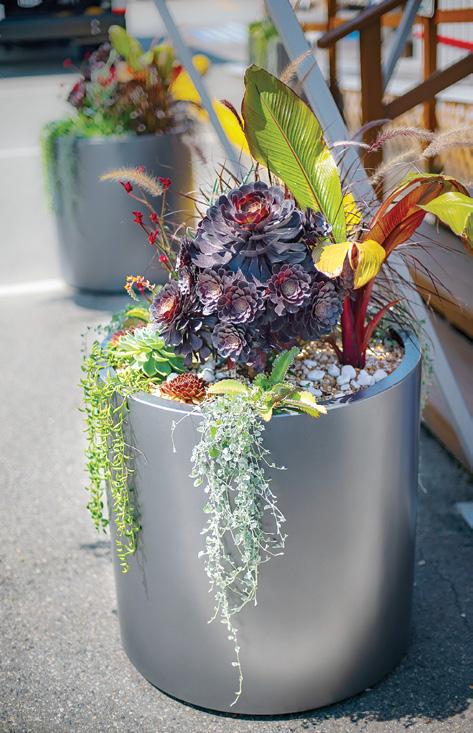
and tiny clay pots to create an expressive mini ecosystem.
Harmony in texture and colour
Succulents come in multiple hues. Explore an array of colours ranging from blues and deep purples to vibrant reds and oranges. “Succulents are like pieces of coral. Each one is fascinating. Don't shy away from experimenting with colours and textures,” advises Lasko. Pair aloes with haworthias or mix cool toned succulents with warm toned planters to create a vibrant display. “I usually opt for high contrast plant colours to really make them stand out. Think black and yellow or maybe red. Incorporate a variety of textures and leaf shapes to make your display truly stunning!” suggests Lasko. You can also consider adding contrasting textures like pebbles or decorative stones from the surroundings to add depth and visual appeal.

Embracing natural elements and sustainable options
Canadians have a love for nature, which can be reflected in your choice of succulent containers.
“Natural materials such as terracotta and stone planters bring a charm that complements the natural beauty of succulents,” Lasko mentions. “These materials also provide drainage, which is crucial for preventing root rot in our sometimes damp climate.” Explore ecofriendly options like recycled materials or sourced planters to enhance sustainability in your container garden.
Modern aesthetics with geometric designs
Sleek lines and geometric shapes are popular in design trends, including when it comes to select-
Looking for some inspiration to get your creativity flowing?
Here are a few container ideas to kickstart your gardening journey. Embrace the rustic charm. Match terracotta pots in sizes, with echeveria, haworthia and sempervivum plants for a natural touch. Sprinkle some gravel on top for that flair. Opt for modern minimalism. Choose a ceramic planter and fill it with Aloe striata, Crassula ovata (jade plant) and string of pearls succulents for a contemporary vibe. Keep your decor around simple and monochromatic to tie everything together.


Check out this link to the Modpots instagram page and see succulent designs by Jennifer Lasko.

https://www.instagram.com/modpots/
ing containers for succulents.
Lasko suggests that incorporating planters, square pots with edges and tiered planters can bring a contemporary feel to your space while also emphasizing the beauty of your succulents through negative space. To enhance the design aesthetic, think about introducing patterns in the surrounding area such as patterned rugs or wall art.
Add a mini-natural touch. Get creative by using tiny clay pots to bring some nature into your small space. Plant them with succulents like jade necklaces or burro’s tails for a twist on your windowsill or bookshelf.
Go vertical with your garden. Utilize hanging or tiered planters to make the most of your space. Try cascading succulents such as a string of pearls or burro’s tail for an eyecatching arrangement. This vertical garden setup works wonders in balconies, patios or cozy indoor corners.
When it comes to choosing succulents and containers in Canada it's essential to consider the climate. In milder regions like Vancouver Island some succulents may still require indoor shelter or protection from freezing temperatures. In other areas, prioritize hardy varieties like hens and chicks and sedums in well-draining containers that can be moved under eaves or indoors before winter sets in.
In higher zones, you have flexibility in selecting a broader range of succulents. Using frost blankets or cloches is advisable to shield your larger container gardens during cold spells particularly during transitional seasons.
Now, onto the fun part – planting! Here are some suggestions, for creating a balanced arrangement:
Remember Jennifer Laskos words, “I have always thought of container gardening as adding a fabulous pair of shoes to a great outfit! Once you’ve reached a point where your garden brings you joy and satisfaction, it’s time to add those touches, the details that truly make it shine!”
Consider incorporating elements such as pebbles, pieces of driftwood or trendy preserved moss to give your garden a personal touch. Remember, there are no rules, let your own style and the unique features of your garden guide you.




Three pots have plants that are similar but different.
Start with a “rock-star” plant: “Choose one taller ‘wow’ succulent such as a large agave or aeonium,” recommends Lasko. This will be the focal point of your design. Add layers for visual interest. Next incorporate echeveria plants followed by trailing varieties such as string of pearls or string of dolphins. This layering technique adds depth and dimension to your container. h
Founded in 2012, Modpots is a small space garden design company based in Victoria, BC. Explore Jennifer’s latest planter designs, on instagram.com/modpots.
Ensure drainage. It’s crucial to have drainage holes in your containers to prevent water accumulation. Consider placing a layer of gravel or broken pottery at the bottom of the pot for drainage.
Consider sunlight requirements. While most succulents thrive in the sun some may prefer shade especially during peak heat hours. Research the preferences of your chosen succulents and position them accordingly.
Water wisely. Succulents store water in their leaves. It’s important not to overwater them. Water deeply but infrequently allowing the soil to dry out completely between each watering session.
Ihave had all winter to dream about the shady side of the front yard and now I am ready to build it.
My Winnipeg yard, where we’ve lived since moving here a year and a half ago, is reasonably big for a city yard – at least, it’s a lot bigger than the one we left behind in Toronto. (Toronto: 16 by 100 feet; Winnipeg: 60 by about 150 feet.) Last summer I put in a vegetable plot, foolishly, while my husband was out of town for two weeks. It measures about 16 feet by 20 feet, kind of triangular but jutting out along the hypotenuse.
I made the vegetable garden by putting down (some) newspaper and loading 6 inches of five-waymix soil on top, then planting and applying about 2 inches of shredded bark mulch. I didn’t feed the garden because the soil was new and contained 10 percent compost. It was really successful.
This year, I’m doing an ornamental plot of about 18 feet by 13 feet. My house faces north and it’s on one side of the lot. I found it incredibly difficult to lay down newsprint and keep it there while I watered it in windy Winnipeg so this year I decided to lift the sod. I thought that would be easier.
Hah.
When I couldn’t push the shovel through the ground below the grass more than a couple of inches, I rented a sod cutter. Which did not fit in our car. My husband was with me for the ordeal, though, so we got it in (took the handles off) and brought it home. Then he lifted the sod for me. Then he shoveled it off the ground because it didn’t stick together because it
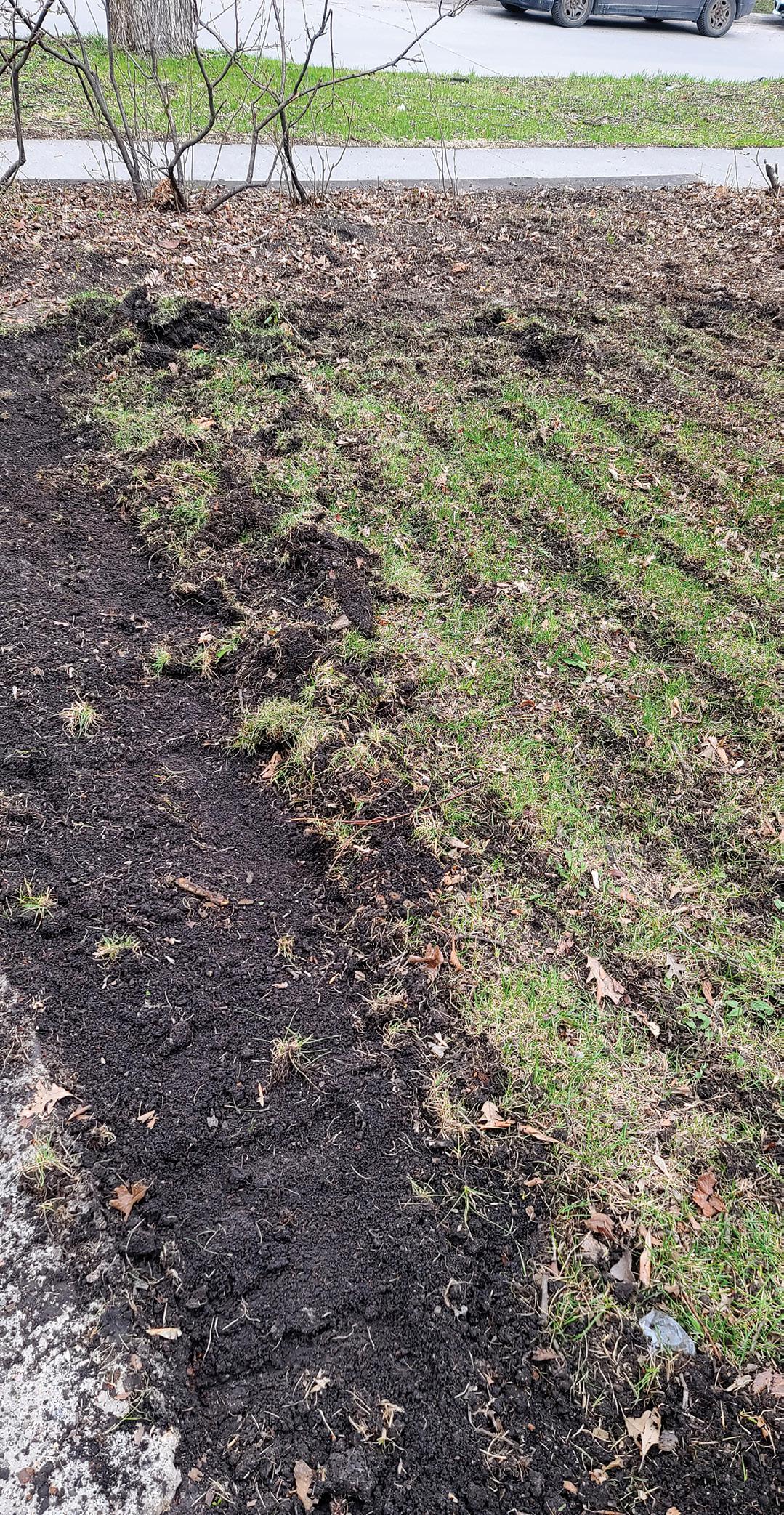

wasn’t soddy enough, having spent last year in so much shade with so little care. I love him.
This is the yard in front of the house. Last year, there was a big old oak tree at the front corner next door, bordering on my yard. The neighbours cut it down (it was not in great shape), and to my surprise, it turns out there is quite a bit of sunlight that hits this shady side.
I have drawn a couple of pictures. I’m on a curvy kind of kick lately and the interior of this border is very curvy. A couple of years ago I did a story on building a labyrinth and the shape of the main path of this garden is kind of like that; it kind of swirls around. My husband has seen it and he approves. I wonder if he will still approve when we go to lay down the edging between the garden and the pathways!
I’ve smartened up this year and am putting in pathways that are a good 2 to 3 feet wide. Last year, the paths through my vegetable garden, which I had (I thought) smartly (it wasn’t) “installed” by putting down roofing shingles, did not really work and I’m still finding and pulling out weathered bits of shingle. At 18 inches, it wasn’t wide enough anyhow, not for someone who thought only the roots of the tomatoes had to stay within the bounds. The shingles were cheap, at least.
For the shady front we are going to install edging on the bare surface, landscape cloth where the paths will be, pea gravel for paths, and 3 inches of soil everywhere else. And shredded bark mulch after planting, of course.
I have bought three hostas so far and am planning to find Joe Pye weed, ligularia, heucheras, Canada anemones, Lady’s mantle, sweet woodruff, brunnera and astilbes. I may have to fill in the garden directly in front of the house, where hostas and ferns have been growing, and the garden down by the street, where there are some scraggly shrubs (I think they are aronia) that should start to fill out now the oak is gone. The 6 feet near the street was – and will be again soon, I’m sure – filled with weeds and horrible striped ribbon grass. This will be a challenge. Maybe I should put in some short-rooted groundcover to fight it but leave the shrubs alone.
Along one side of this area is the front walk. My mom thinks I should
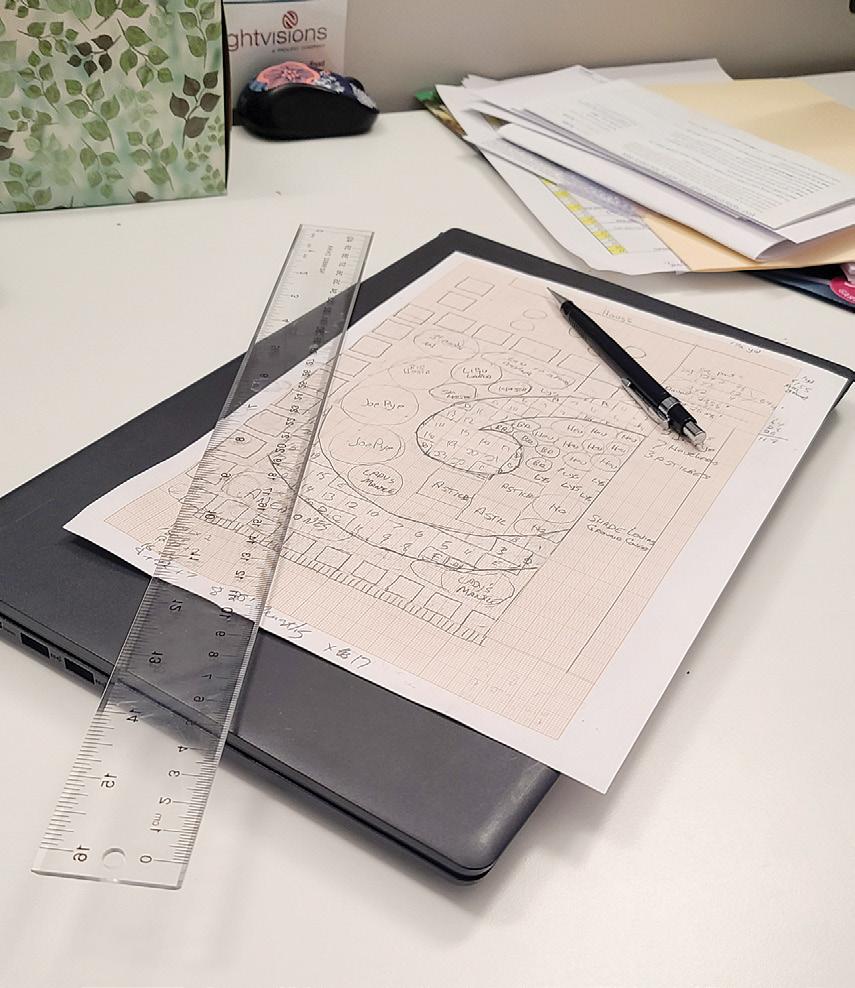
plant a strip of sod along it, but I am not about to fight more grass in this garden. I like a lawn; it’s restful for the eyes. There is plenty on the other, larger side of the front yard.
Along the other side of my gardento-be is a hedge of old-growth lilacs that haven’t bloomed since we’ve been here. (Maybe with the oak gone….) These lilacs haven’t been paid much attention and, consequently, they’ve

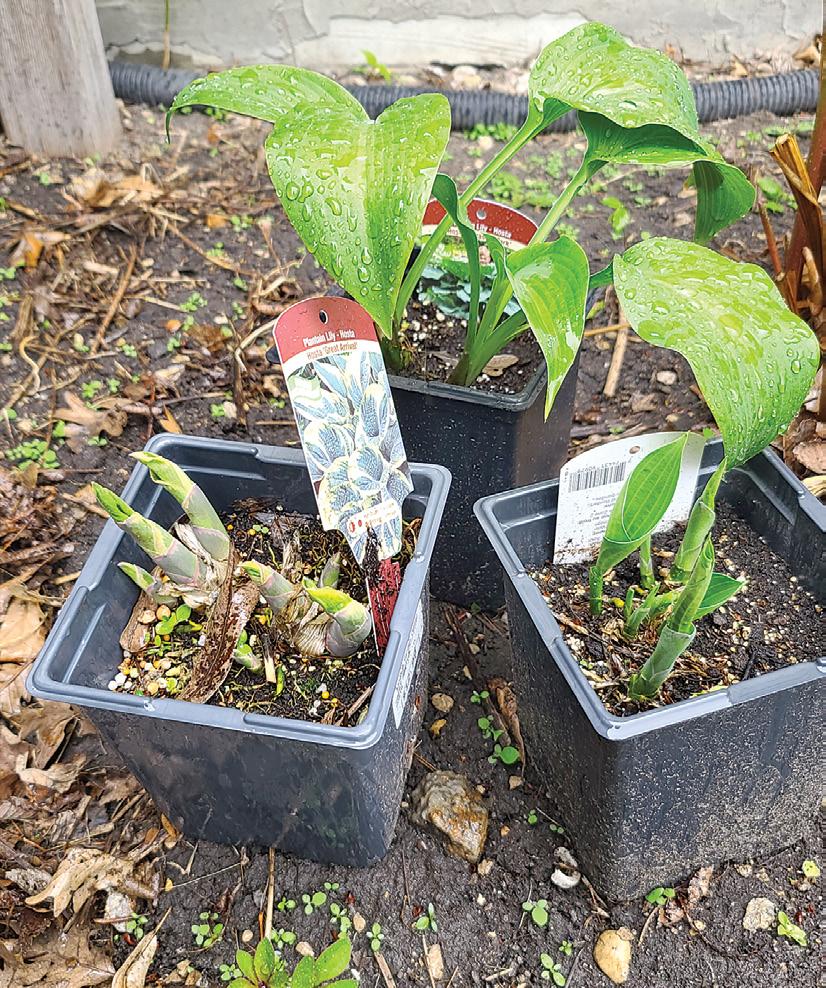
been pushing roots a few feet into my new garden. Another thing I’ll have to battle.
I’ll be putting a straight pathway along the hedge, to continue along the front of the old garden of hostas and ferns, and along the old garden of scraggly shrubs. Additionally, I’ll put in a curved bit of path between the main curvy path and the front, based on the understanding that
you need to have access to all of the plants.
And so, tomorrow a big truck will come with 3 yards of soil, 2 yards of mulch, and 1 yard of buckshot gravel. They’ll dump it in the back driveway and this weekend our chore will begin.
Oh, and my husband is going out of town for a few days next week, right in time to haul all the soil and gravel! h


Garden: Exploring the Horticultural World is a beautiful new book of older things published last year by Phaidon in the United Kingdom. The book tells the history of gardening through paintings, prints and photographs. Here is one of the entries:
Christophe Guinet (Monsieur Plant) Plant Your Mac!, 2020 (Mixed media, 23 5/8 inches by 12 5/8 inches)
Inside the hollowed-out screen of a late 1990s Apple Macintosh computer, the artist Christophe Guinet (born 1977) has created a terrarium garden featuring Venus fly traps and sarracenia that raise their trumpet pitchers to a clear blue sky formed of the computer’s translucent plastic shell.
Terrariums, transparent containers (usually of glass) in which plants are nurtured, allow controlled, precise grow-

ing conditions. Here, the computer’s case provides a humidity suited to the tropical flora chosen by the artist, while in other works from the series, green papyrus stems shoot upwards from the sleek silver tower of a G5 desktop computer and spiked cacti burst from between the buttons of another computer’s mouse.
As Guinet’s artistic moniker, ‘Monsieur Plant’, suggests, his creative practice holds nature as a central concern, and his series offers a commentary on the pervasive creep of computer technology into daily life. The choice of computer model for this piece is particularly apposite, since it was the success of the iMac G3, originally styled by British designer Jony Ive, that paved the way for Apple’s iPhone, hence signaling the beginning of a transformative new era of internet-ready consumer electronics.
Guinet’s terrarium literally disrupts the spectacle of cyberspace, conceiving capitalism’s objects of mass production as jungle-bound ruins and replacing the addictive entrapment of social media’s image culture – the irony of whose fixation with houseplants and terrariums is not lost on the artist – fittingly, with carnivorous plants. h
